Development of Malaria Information Portal for Urban Lokoja, Nigeria
VerifiedAdded on 2020/12/10
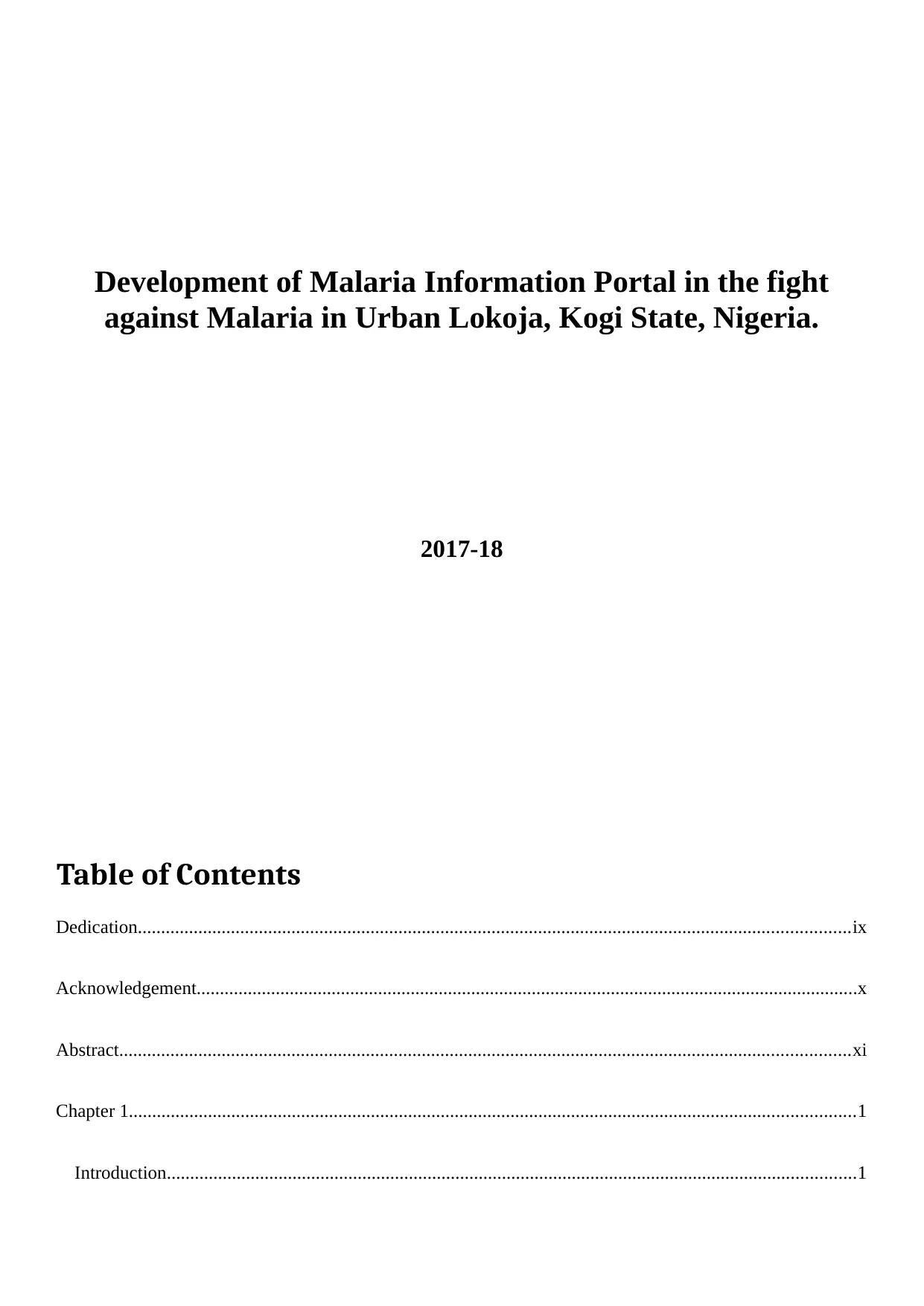
against Malaria in Urban Lokoja, Kogi State, Nigeria.
2017-18
Table of Contents
Dedication.........................................................................................................................................................ix
Acknowledgement..............................................................................................................................................x
Abstract.............................................................................................................................................................xi
Chapter 1............................................................................................................................................................1
Introduction....................................................................................................................................................1
Paraphrase This Document
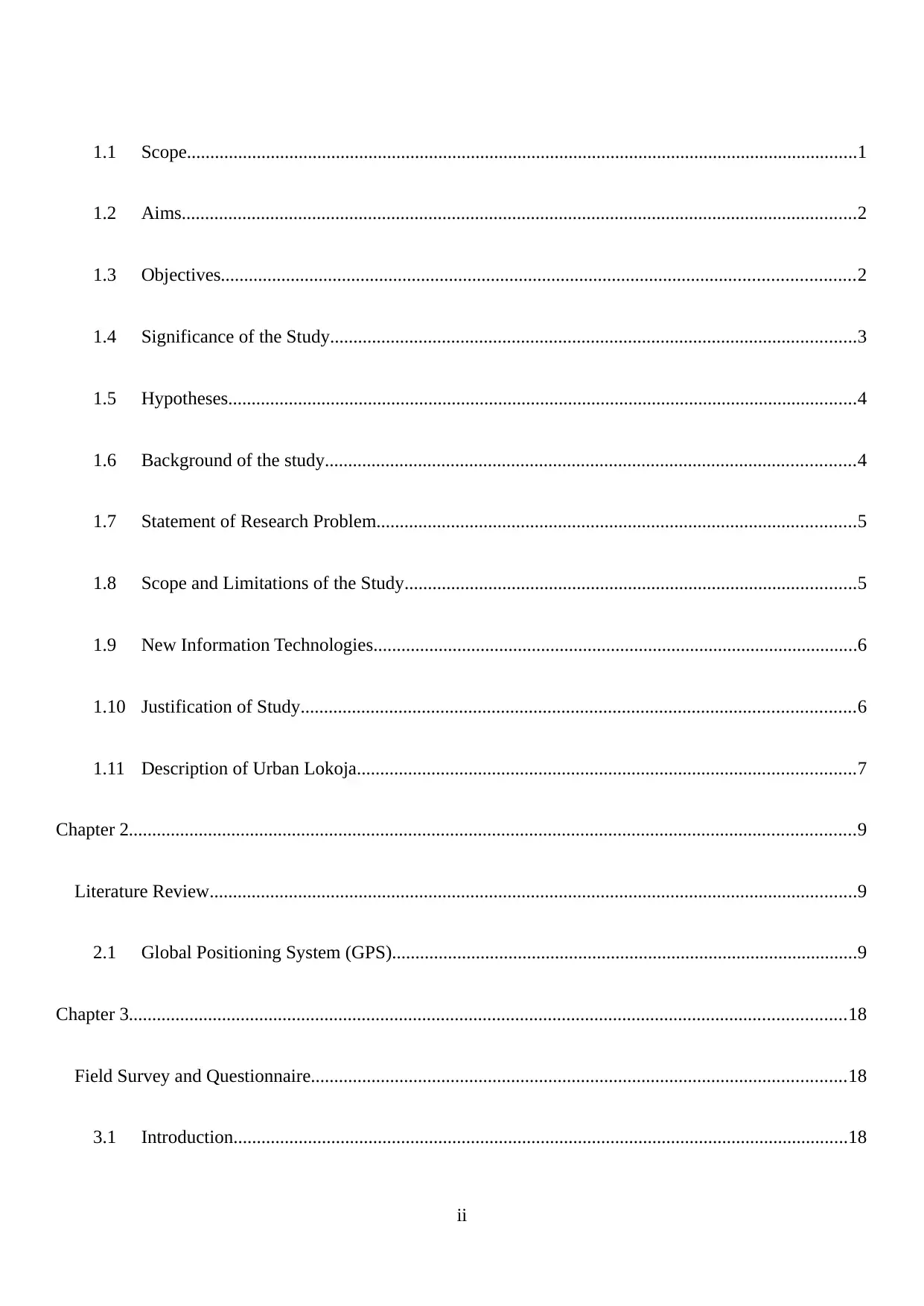
1.2 Aims.................................................................................................................................................2
1.3 Objectives........................................................................................................................................2
1.4 Significance of the Study.................................................................................................................3
1.5 Hypotheses.......................................................................................................................................4
1.6 Background of the study..................................................................................................................4
1.7 Statement of Research Problem.......................................................................................................5
1.8 Scope and Limitations of the Study.................................................................................................5
1.9 New Information Technologies........................................................................................................6
1.10 Justification of Study.......................................................................................................................6
1.11 Description of Urban Lokoja...........................................................................................................7
Chapter 2............................................................................................................................................................9
Literature Review...........................................................................................................................................9
2.1 Global Positioning System (GPS)....................................................................................................9
Chapter 3..........................................................................................................................................................18
Field Survey and Questionnaire...................................................................................................................18
3.1 Introduction....................................................................................................................................18
ii
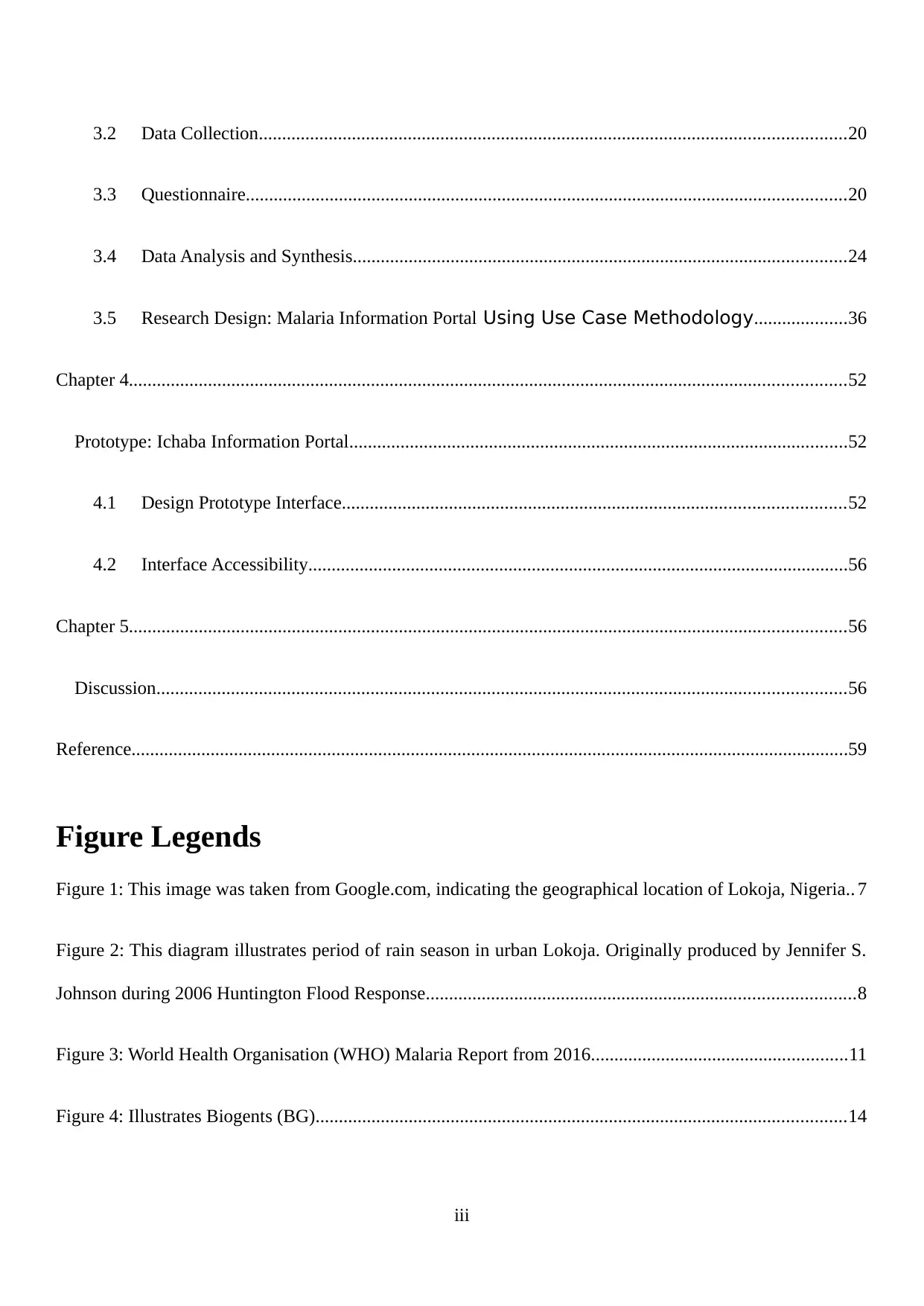
3.3 Questionnaire.................................................................................................................................20
3.4 Data Analysis and Synthesis..........................................................................................................24
3.5 Research Design: Malaria Information Portal Using Use Case Methodology....................36
Chapter 4..........................................................................................................................................................52
Prototype: Ichaba Information Portal...........................................................................................................52
4.1 Design Prototype Interface............................................................................................................52
4.2 Interface Accessibility....................................................................................................................56
Chapter 5..........................................................................................................................................................56
Discussion....................................................................................................................................................56
Reference..........................................................................................................................................................59
Figure Legends
Figure 1: This image was taken from Google.com, indicating the geographical location of Lokoja, Nigeria.. 7
Figure 2: This diagram illustrates period of rain season in urban Lokoja. Originally produced by Jennifer S.
Johnson during 2006 Huntington Flood Response............................................................................................8
Figure 3: World Health Organisation (WHO) Malaria Report from 2016.......................................................11
Figure 4: Illustrates Biogents (BG)..................................................................................................................14
iii
⊘ This is a preview!⊘
Do you want full access?
Subscribe today to unlock all pages.

Trusted by 1+ million students worldwide
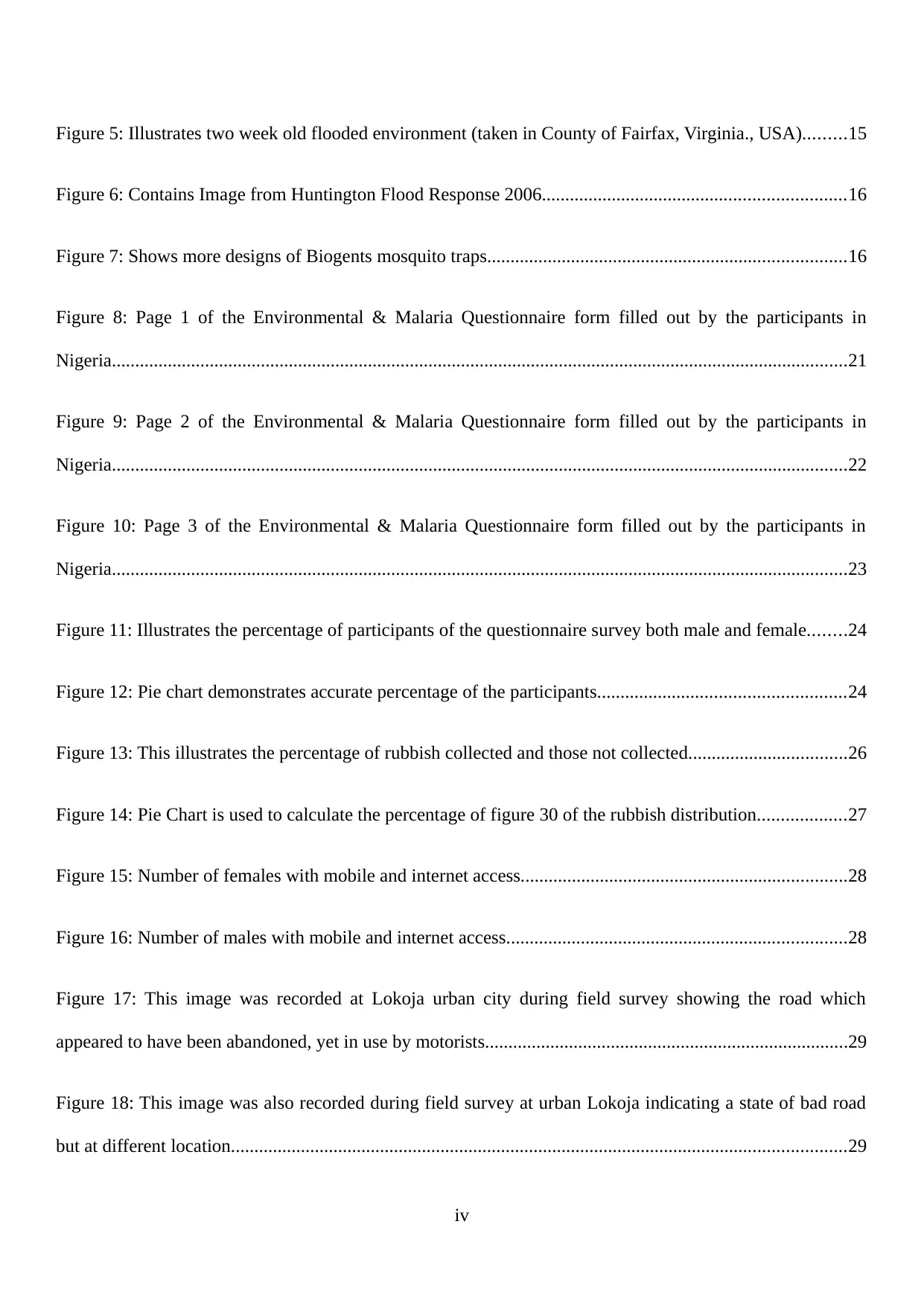
Figure 6: Contains Image from Huntington Flood Response 2006.................................................................16
Figure 7: Shows more designs of Biogents mosquito traps.............................................................................16
Figure 8: Page 1 of the Environmental & Malaria Questionnaire form filled out by the participants in
Nigeria..............................................................................................................................................................21
Figure 9: Page 2 of the Environmental & Malaria Questionnaire form filled out by the participants in
Nigeria..............................................................................................................................................................22
Figure 10: Page 3 of the Environmental & Malaria Questionnaire form filled out by the participants in
Nigeria..............................................................................................................................................................23
Figure 11: Illustrates the percentage of participants of the questionnaire survey both male and female........24
Figure 12: Pie chart demonstrates accurate percentage of the participants.....................................................24
Figure 13: This illustrates the percentage of rubbish collected and those not collected..................................26
Figure 14: Pie Chart is used to calculate the percentage of figure 30 of the rubbish distribution...................27
Figure 15: Number of females with mobile and internet access......................................................................28
Figure 16: Number of males with mobile and internet access.........................................................................28
Figure 17: This image was recorded at Lokoja urban city during field survey showing the road which
appeared to have been abandoned, yet in use by motorists..............................................................................29
Figure 18: This image was also recorded during field survey at urban Lokoja indicating a state of bad road
but at different location....................................................................................................................................29
iv
Paraphrase This Document
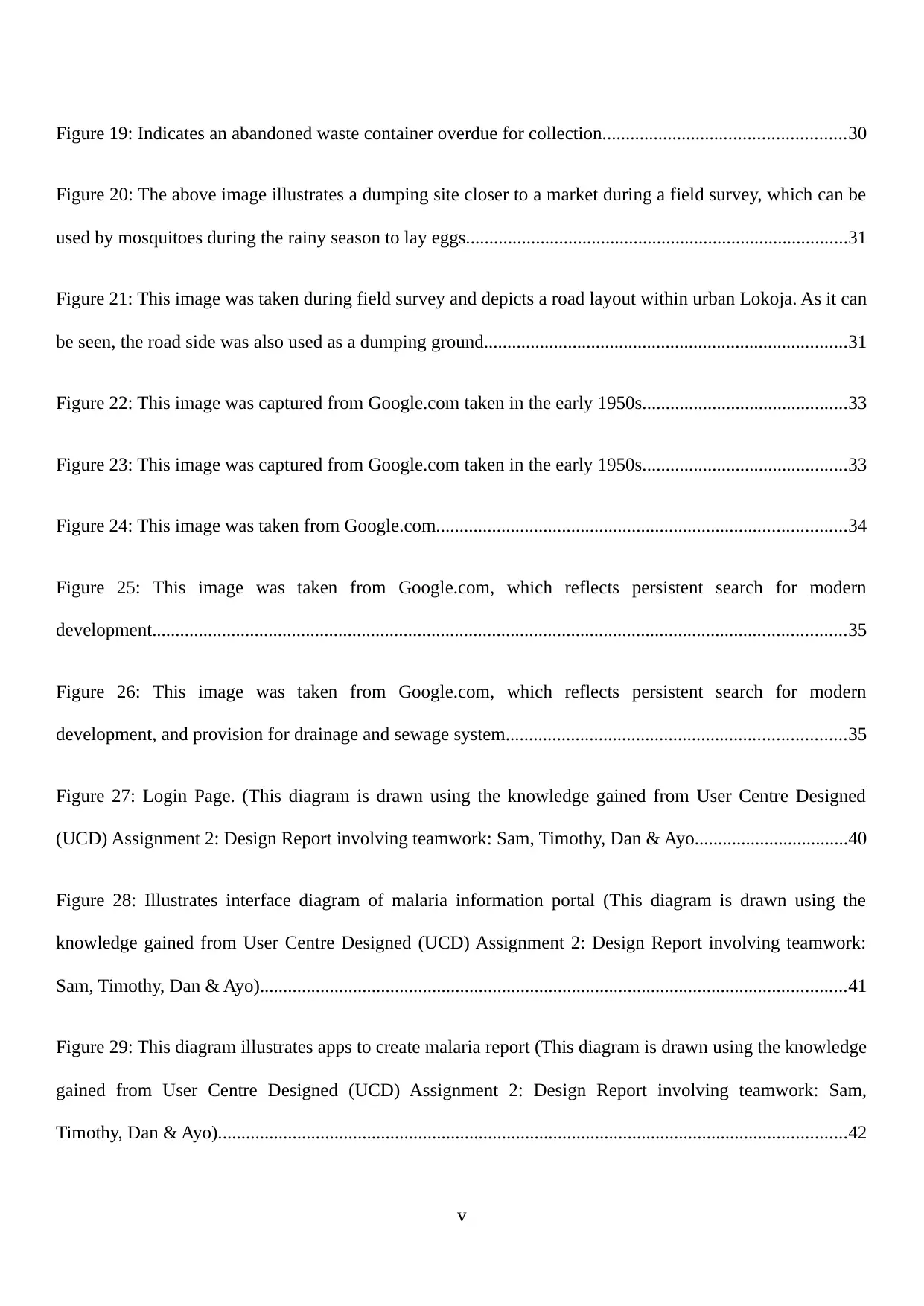
Figure 20: The above image illustrates a dumping site closer to a market during a field survey, which can be
used by mosquitoes during the rainy season to lay eggs..................................................................................31
Figure 21: This image was taken during field survey and depicts a road layout within urban Lokoja. As it can
be seen, the road side was also used as a dumping ground..............................................................................31
Figure 22: This image was captured from Google.com taken in the early 1950s............................................33
Figure 23: This image was captured from Google.com taken in the early 1950s............................................33
Figure 24: This image was taken from Google.com........................................................................................34
Figure 25: This image was taken from Google.com, which reflects persistent search for modern
development.....................................................................................................................................................35
Figure 26: This image was taken from Google.com, which reflects persistent search for modern
development, and provision for drainage and sewage system.........................................................................35
Figure 27: Login Page. (This diagram is drawn using the knowledge gained from User Centre Designed
(UCD) Assignment 2: Design Report involving teamwork: Sam, Timothy, Dan & Ayo.................................40
Figure 28: Illustrates interface diagram of malaria information portal (This diagram is drawn using the
knowledge gained from User Centre Designed (UCD) Assignment 2: Design Report involving teamwork:
Sam, Timothy, Dan & Ayo)..............................................................................................................................41
Figure 29: This diagram illustrates apps to create malaria report (This diagram is drawn using the knowledge
gained from User Centre Designed (UCD) Assignment 2: Design Report involving teamwork: Sam,
Timothy, Dan & Ayo).......................................................................................................................................42
v
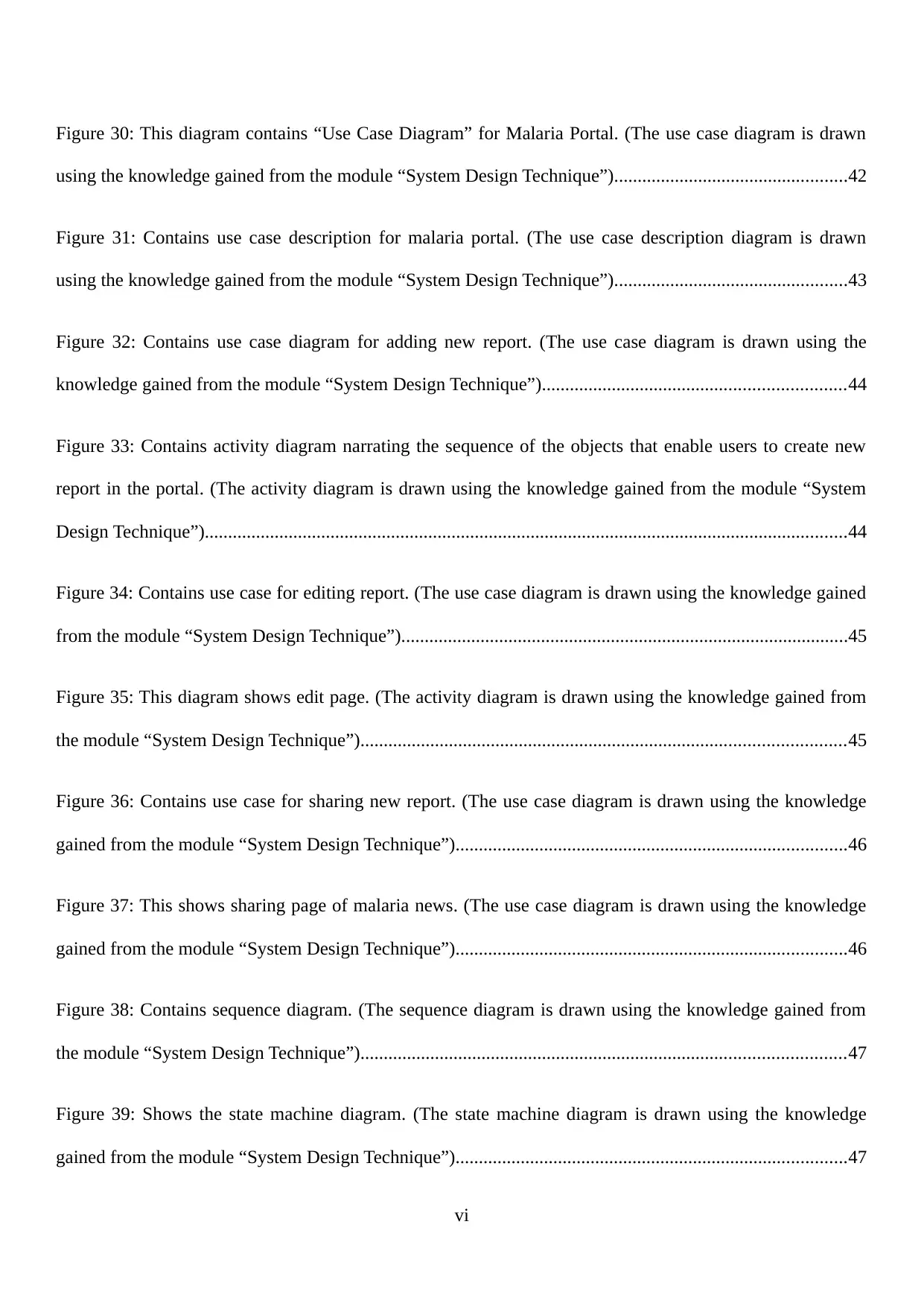
using the knowledge gained from the module “System Design Technique”)..................................................42
Figure 31: Contains use case description for malaria portal. (The use case description diagram is drawn
using the knowledge gained from the module “System Design Technique”)..................................................43
Figure 32: Contains use case diagram for adding new report. (The use case diagram is drawn using the
knowledge gained from the module “System Design Technique”).................................................................44
Figure 33: Contains activity diagram narrating the sequence of the objects that enable users to create new
report in the portal. (The activity diagram is drawn using the knowledge gained from the module “System
Design Technique”)..........................................................................................................................................44
Figure 34: Contains use case for editing report. (The use case diagram is drawn using the knowledge gained
from the module “System Design Technique”)................................................................................................45
Figure 35: This diagram shows edit page. (The activity diagram is drawn using the knowledge gained from
the module “System Design Technique”)........................................................................................................45
Figure 36: Contains use case for sharing new report. (The use case diagram is drawn using the knowledge
gained from the module “System Design Technique”)....................................................................................46
Figure 37: This shows sharing page of malaria news. (The use case diagram is drawn using the knowledge
gained from the module “System Design Technique”)....................................................................................46
Figure 38: Contains sequence diagram. (The sequence diagram is drawn using the knowledge gained from
the module “System Design Technique”)........................................................................................................47
Figure 39: Shows the state machine diagram. (The state machine diagram is drawn using the knowledge
gained from the module “System Design Technique”)....................................................................................47
vi
⊘ This is a preview!⊘
Do you want full access?
Subscribe today to unlock all pages.

Trusted by 1+ million students worldwide
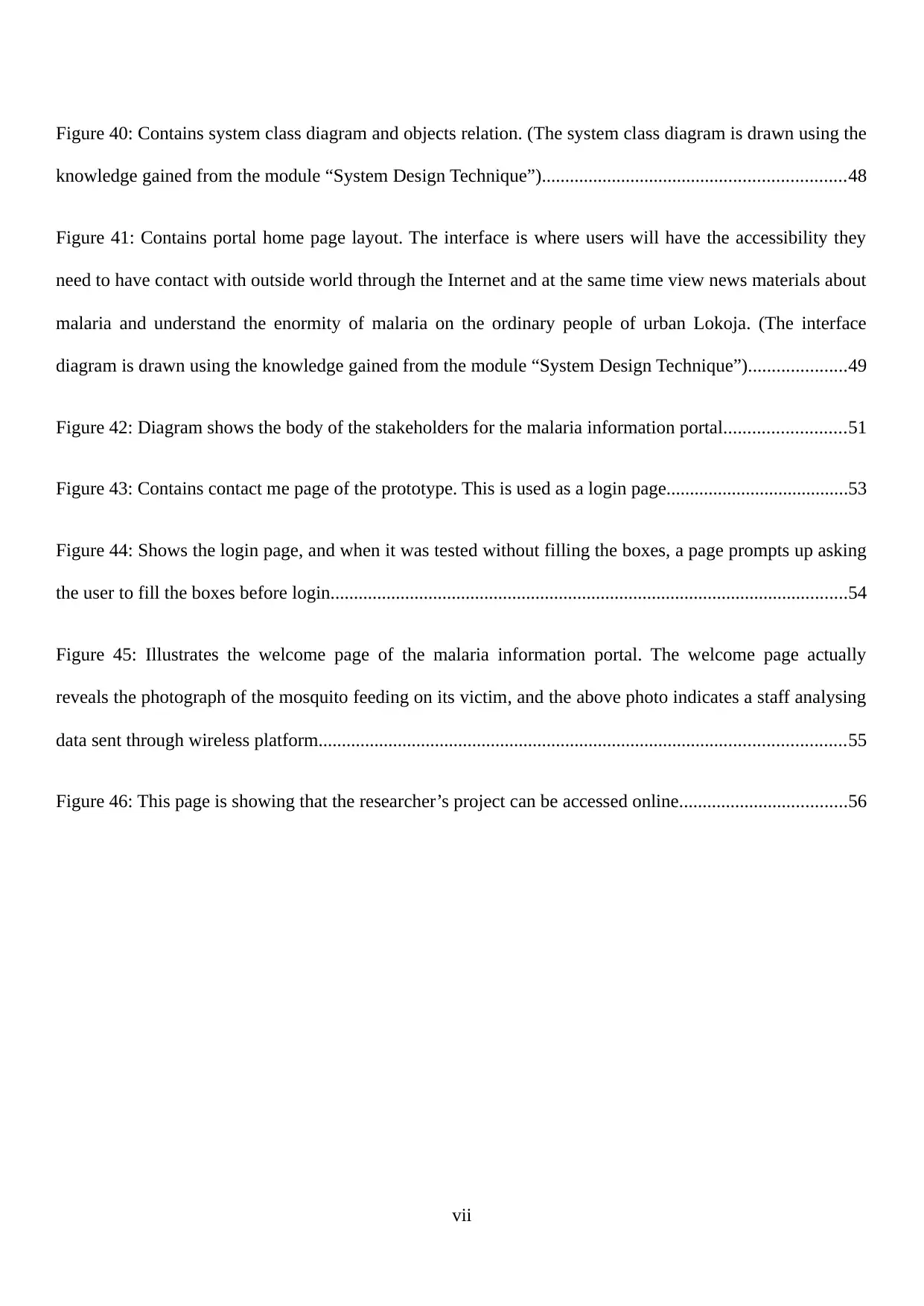
knowledge gained from the module “System Design Technique”).................................................................48
Figure 41: Contains portal home page layout. The interface is where users will have the accessibility they
need to have contact with outside world through the Internet and at the same time view news materials about
malaria and understand the enormity of malaria on the ordinary people of urban Lokoja. (The interface
diagram is drawn using the knowledge gained from the module “System Design Technique”).....................49
Figure 42: Diagram shows the body of the stakeholders for the malaria information portal..........................51
Figure 43: Contains contact me page of the prototype. This is used as a login page.......................................53
Figure 44: Shows the login page, and when it was tested without filling the boxes, a page prompts up asking
the user to fill the boxes before login...............................................................................................................54
Figure 45: Illustrates the welcome page of the malaria information portal. The welcome page actually
reveals the photograph of the mosquito feeding on its victim, and the above photo indicates a staff analysing
data sent through wireless platform.................................................................................................................55
Figure 46: This page is showing that the researcher’s project can be accessed online....................................56
vii
Paraphrase This Document
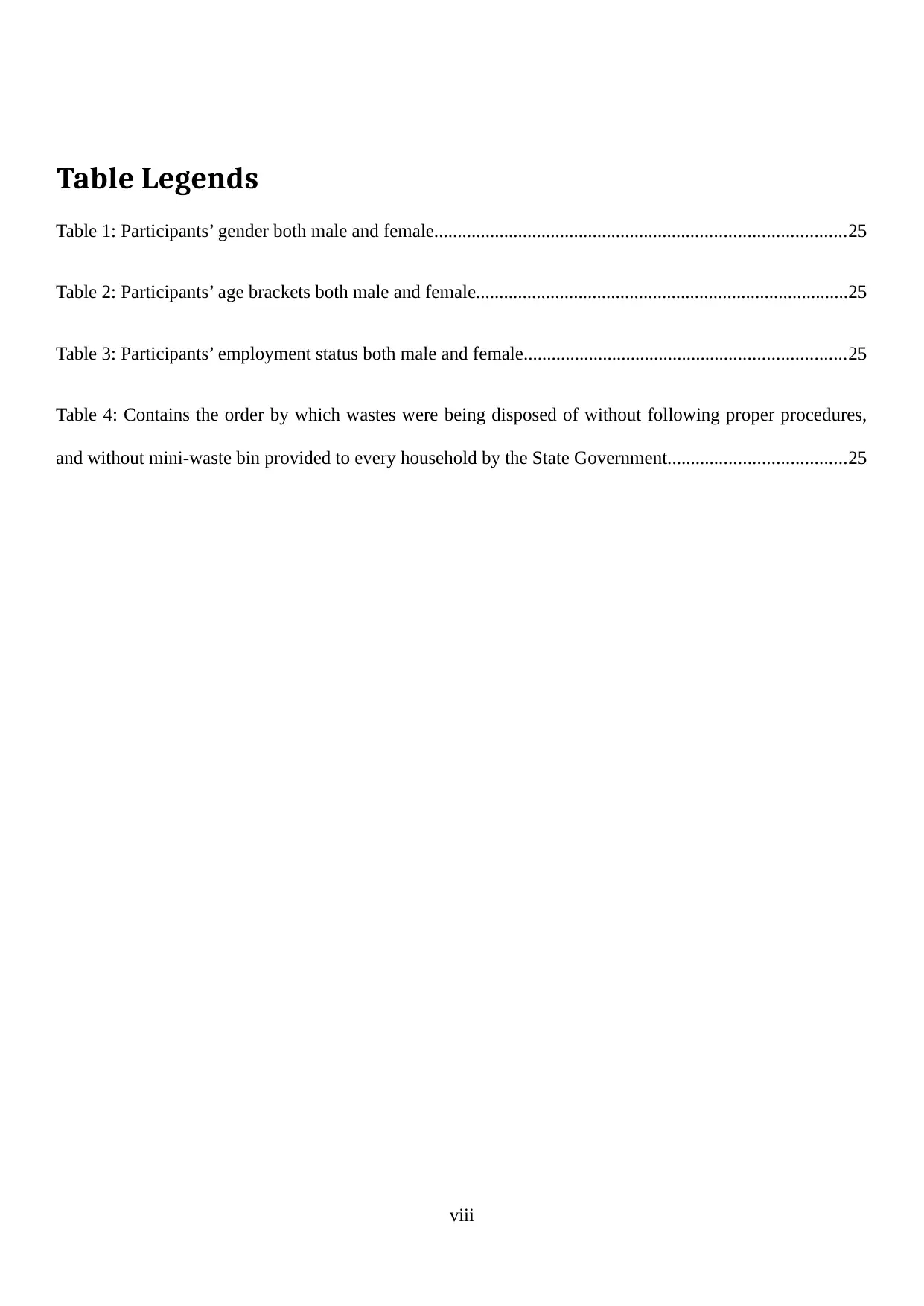
Table 1: Participants’ gender both male and female........................................................................................25
Table 2: Participants’ age brackets both male and female................................................................................25
Table 3: Participants’ employment status both male and female.....................................................................25
Table 4: Contains the order by which wastes were being disposed of without following proper procedures,
and without mini-waste bin provided to every household by the State Government......................................25
viii

This work is dedicated to God Almighty, the infinite mercy of the entire universe, whom by virtue of His
endurance gave me the necessary support to pursue this programme to its logical conclusion
And
My late parents, during their lives time sacrificed meagre resources, initiated the foundation of education
knowledge into my career development. It causes inexplicable pain to remember you this day, but finally,
with a smile on my lips. Thank you for leading the way.
ix
⊘ This is a preview!⊘
Do you want full access?
Subscribe today to unlock all pages.

Trusted by 1+ million students worldwide

The success in the completion of this research project was particularly influenced by the professors, and
lecturers who directly and indirectly imparted knowledge during my career development at this great
London South Bank University.
My sincere appreciation goes to my supervisor, Mr. Spring Louis, whose advice, assistance, direct
criticisms, and articulate approach to issue was integral part of my understanding as to what format the
project should be tackled. Out of his tight schedules, he still found space to read, make amendments where
possible, and evaluate all part of my project. Mr. Spring, you are such a wonderful and excellent motivator.
Without you, this work would not have been completed.
My sincere appreciation also goes to all my lecturers starting from year 1 to year 4. People like Dr. Ebad
Banissi, Dr. Aziz Ait-Braham, Dr. Martin Bush, Mr. Paul Carden, Mr. Mike Child, Mrs. Lucia Otoyo and Dr.
Barikai Safia. You have been wonderful people, full of advice and encouragement at London South Bank
University and thanks for your patience. And to those whom I was unable to mention their names, please
forgive and continue with the good work.
Dr. Emmanuel Achikeh, my mentor, director, and inspirational friend. I need to remind you that at a
particular stage in my academic career and development, I said to you, I can’t cope with family, work and
education. Your reply sounded calm and resolute. “Mr. Ichaba, you will have to finish it. Good things do not
come so easily.” Thank you for being there in every step of the way.
Lastly, to my dear wife and to all our children, thank you for your true love, endurance, and support. There
were times it was difficult, but your encouragement was the energy that sustained me through.
x
Paraphrase This Document

Main purpose of preparing this Dissertation is to develop Malaria Information Portal in the fight
against Malaria in Urban Lokoja, Kogi State, Nigeria. Malaria is a disease having grounds of continual fever
with headache and chill. After onset of fever it settle after sometimes and once again reoccurs. In terrible
cases it can advance to coma and even death. It is origin by parasites which is known as Plasmodium. It get
down with the sting of female invertebrate genus mosquitoes which carries this organism. Information
Technology (IT) has become an integral part of framework that enhances modern design to improve
businesses, social cohesion, and environmental development. With advanced information technology tools,
business communities, society, and ecosystem can be structured in such a way that helps minimise burdens
on the environment, encourage human behaviour and improvement to human dwellings.
However, there are two main prime factors to this project. Firstly, assessing and analysing sources in urban
Lokoja that caused malaria parasites and at the same time aided mosquitoes to breed constantly, which
enable this harmful species to increase in population on annual basis. Secondly, the involvement of new
information technology tool invented to identify, predict, analyse, and evaluate the areas prone to malaria
risk; and mitigation to reduce malaria parasites and infection through mosquito bite.
A recent study proved that mosquitoes are now resilient and immune to insecticide. In order to overcome
this harmful species with resilience and immune capability; a method to physically capture and permanently
destroy mosquitoes at their natural environments has been introduced. Biogents (BG) counter mosquito trap
was discovered as a substitute and has been tested to be effective. Biogents-Counter is combined with
mosquito trap and information technology system that has a mechanism to differentiate mosquitoes from
other insects, analyse mosquito’s activities, and wirelessly sends data to remote Web server for public
xi
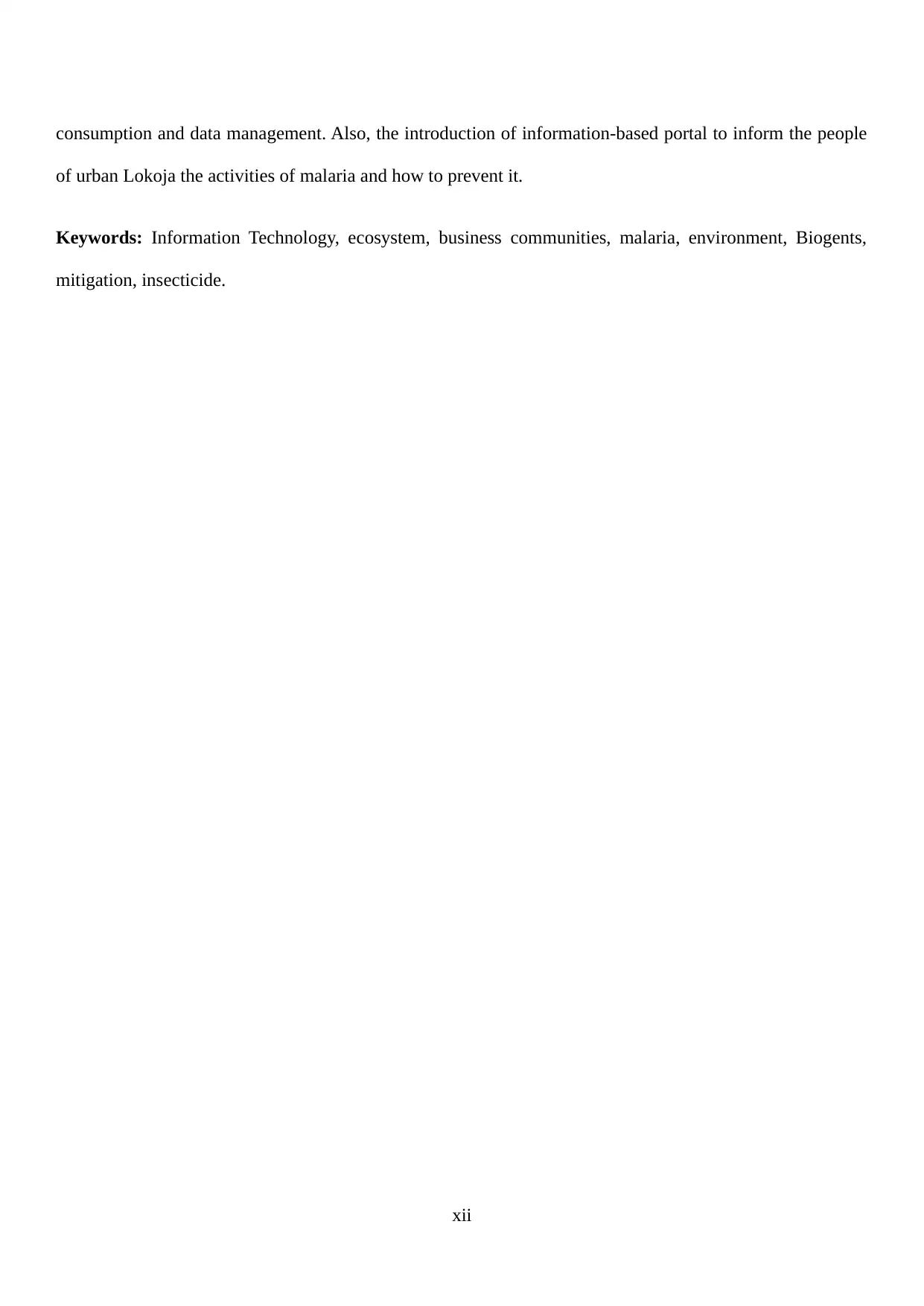
of urban Lokoja the activities of malaria and how to prevent it.
Keywords: Information Technology, ecosystem, business communities, malaria, environment, Biogents,
mitigation, insecticide.
xii
⊘ This is a preview!⊘
Do you want full access?
Subscribe today to unlock all pages.

Trusted by 1+ million students worldwide

Introduction
Scope
Scope of this study is mainly divided into three parts such as location, time and cost. In order to
implement malaria information portal company need some spaces, time and cost. To complete this project,
researcher require more time and cost. Therefore, this portal is useful for reducing malaria disease from the
socity and environment. Annually, the number of people that died of malaria contacted disease was
estimated to be high in Sub-Sharan Africa when compared to any other infectious disease. “The human and
economic costs associated with declining quality of life, consultations, treatments, hospitalisations and other
events related to malaria are enormous and often lead to low productivity and lost incomes” (Adebayo and
Anumudu, 2013). This detailed study presents holistic state of malaria menace in sub-Sharan Africa.
Different strategies explored by people of integrity, wealth and knowledge had been applied to fight malaria
with a handful success; yet the percentage of mortality rate remains high in Sub-Sharan Africa. At the press
release in DAVOS, Switzerland – The Bill & Melinda Gates Foundation renewed a substantial financial
commitments of $750 million to the fight “AIDS, Tuberculosis and Malaria.” Bill Gates made a statement
that indirectly challenged the integrity of some of the African leaders. As explained, “These are tough
economic times, but that is no excuse for cutting aid to the world’s poorest.” Detailed report can be accessed
on the link: https://www.gatesfoundation.org/What-We-Do/Global-Health/Malaria. It was indeed, a powerful
report, and at the same time very disturbing too. African leaders should see the self-explanatory statement as
a wake-up call in order to redirect financial resources at projects that have values, and at the same time
1
Paraphrase This Document
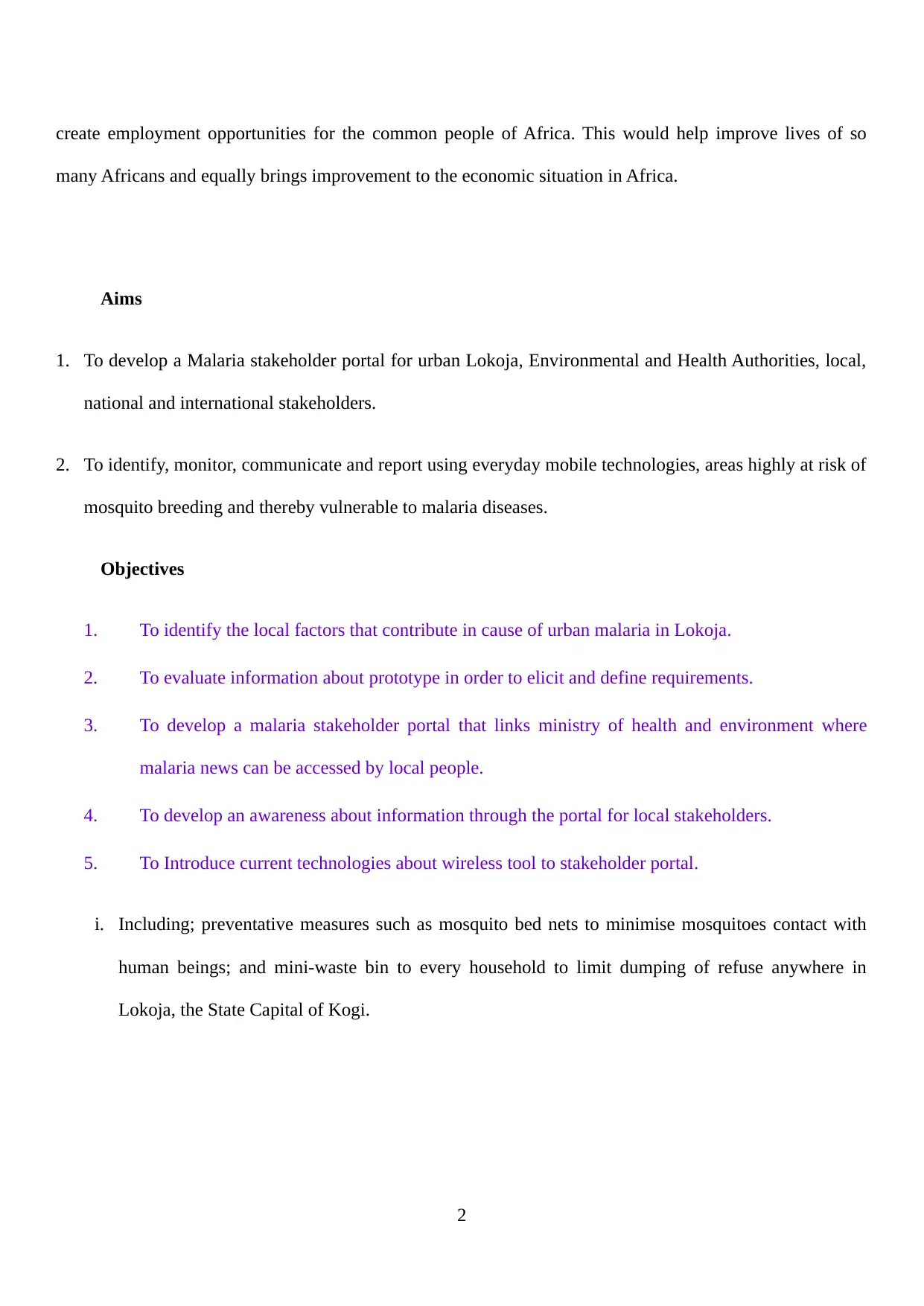
many Africans and equally brings improvement to the economic situation in Africa.
Aims
1. To develop a Malaria stakeholder portal for urban Lokoja, Environmental and Health Authorities, local,
national and international stakeholders.
2. To identify, monitor, communicate and report using everyday mobile technologies, areas highly at risk of
mosquito breeding and thereby vulnerable to malaria diseases.
Objectives
1. To identify the local factors that contribute in cause of urban malaria in Lokoja.
2. To evaluate information about prototype in order to elicit and define requirements.
3. To develop a malaria stakeholder portal that links ministry of health and environment where
malaria news can be accessed by local people.
4. To develop an awareness about information through the portal for local stakeholders.
5. To Introduce current technologies about wireless tool to stakeholder portal.
i. Including; preventative measures such as mosquito bed nets to minimise mosquitoes contact with
human beings; and mini-waste bin to every household to limit dumping of refuse anywhere in
Lokoja, the State Capital of Kogi.
2
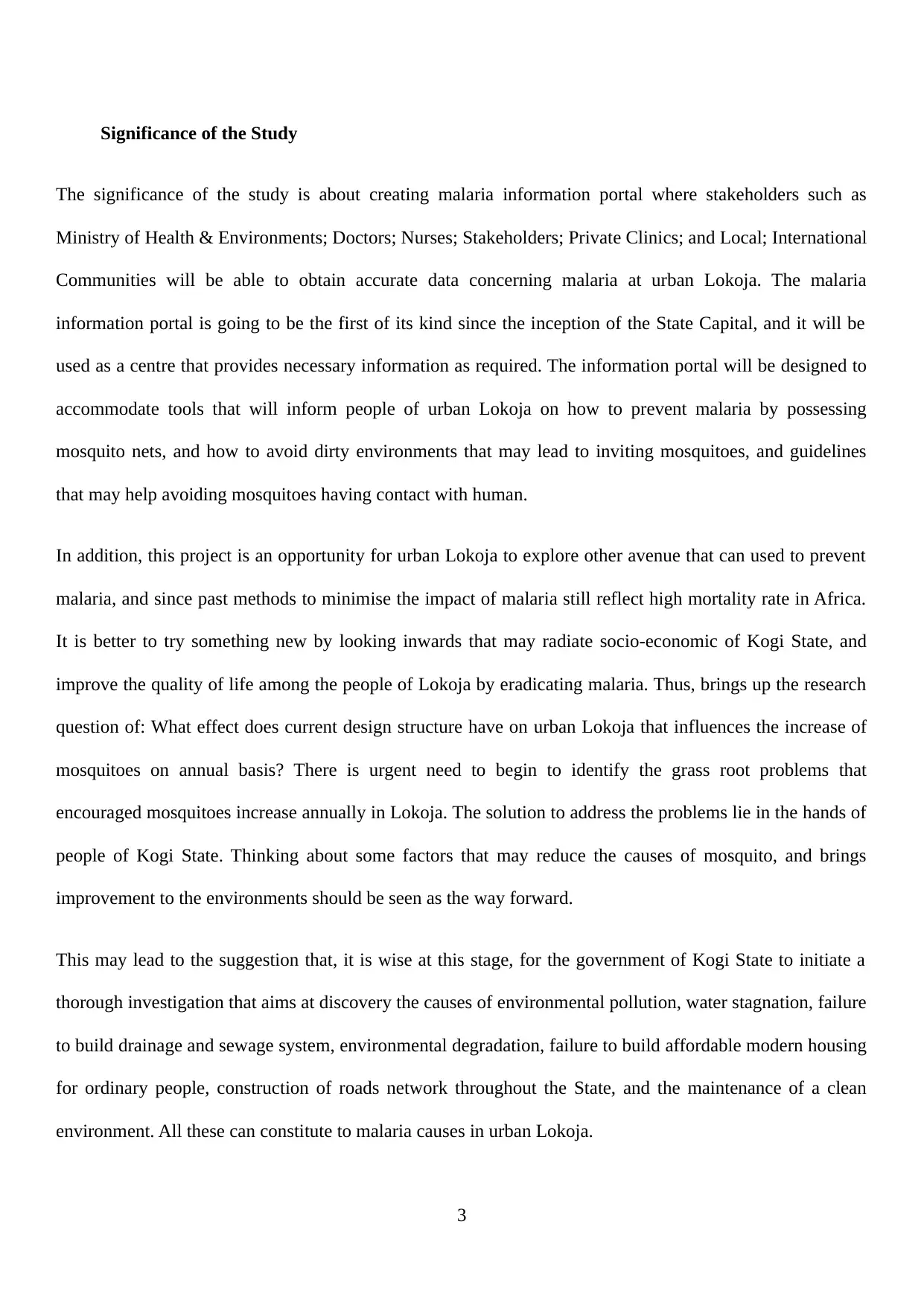
The significance of the study is about creating malaria information portal where stakeholders such as
Ministry of Health & Environments; Doctors; Nurses; Stakeholders; Private Clinics; and Local; International
Communities will be able to obtain accurate data concerning malaria at urban Lokoja. The malaria
information portal is going to be the first of its kind since the inception of the State Capital, and it will be
used as a centre that provides necessary information as required. The information portal will be designed to
accommodate tools that will inform people of urban Lokoja on how to prevent malaria by possessing
mosquito nets, and how to avoid dirty environments that may lead to inviting mosquitoes, and guidelines
that may help avoiding mosquitoes having contact with human.
In addition, this project is an opportunity for urban Lokoja to explore other avenue that can used to prevent
malaria, and since past methods to minimise the impact of malaria still reflect high mortality rate in Africa.
It is better to try something new by looking inwards that may radiate socio-economic of Kogi State, and
improve the quality of life among the people of Lokoja by eradicating malaria. Thus, brings up the research
question of: What effect does current design structure have on urban Lokoja that influences the increase of
mosquitoes on annual basis? There is urgent need to begin to identify the grass root problems that
encouraged mosquitoes increase annually in Lokoja. The solution to address the problems lie in the hands of
people of Kogi State. Thinking about some factors that may reduce the causes of mosquito, and brings
improvement to the environments should be seen as the way forward.
This may lead to the suggestion that, it is wise at this stage, for the government of Kogi State to initiate a
thorough investigation that aims at discovery the causes of environmental pollution, water stagnation, failure
to build drainage and sewage system, environmental degradation, failure to build affordable modern housing
for ordinary people, construction of roads network throughout the State, and the maintenance of a clean
environment. All these can constitute to malaria causes in urban Lokoja.
3
⊘ This is a preview!⊘
Do you want full access?
Subscribe today to unlock all pages.

Trusted by 1+ million students worldwide

Malaria stakeholder portal is essential and important to the business to protect health and safety of
individual. This model is more significant and effective for overcoming issue about malaria. Hypothesis is
related as an intelligent prediction or guess that provides directional to the investigator to answer the
questions of research in an appropriate manner. It enables a researcher to start their research work and may
lead to implementation of another hypothesis. There are different kind of hypothesis such as simple,
complex, empirical, null, alternatives, logical and statistical. In this research topic in order to clean up the
urban Lokoja, and for it to attain a standard status among national and international communities; malaria
information portal project must be embraced and seen as a reality. There are certain issues with the current
design of the city that encourage proliferation of mosquitoes in each year. Involvement of urban and regional
planning technocrats who by virtue of academic studies had gained wide experience in this field should be
used to conduct technical analysis of requirements. The results of their findings should include the provision
of affordable modern housing development involving roads layout that contain drainage and sewage system
to compensate the existing environmental pollution and water stagnation (Alavian, 2013). The first step is to
initiate a meaningful dialogue between the political gladiators at the local level, and the involvement of
government agencies to understand the scope of the project and why it matters to deal with issues that
malaria relate to; its effects and overall overview of lack of development in Lokoja as a State Capital. The
second move is bringing to the notice of the State Government the financial implications of the project. Who
is to finance it and how the project can be stage-managed over time? (Peter Hall, 2011a).
Background of the study
Malaria is harmful species that causes protozoal disease, is an important health issue most especially in
developing countries in Sub-Saharan Africa. Malaria virus accounts for an estimated between 300 – 500
million diseases globally with 1.5 to 2.7 million human beings dying annually as reported by world health
organisation (WHO); out of which more than eighty per cent of these victims were found in Sub-Saharan
4
Paraphrase This Document
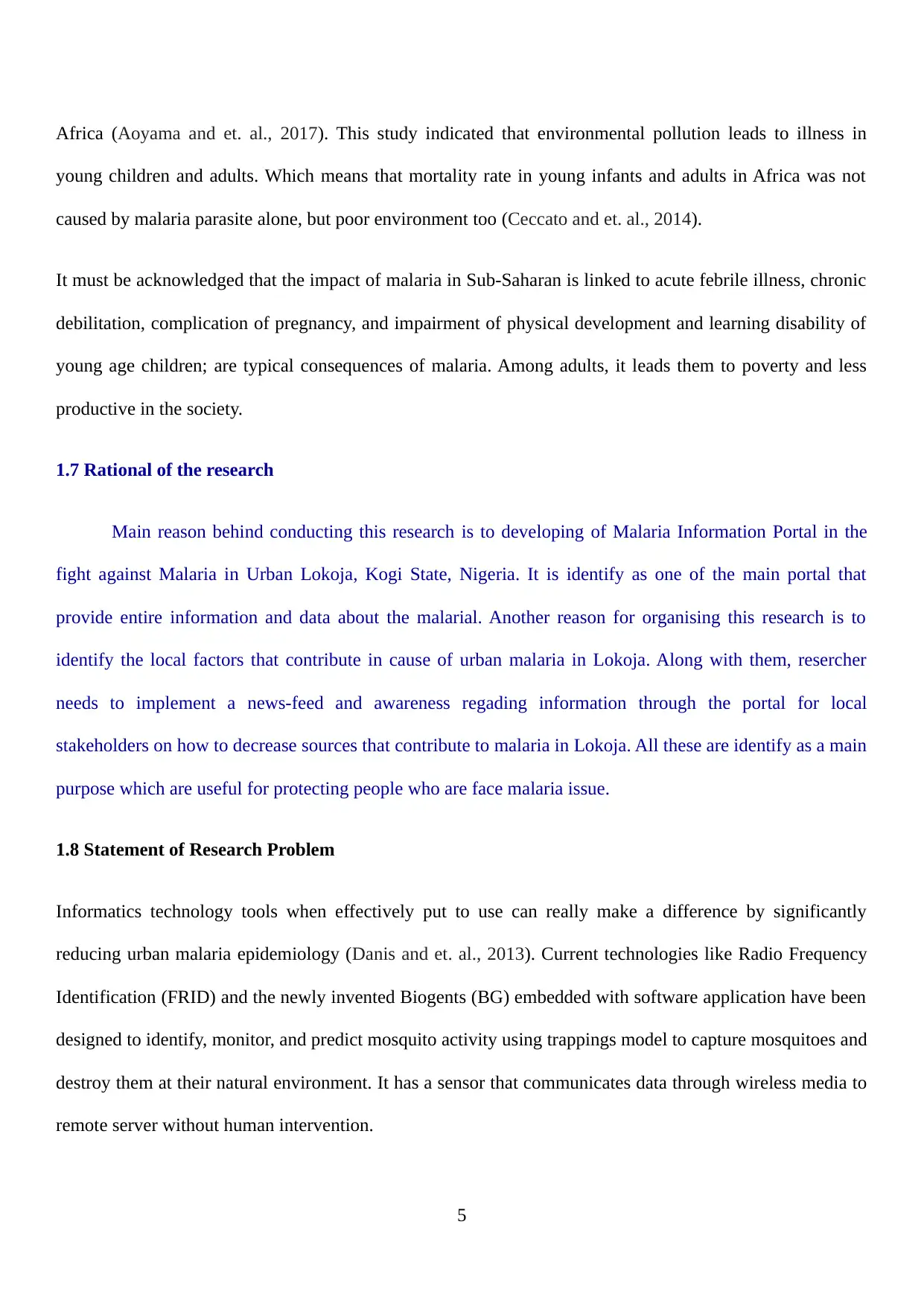
young children and adults. Which means that mortality rate in young infants and adults in Africa was not
caused by malaria parasite alone, but poor environment too (Ceccato and et. al., 2014).
It must be acknowledged that the impact of malaria in Sub-Saharan is linked to acute febrile illness, chronic
debilitation, complication of pregnancy, and impairment of physical development and learning disability of
young age children; are typical consequences of malaria. Among adults, it leads them to poverty and less
productive in the society.
1.7 Rational of the research
Main reason behind conducting this research is to developing of Malaria Information Portal in the
fight against Malaria in Urban Lokoja, Kogi State, Nigeria. It is identify as one of the main portal that
provide entire information and data about the malarial. Another reason for organising this research is to
identify the local factors that contribute in cause of urban malaria in Lokoja. Along with them, resercher
needs to implement a news-feed and awareness regading information through the portal for local
stakeholders on how to decrease sources that contribute to malaria in Lokoja. All these are identify as a main
purpose which are useful for protecting people who are face malaria issue.
1.8 Statement of Research Problem
Informatics technology tools when effectively put to use can really make a difference by significantly
reducing urban malaria epidemiology (Danis and et. al., 2013). Current technologies like Radio Frequency
Identification (FRID) and the newly invented Biogents (BG) embedded with software application have been
designed to identify, monitor, and predict mosquito activity using trappings model to capture mosquitoes and
destroy them at their natural environment. It has a sensor that communicates data through wireless media to
remote server without human intervention.
5

and environment and local health authorities, local, national and international stakeholders, which includes
the malaria endemic countries such as Coastal Kenya (Kenya), Dar es Salaam (Tanzania), Accra (Ghana),
Contonou (Benin), Lagos (Nigeria), Port-Harcourt (Nigeria), Calabar (Nigeria), Lokoja (Nigeria), Rondonia
(Brazil) (Chinery, 1995; Hightower et al, 1998; Massele et al, 1997; Sharma et al, 1996b, and Wang 2005)
among others.
1.9 Scope and Limitations of the Study
The scope and limitation of this study will focus on geographical remote sensor which may affect
images due to land curvature derived from land terrain used in mapping the risk areas. Therefore, it was
decided to involve a field survey approach by employing a multimedia photographer by using photography
method to capture land surface, road conditions, environment, gutters, and dump sites to determine the
“cause-and-effect” of various localities identified as probabilistic of malaria risks in Lokoja town.
Multimedia is refer as an content that follow a combination of various content and information in
forms of text, images, audio, video, interactive and animations data. Multimedia dividing line with media
that apply only rudimentary computer displays including text-only and traditional forms of printed and
hand-produced material. Multimedia is all about developing powerful visual storytelling that striking hearts
or minds. Business use audio, photography, video, motion graphics, design and data graphics to say
journalistic and commercial stories that matter.
Lokoja is the capital of Kogi State, Nigeria. The State is formed by the demography of heterogeneity;
surrounded by vegetation and water areas. The town is situated at the bank of river Niger and river Benue
(known as the Confluence River). It is an ecological environment that enables fostering of mosquitoes with
air temperature of about 34 degree. These features have significant tendencies for malaria, and as explained
by (Ifatimehin, 2007); the overall statistics of national malaria report of 2004 stated that there was no data
recorded about malaria in Lokoja the state capital of Kogi, and its surroundings to inform the body of human
6
⊘ This is a preview!⊘
Do you want full access?
Subscribe today to unlock all pages.

Trusted by 1+ million students worldwide
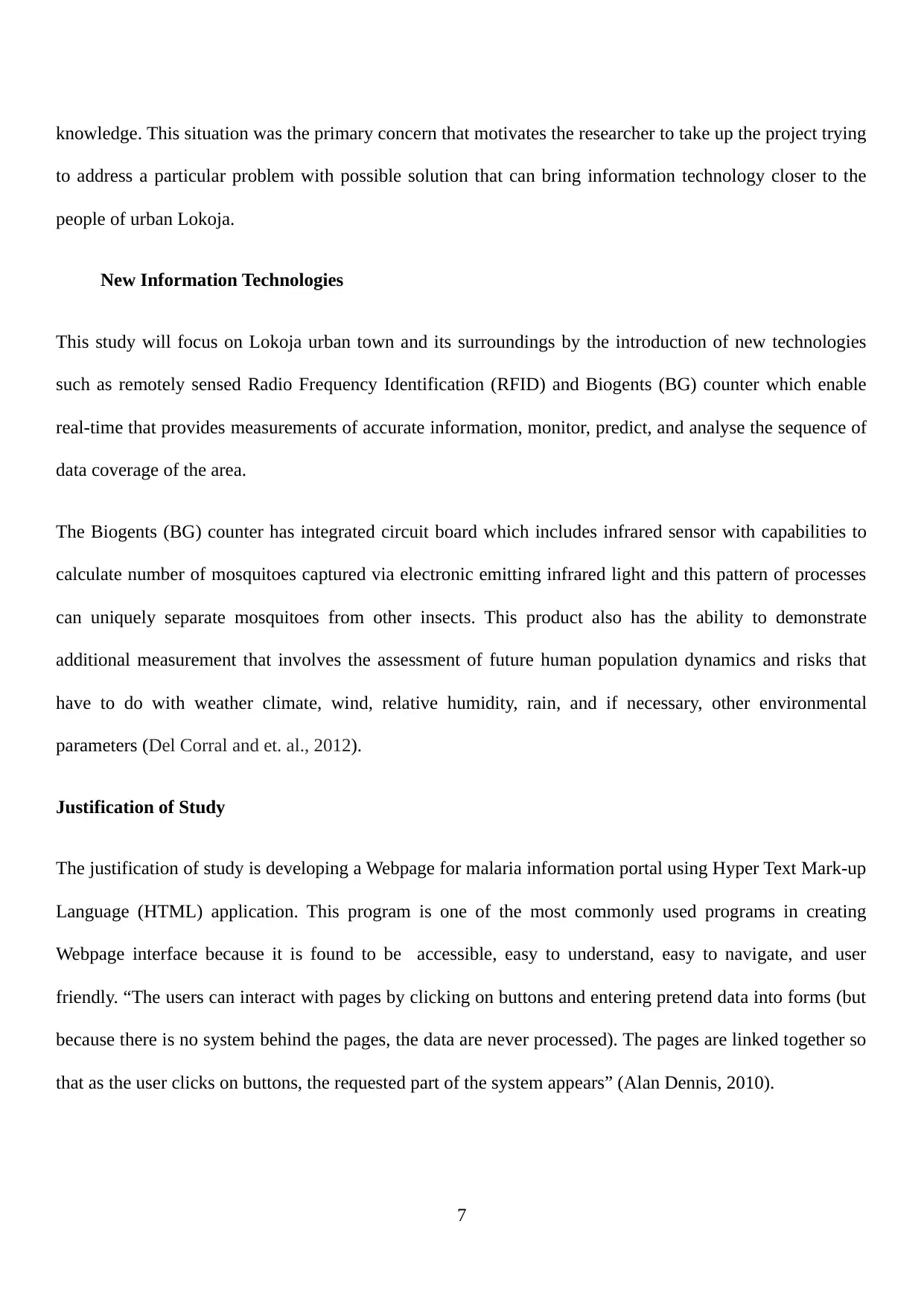
to address a particular problem with possible solution that can bring information technology closer to the
people of urban Lokoja.
New Information Technologies
This study will focus on Lokoja urban town and its surroundings by the introduction of new technologies
such as remotely sensed Radio Frequency Identification (RFID) and Biogents (BG) counter which enable
real-time that provides measurements of accurate information, monitor, predict, and analyse the sequence of
data coverage of the area.
The Biogents (BG) counter has integrated circuit board which includes infrared sensor with capabilities to
calculate number of mosquitoes captured via electronic emitting infrared light and this pattern of processes
can uniquely separate mosquitoes from other insects. This product also has the ability to demonstrate
additional measurement that involves the assessment of future human population dynamics and risks that
have to do with weather climate, wind, relative humidity, rain, and if necessary, other environmental
parameters (Del Corral and et. al., 2012).
Justification of Study
The justification of study is developing a Webpage for malaria information portal using Hyper Text Mark-up
Language (HTML) application. This program is one of the most commonly used programs in creating
Webpage interface because it is found to be accessible, easy to understand, easy to navigate, and user
friendly. “The users can interact with pages by clicking on buttons and entering pretend data into forms (but
because there is no system behind the pages, the data are never processed). The pages are linked together so
that as the user clicks on buttons, the requested part of the system appears” (Alan Dennis, 2010).
7
Paraphrase This Document
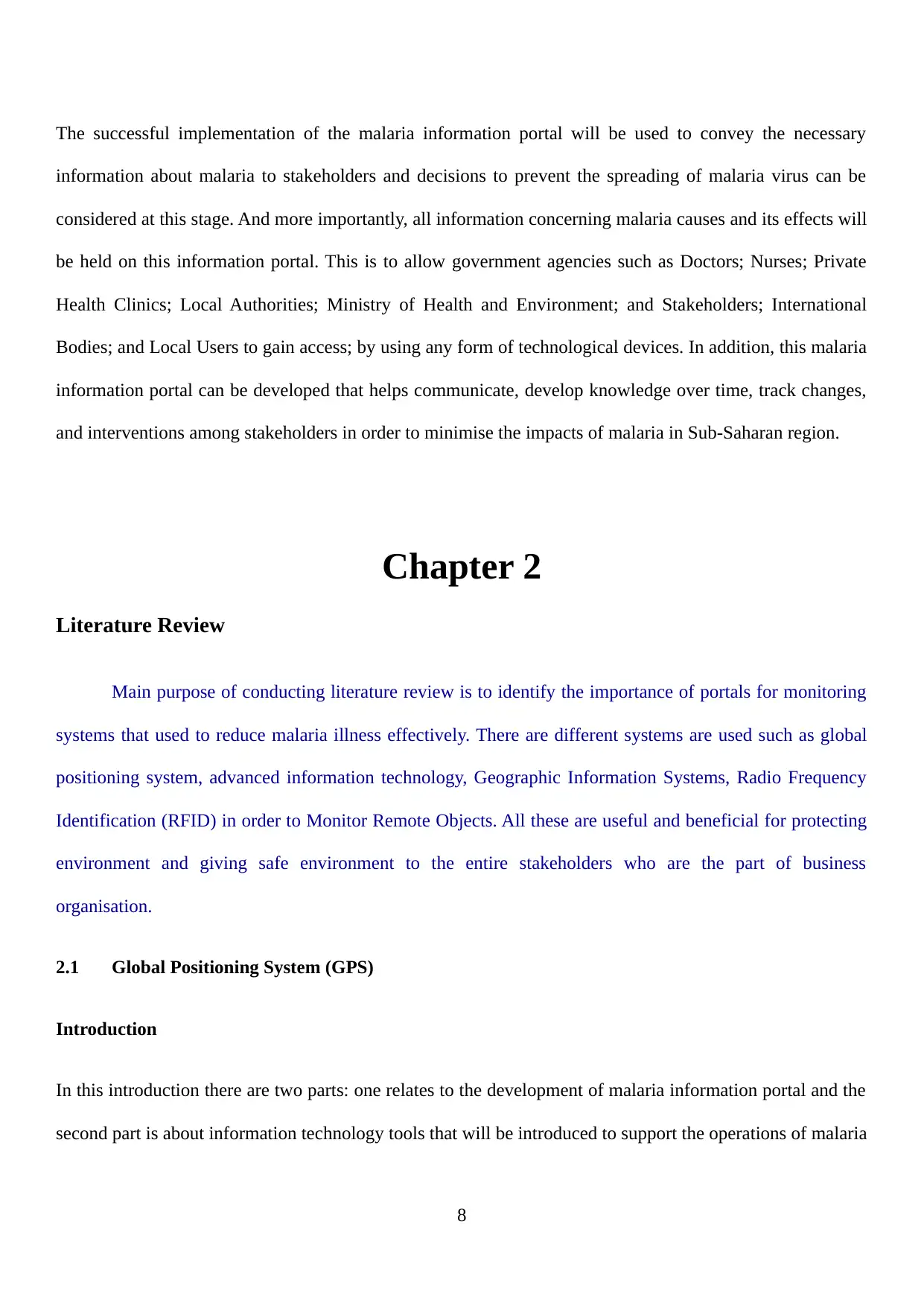
information about malaria to stakeholders and decisions to prevent the spreading of malaria virus can be
considered at this stage. And more importantly, all information concerning malaria causes and its effects will
be held on this information portal. This is to allow government agencies such as Doctors; Nurses; Private
Health Clinics; Local Authorities; Ministry of Health and Environment; and Stakeholders; International
Bodies; and Local Users to gain access; by using any form of technological devices. In addition, this malaria
information portal can be developed that helps communicate, develop knowledge over time, track changes,
and interventions among stakeholders in order to minimise the impacts of malaria in Sub-Saharan region.
Chapter 2
Literature Review
Main purpose of conducting literature review is to identify the importance of portals for monitoring
systems that used to reduce malaria illness effectively. There are different systems are used such as global
positioning system, advanced information technology, Geographic Information Systems, Radio Frequency
Identification (RFID) in order to Monitor Remote Objects. All these are useful and beneficial for protecting
environment and giving safe environment to the entire stakeholders who are the part of business
organisation.
2.1 Global Positioning System (GPS)
Introduction
In this introduction there are two parts: one relates to the development of malaria information portal and the
second part is about information technology tools that will be introduced to support the operations of malaria
8
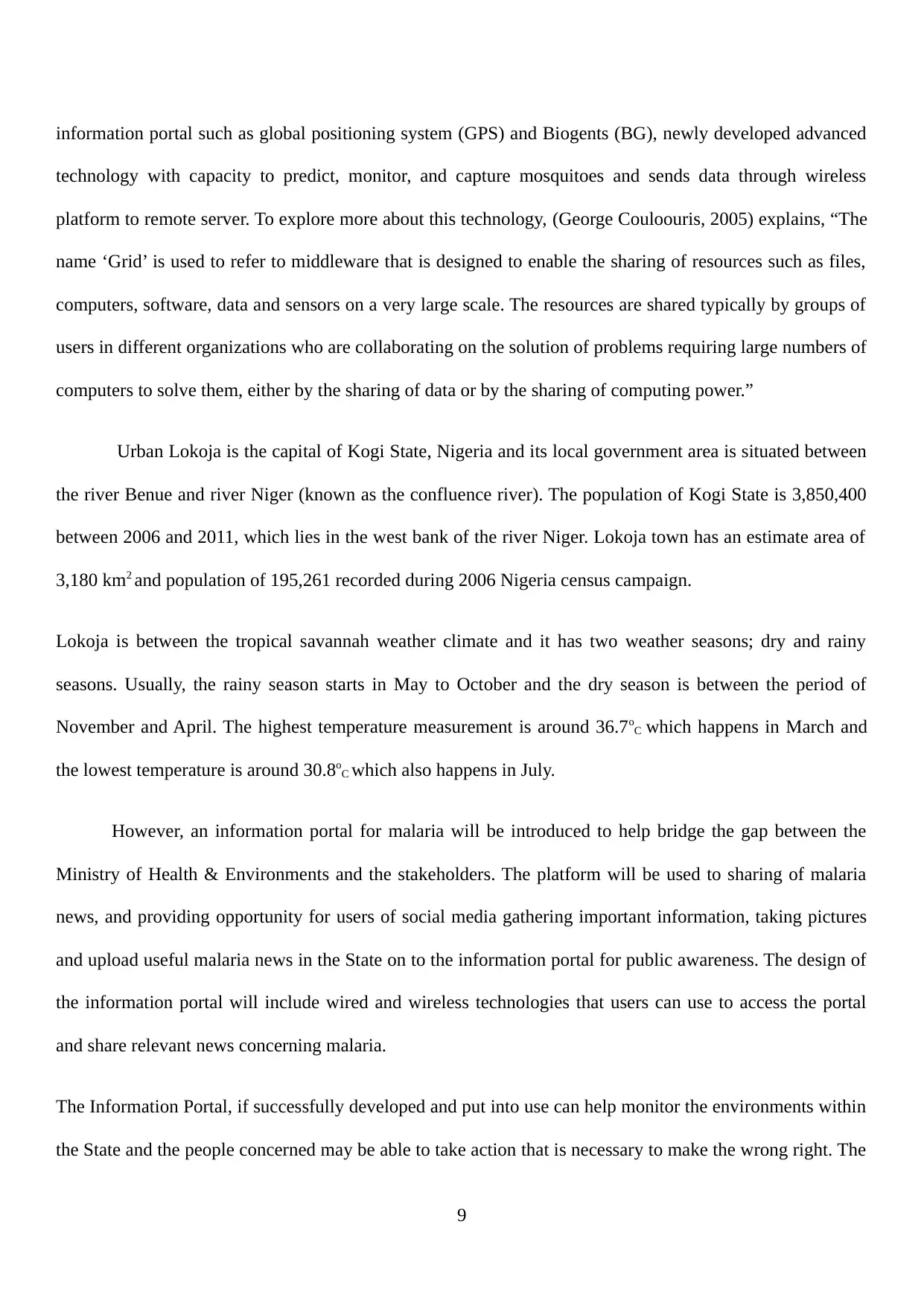
technology with capacity to predict, monitor, and capture mosquitoes and sends data through wireless
platform to remote server. To explore more about this technology, (George Couloouris, 2005) explains, “The
name ‘Grid’ is used to refer to middleware that is designed to enable the sharing of resources such as files,
computers, software, data and sensors on a very large scale. The resources are shared typically by groups of
users in different organizations who are collaborating on the solution of problems requiring large numbers of
computers to solve them, either by the sharing of data or by the sharing of computing power.”
Urban Lokoja is the capital of Kogi State, Nigeria and its local government area is situated between
the river Benue and river Niger (known as the confluence river). The population of Kogi State is 3,850,400
between 2006 and 2011, which lies in the west bank of the river Niger. Lokoja town has an estimate area of
3,180 km2 and population of 195,261 recorded during 2006 Nigeria census campaign.
Lokoja is between the tropical savannah weather climate and it has two weather seasons; dry and rainy
seasons. Usually, the rainy season starts in May to October and the dry season is between the period of
November and April. The highest temperature measurement is around 36.7oC which happens in March and
the lowest temperature is around 30.8oC which also happens in July.
However, an information portal for malaria will be introduced to help bridge the gap between the
Ministry of Health & Environments and the stakeholders. The platform will be used to sharing of malaria
news, and providing opportunity for users of social media gathering important information, taking pictures
and upload useful malaria news in the State on to the information portal for public awareness. The design of
the information portal will include wired and wireless technologies that users can use to access the portal
and share relevant news concerning malaria.
The Information Portal, if successfully developed and put into use can help monitor the environments within
the State and the people concerned may be able to take action that is necessary to make the wrong right. The
9
⊘ This is a preview!⊘
Do you want full access?
Subscribe today to unlock all pages.

Trusted by 1+ million students worldwide

explore other developed countries within and outside Africa in which variety of methods, preferably, urban
and regional planning which was used as a framework to dislodge cities of rain water. The design used could
be most effective way to minimise cost by introducing modern drainage and sewage system that worked for
them. Without a brain-drain, the idea can be replicated to help provide quality of life to the people of urban
Lokoja.
2.1.3 Advanced Information Technology
The discovery of advanced information technology has the potentials to reduce the impact of malaria
on a global scale. Thus, “Information technology must be applied thoughtfully and carefully so that society,
business, and industry around the globe can reap their enormous benefits” (Estevez, and Montoya, 2015).
Below are two quotes drawn from a book written about information technology using software application
to monitor the behaviour of a machine, and the process of improving “domestic energy demands” by
customers. These examples will be used as a wake-up call to local authorities in urban Lokoja to address the
environmental pollution within the city. Creation of drainage, sewage, and road maintenance does not have
to wait until the situation has spirally gone out of control. It should be tackled as soon as the condition was
noticed. That is fundamental principle of maintenance.
“On the coast of Algeria a factory chugs away making plastics for its customers, secure in the knowledge
that its electricity won’t conk out…The trick to ensuring that a machine is always up and running is not to
wait for it to break down, but, rather, to fix it before it breaks down…If you could constantly monitor the
usage, then you would know exactly what could go wrong and when” (Graves and et. al., 2018).
“The answer is that Bill’s department monitors the behavior of the Jenbacher machines by using smart
systems software that includes 300 sensors that are reviewed continuously. The department analyses and
visualizes the data and compares it to predictive maintenance rules over time. They use smart analytics to
10
Paraphrase This Document
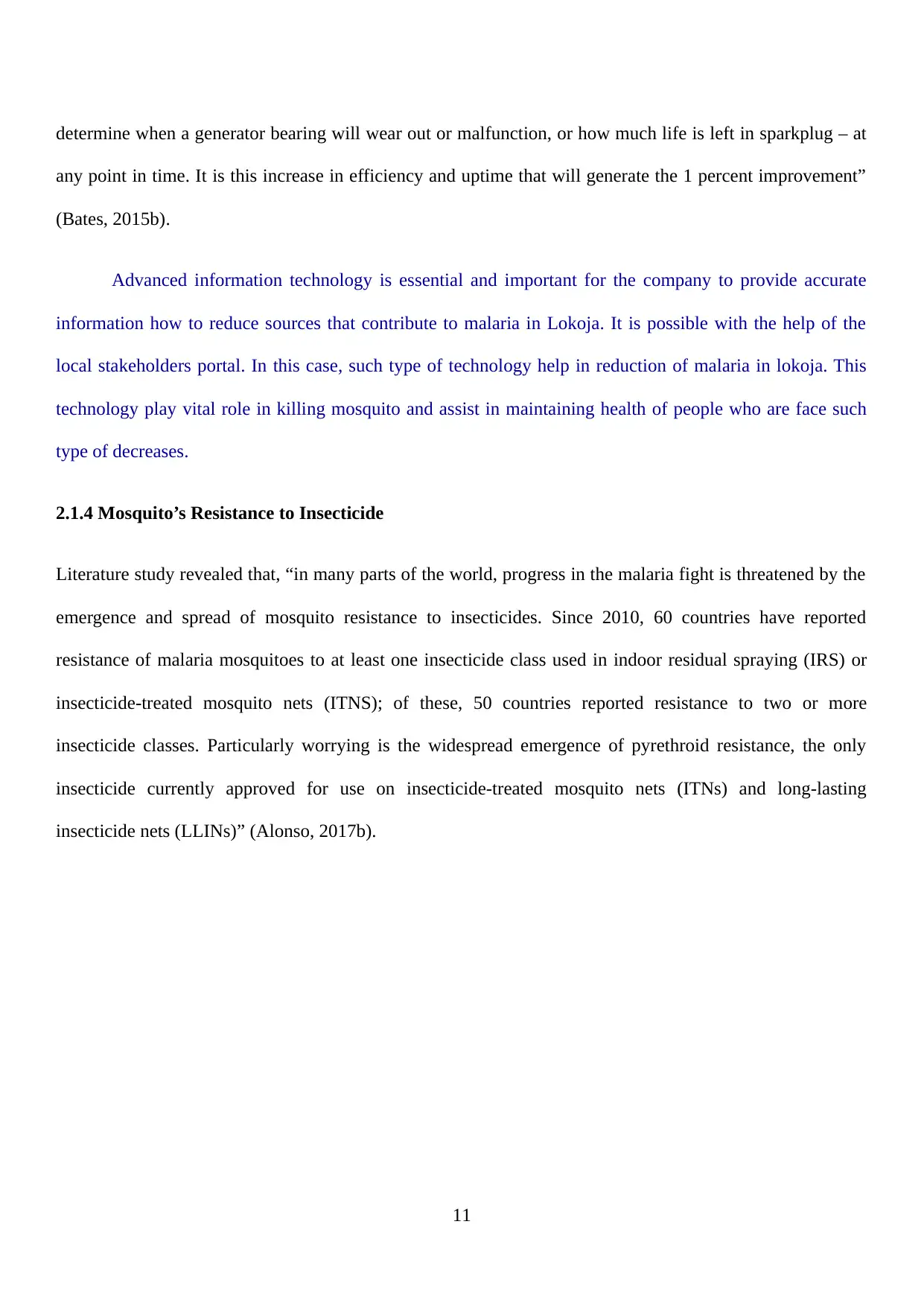
any point in time. It is this increase in efficiency and uptime that will generate the 1 percent improvement”
(Bates, 2015b).
Advanced information technology is essential and important for the company to provide accurate
information how to reduce sources that contribute to malaria in Lokoja. It is possible with the help of the
local stakeholders portal. In this case, such type of technology help in reduction of malaria in lokoja. This
technology play vital role in killing mosquito and assist in maintaining health of people who are face such
type of decreases.
2.1.4 Mosquito’s Resistance to Insecticide
Literature study revealed that, “in many parts of the world, progress in the malaria fight is threatened by the
emergence and spread of mosquito resistance to insecticides. Since 2010, 60 countries have reported
resistance of malaria mosquitoes to at least one insecticide class used in indoor residual spraying (IRS) or
insecticide-treated mosquito nets (ITNS); of these, 50 countries reported resistance to two or more
insecticide classes. Particularly worrying is the widespread emergence of pyrethroid resistance, the only
insecticide currently approved for use on insecticide-treated mosquito nets (ITNs) and long-lasting
insecticide nets (LLINs)” (Alonso, 2017b).
11

The above statistics are very worrisome and reacting to these disturbing figures “malaria cases and deaths
occurred” in Africa as a result of poor environmental pollution caused by the people in the society, one will
hastily move to introduce the newly acquired mosquito trap “Biogents (BG) counter”, which is widely used
in most developed countries; to support the war against malaria in Africa.
2.1.5 Geographic Information Systems to Monitor Remote Objects
Geographic Information Systems (GIS) is computer-based systems that can be identified with the following
characteristics: input, storage, management, retrieval, update, delete, analysis, and output of information
(Grove and et. al., 2015). (Hansen, 2015) described Geographical Information Systems (GIS) as
multipurpose “computer-based technologies” with capability to organise data in digital form so as to
“capture, store, manipulate, analyse and present diverse set of spatial or geo-referenced data.”
“GIS technologies have been widely applied at all scientific fields and practical activities. With
environmental management, their use includes a broad spectrum including as a simple formula, and
visualization of natural data as maps of animate nature resources, visualization of pollutant concentrations in
the environment and their spatial distribution (e.g. in the air)” (Kesselheim, Maggs and Sarpatwari, 2015).
12
⊘ This is a preview!⊘
Do you want full access?
Subscribe today to unlock all pages.

Trusted by 1+ million students worldwide
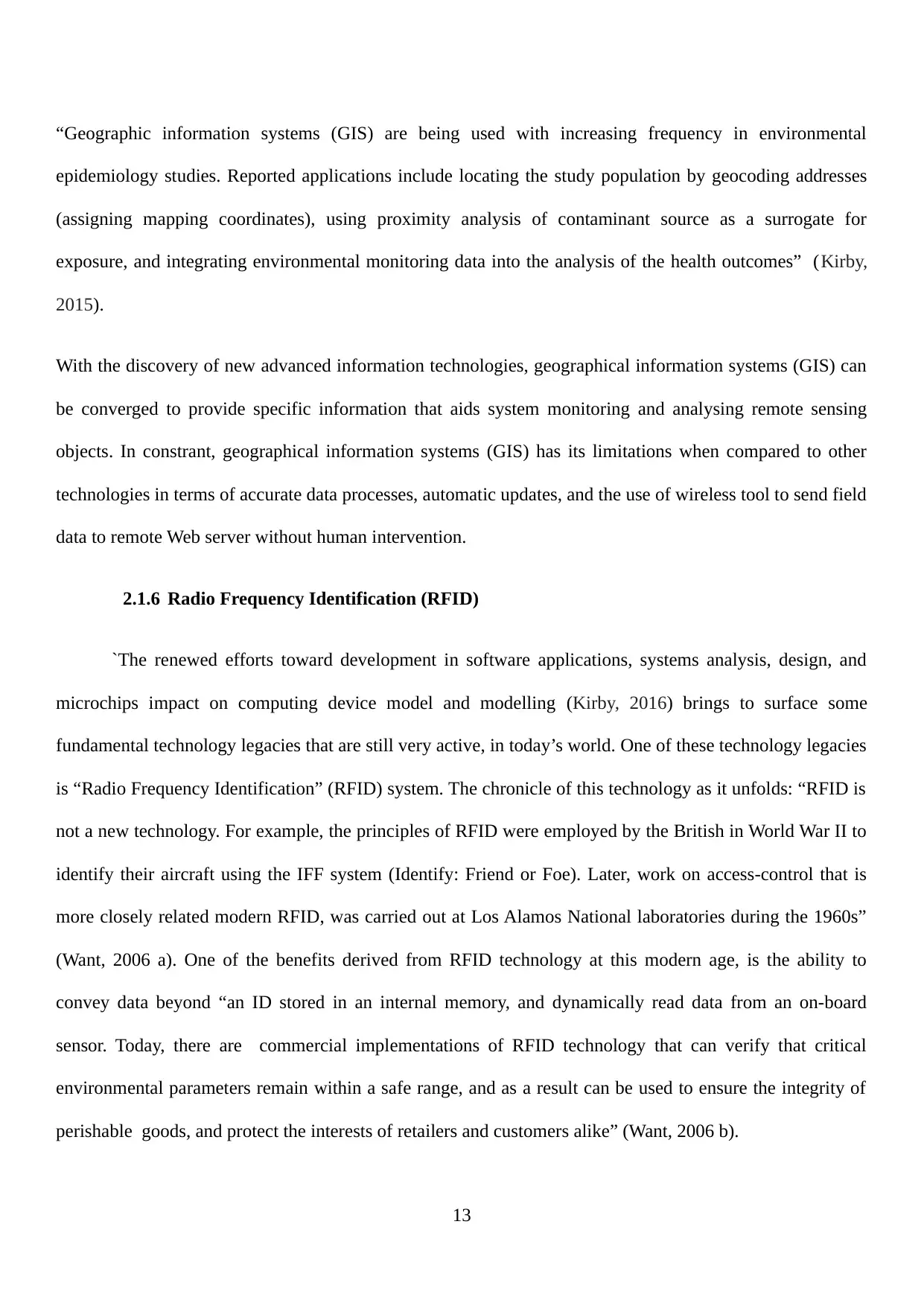
epidemiology studies. Reported applications include locating the study population by geocoding addresses
(assigning mapping coordinates), using proximity analysis of contaminant source as a surrogate for
exposure, and integrating environmental monitoring data into the analysis of the health outcomes” (Kirby,
2015).
With the discovery of new advanced information technologies, geographical information systems (GIS) can
be converged to provide specific information that aids system monitoring and analysing remote sensing
objects. In constrant, geographical information systems (GIS) has its limitations when compared to other
technologies in terms of accurate data processes, automatic updates, and the use of wireless tool to send field
data to remote Web server without human intervention.
2.1.6 Radio Frequency Identification (RFID)
`The renewed efforts toward development in software applications, systems analysis, design, and
microchips impact on computing device model and modelling (Kirby, 2016) brings to surface some
fundamental technology legacies that are still very active, in today’s world. One of these technology legacies
is “Radio Frequency Identification” (RFID) system. The chronicle of this technology as it unfolds: “RFID is
not a new technology. For example, the principles of RFID were employed by the British in World War II to
identify their aircraft using the IFF system (Identify: Friend or Foe). Later, work on access-control that is
more closely related modern RFID, was carried out at Los Alamos National laboratories during the 1960s”
(Want, 2006 a). One of the benefits derived from RFID technology at this modern age, is the ability to
convey data beyond “an ID stored in an internal memory, and dynamically read data from an on-board
sensor. Today, there are commercial implementations of RFID technology that can verify that critical
environmental parameters remain within a safe range, and as a result can be used to ensure the integrity of
perishable goods, and protect the interests of retailers and customers alike” (Want, 2006 b).
13
Paraphrase This Document
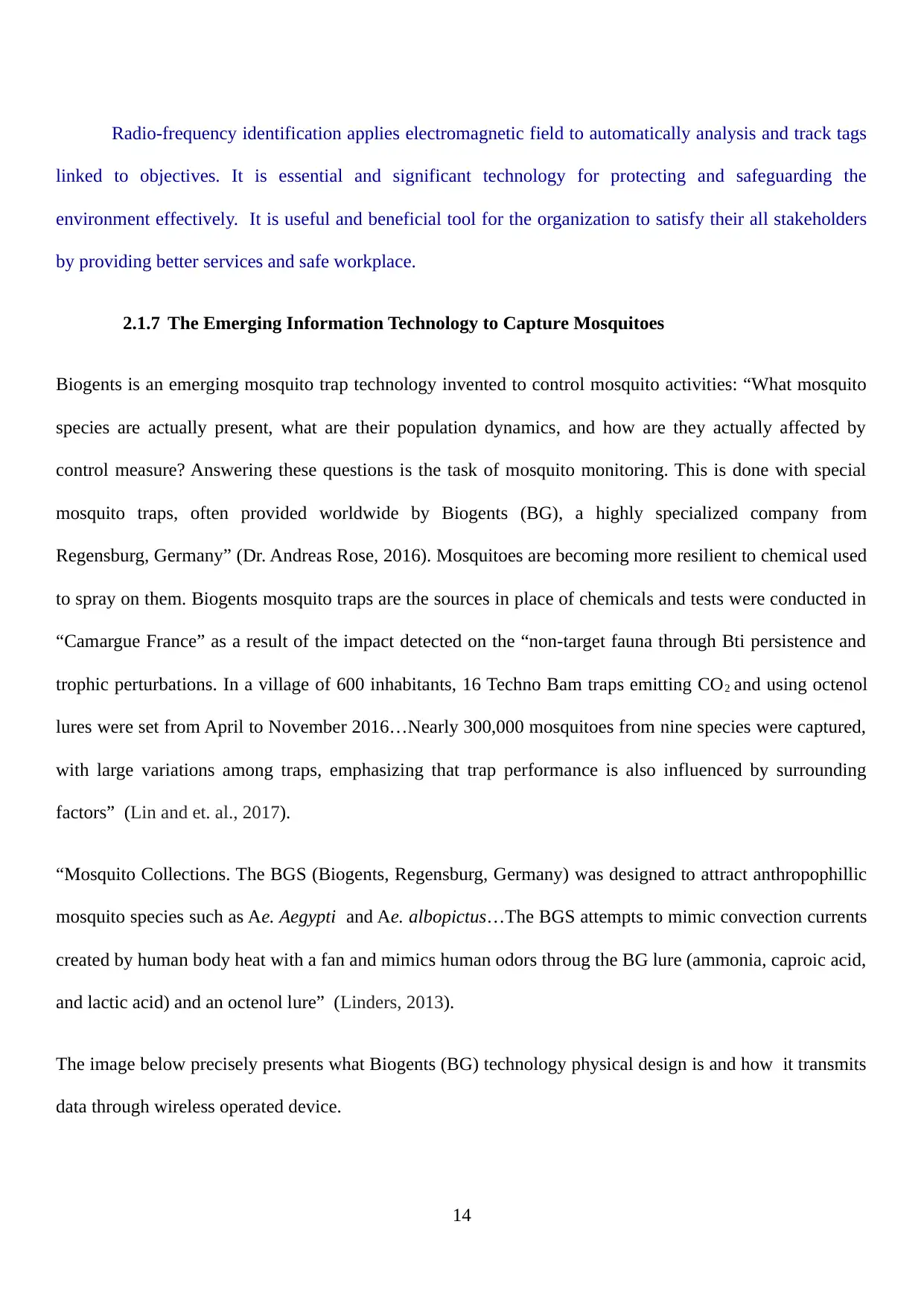
linked to objectives. It is essential and significant technology for protecting and safeguarding the
environment effectively. It is useful and beneficial tool for the organization to satisfy their all stakeholders
by providing better services and safe workplace.
2.1.7 The Emerging Information Technology to Capture Mosquitoes
Biogents is an emerging mosquito trap technology invented to control mosquito activities: “What mosquito
species are actually present, what are their population dynamics, and how are they actually affected by
control measure? Answering these questions is the task of mosquito monitoring. This is done with special
mosquito traps, often provided worldwide by Biogents (BG), a highly specialized company from
Regensburg, Germany” (Dr. Andreas Rose, 2016). Mosquitoes are becoming more resilient to chemical used
to spray on them. Biogents mosquito traps are the sources in place of chemicals and tests were conducted in
“Camargue France” as a result of the impact detected on the “non-target fauna through Bti persistence and
trophic perturbations. In a village of 600 inhabitants, 16 Techno Bam traps emitting CO2 and using octenol
lures were set from April to November 2016…Nearly 300,000 mosquitoes from nine species were captured,
with large variations among traps, emphasizing that trap performance is also influenced by surrounding
factors” (Lin and et. al., 2017).
“Mosquito Collections. The BGS (Biogents, Regensburg, Germany) was designed to attract anthropophillic
mosquito species such as Ae. Aegypti and Ae. albopictus…The BGS attempts to mimic convection currents
created by human body heat with a fan and mimics human odors throug the BG lure (ammonia, caproic acid,
and lactic acid) and an octenol lure” (Linders, 2013).
The image below precisely presents what Biogents (BG) technology physical design is and how it transmits
data through wireless operated device.
14
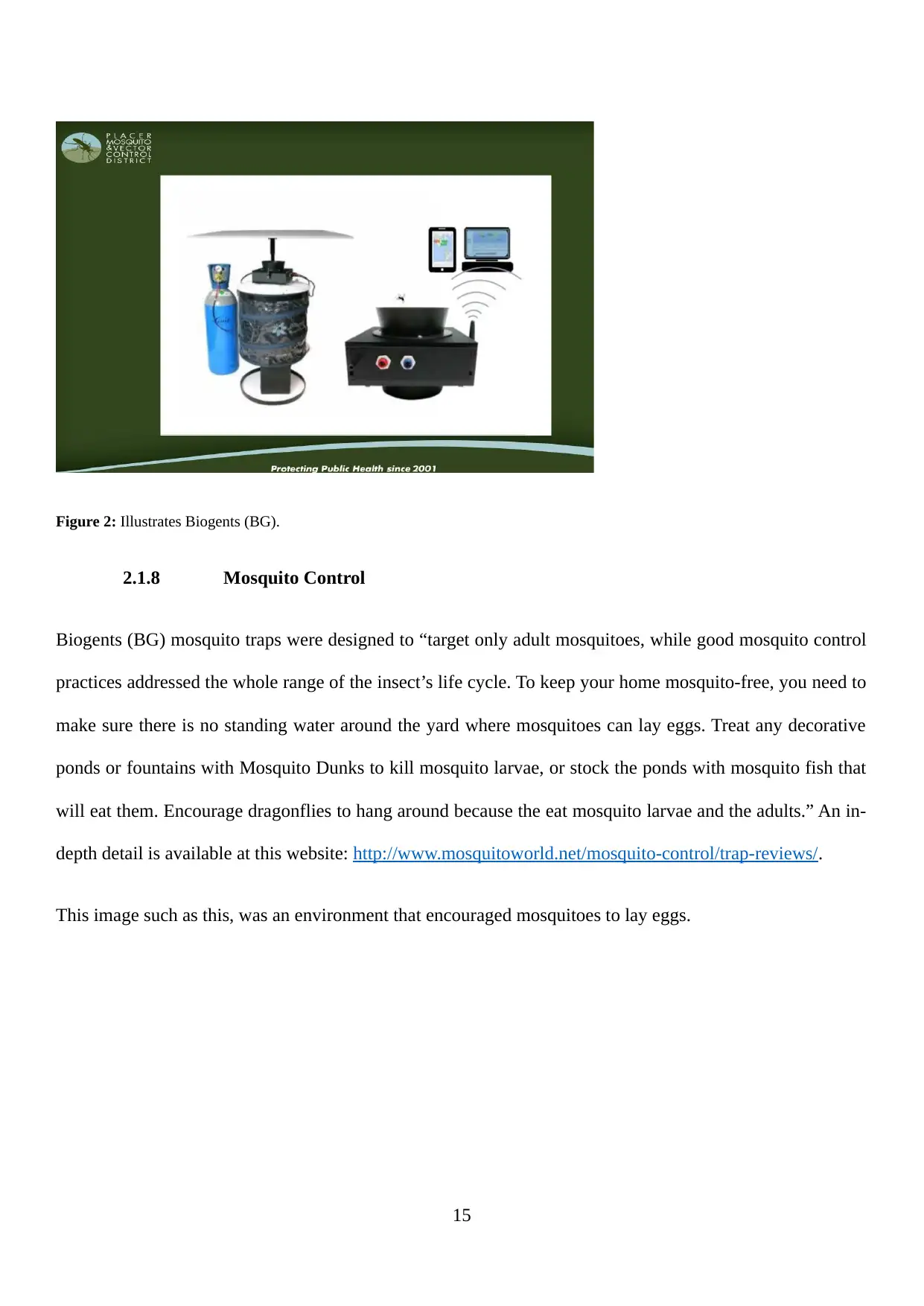
2.1.8 Mosquito Control
Biogents (BG) mosquito traps were designed to “target only adult mosquitoes, while good mosquito control
practices addressed the whole range of the insect’s life cycle. To keep your home mosquito-free, you need to
make sure there is no standing water around the yard where mosquitoes can lay eggs. Treat any decorative
ponds or fountains with Mosquito Dunks to kill mosquito larvae, or stock the ponds with mosquito fish that
will eat them. Encourage dragonflies to hang around because the eat mosquito larvae and the adults.” An in-
depth detail is available at this website: http://www.mosquitoworld.net/mosquito-control/trap-reviews/.
This image such as this, was an environment that encouraged mosquitoes to lay eggs.
15
⊘ This is a preview!⊘
Do you want full access?
Subscribe today to unlock all pages.

Trusted by 1+ million students worldwide
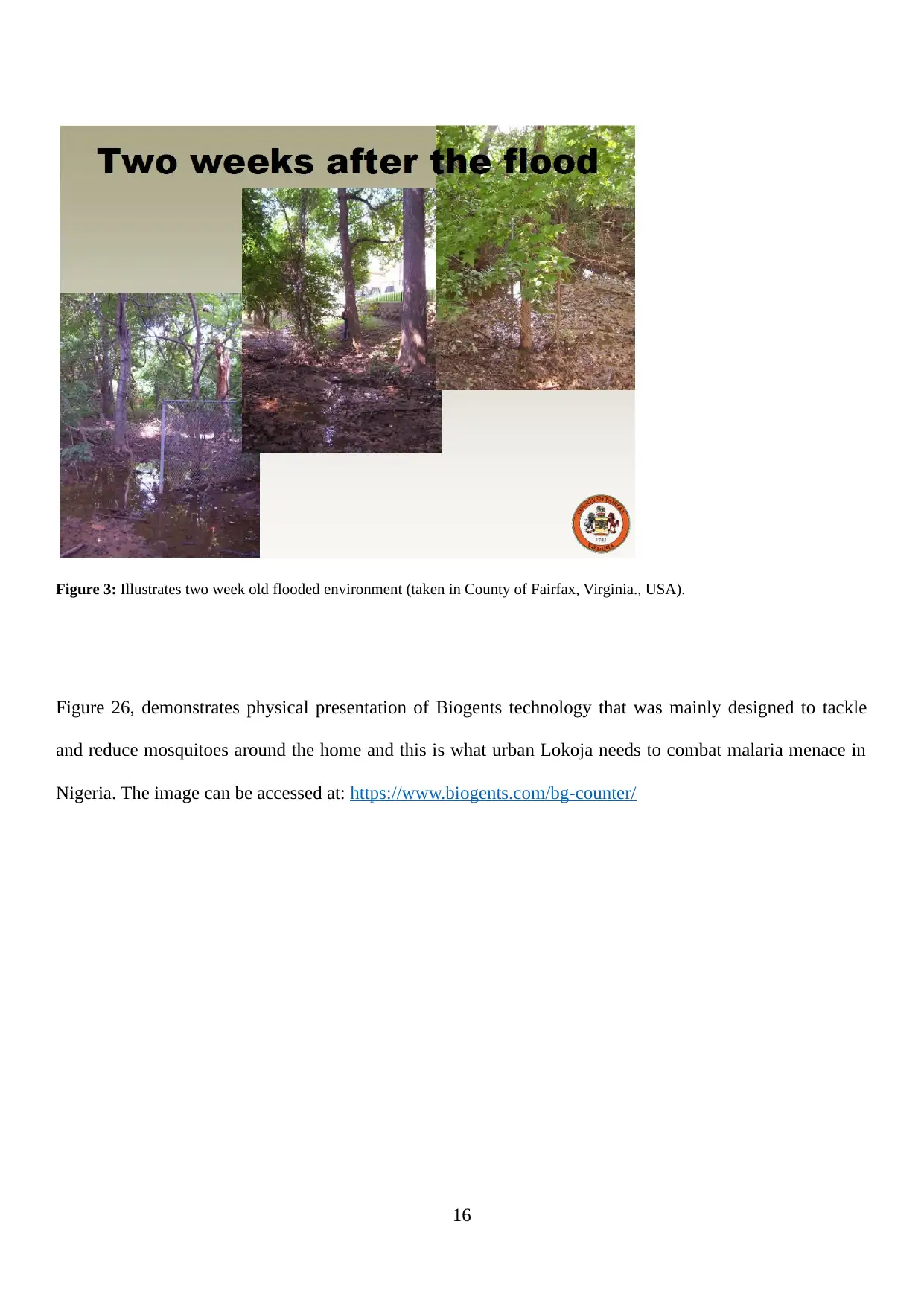
Figure 26, demonstrates physical presentation of Biogents technology that was mainly designed to tackle
and reduce mosquitoes around the home and this is what urban Lokoja needs to combat malaria menace in
Nigeria. The image can be accessed at: https://www.biogents.com/bg-counter/
16
Paraphrase This Document
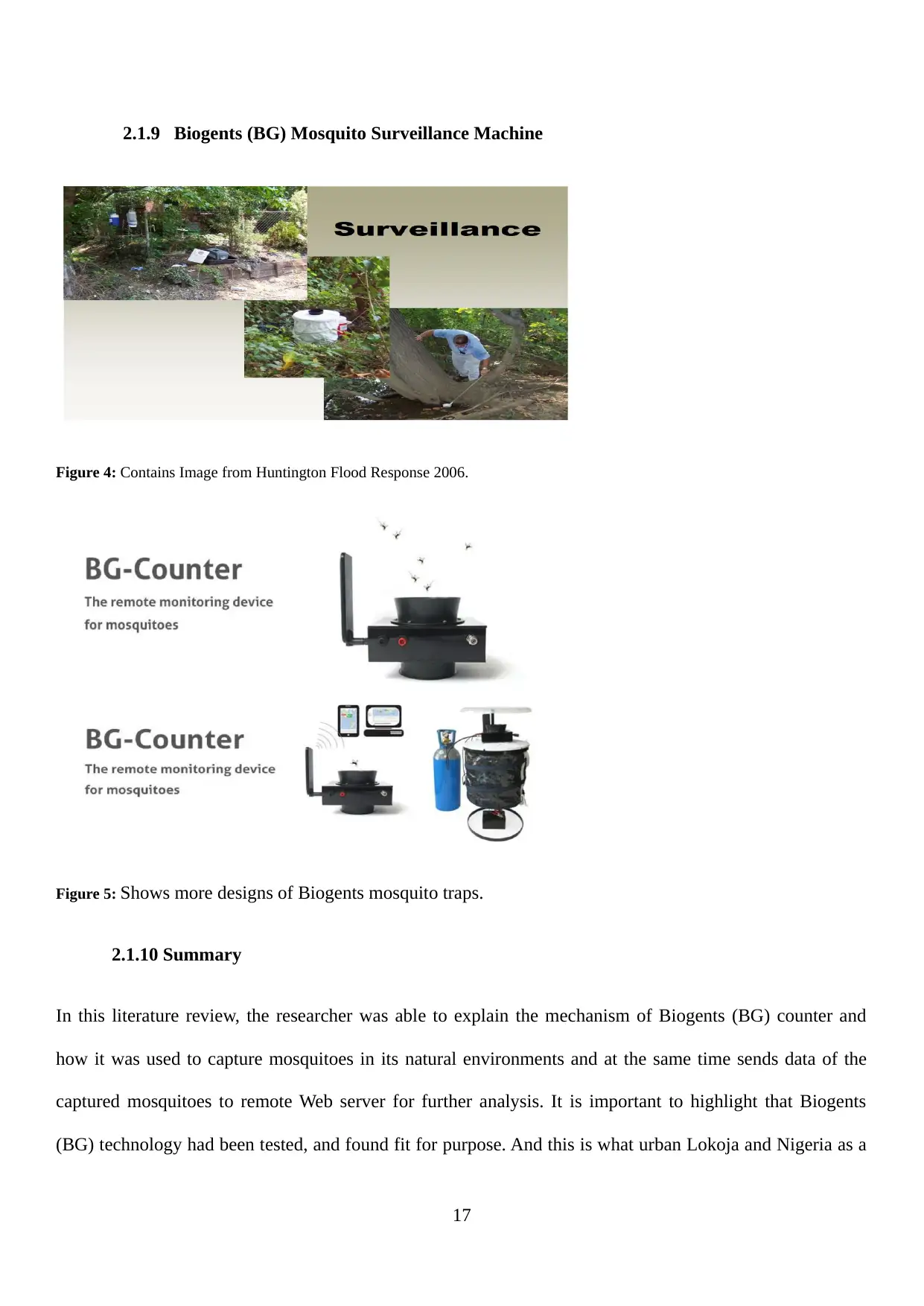
Figure 4: Contains Image from Huntington Flood Response 2006.
Figure 5: Shows more designs of Biogents mosquito traps.
2.1.10 Summary
In this literature review, the researcher was able to explain the mechanism of Biogents (BG) counter and
how it was used to capture mosquitoes in its natural environments and at the same time sends data of the
captured mosquitoes to remote Web server for further analysis. It is important to highlight that Biogents
(BG) technology had been tested, and found fit for purpose. And this is what urban Lokoja and Nigeria as a
17

mosquito traps were designed and produced in Europe. These mosquito traps had been tested at different
locations, notably among the cities was “Camargue” (France). In this village of “600 habitants” the
mosquito trap performance was estimated to be “70%”. Trap efficiency was estimated to be between “74%
and 98%”, and nearly 300,000 mosquitoes were captured between the month of April and November, 2017.
Biogents (BG) counter is found to be efficient, and effective modern innovative technology to capture
mosquitoes without the use of insecticide spray. It has octanol lures that emit CO2 which smells like human
body odour. The body odour would attract mosquitoes from afar nearer to the trap and the fan embedded in
the machine would force the insects into the trap as they close-by, and eventually killed them. This product
can be useful in urban Lokoja to combat mosquito activities in the region.
Ethical Considerations
The purpose of the questionnaire was clearly stated on the questionnaire documentation and face-to-face
interview was conducted with further explanation verbally expressed regarding the questionnaire exercise.
The respondents’ participation in the exercise was voluntary as the researcher was well prepared ahead of
the time. Obviously, this method has formally addressed the moral principles as demanded in this project,
ensuring that the age brackets of the target population are between 18 and 50 above, but below 60 years of
age. This is to determine the accuracy of the report and to draw conclusion from people of sound-mind that
can read between the lines and what the questionnaire aimed to achieve.
Issues of Trustworthiness
The questionnaire method was designed to determine the outcome of sources tagged as ‘as grass root
problems’ as possibilities that may lead to causing malaria parasites. The population of the respondents that
participated in the exercise can be described as adults (18 and above of age), independently minded people
with educational background who are capable to decide what they want, and how they want it from what can
18
⊘ This is a preview!⊘
Do you want full access?
Subscribe today to unlock all pages.

Trusted by 1+ million students worldwide

engaging the services of a multi-media photographer who received financial rewards. The multi-media
photographer was given instructions specifically to address the issues under investigation. The results were
dynamic with imageries essentially providing evidence that the local authorities of urban Lokoja have not
done anything to get rid of dump sites within Lokoja metropolis.
19
Paraphrase This Document
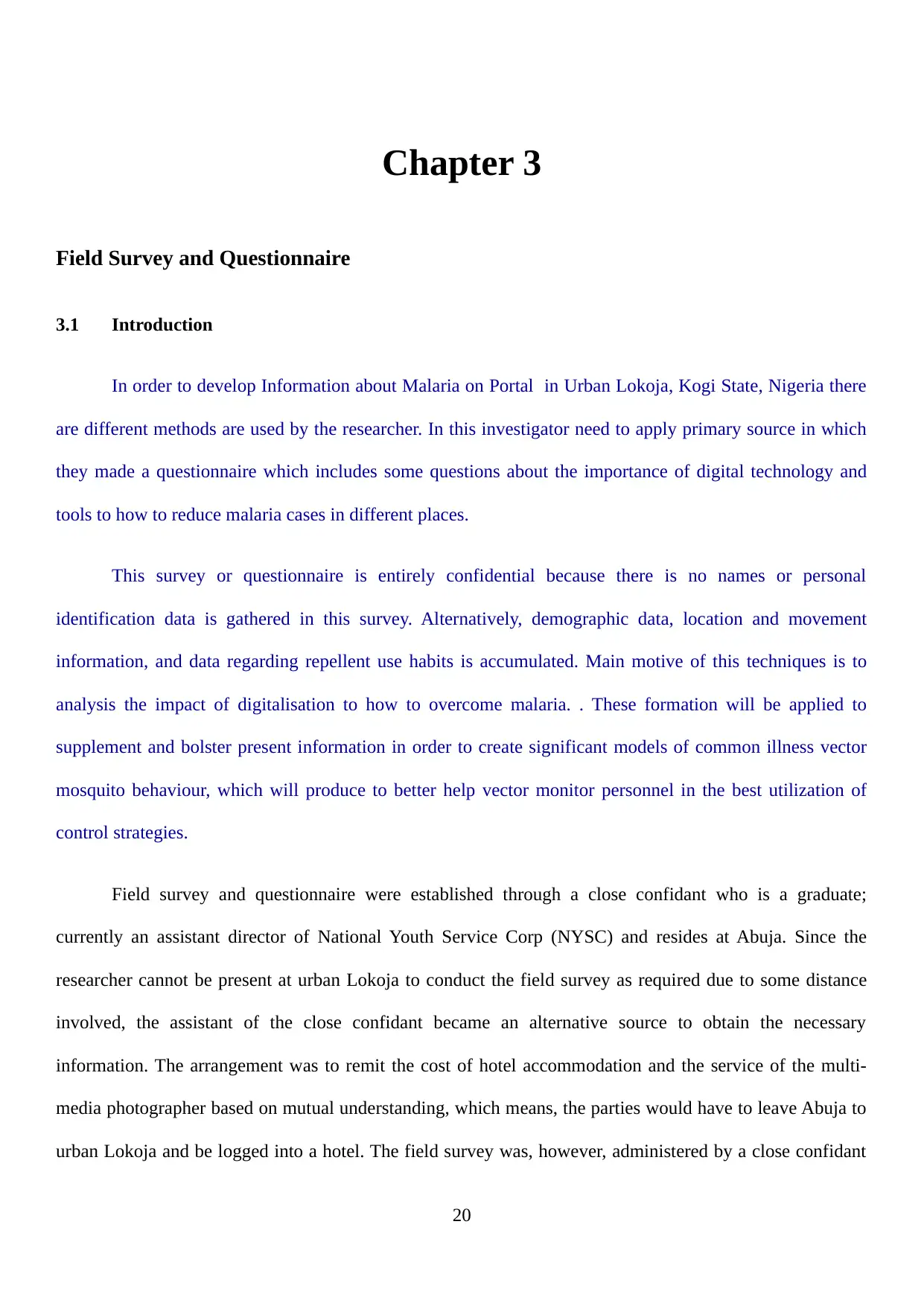
Field Survey and Questionnaire
3.1 Introduction
In order to develop Information about Malaria on Portal in Urban Lokoja, Kogi State, Nigeria there
are different methods are used by the researcher. In this investigator need to apply primary source in which
they made a questionnaire which includes some questions about the importance of digital technology and
tools to how to reduce malaria cases in different places.
This survey or questionnaire is entirely confidential because there is no names or personal
identification data is gathered in this survey. Alternatively, demographic data, location and movement
information, and data regarding repellent use habits is accumulated. Main motive of this techniques is to
analysis the impact of digitalisation to how to overcome malaria. . These formation will be applied to
supplement and bolster present information in order to create significant models of common illness vector
mosquito behaviour, which will produce to better help vector monitor personnel in the best utilization of
control strategies.
Field survey and questionnaire were established through a close confidant who is a graduate;
currently an assistant director of National Youth Service Corp (NYSC) and resides at Abuja. Since the
researcher cannot be present at urban Lokoja to conduct the field survey as required due to some distance
involved, the assistant of the close confidant became an alternative source to obtain the necessary
information. The arrangement was to remit the cost of hotel accommodation and the service of the multi-
media photographer based on mutual understanding, which means, the parties would have to leave Abuja to
urban Lokoja and be logged into a hotel. The field survey was, however, administered by a close confidant
20
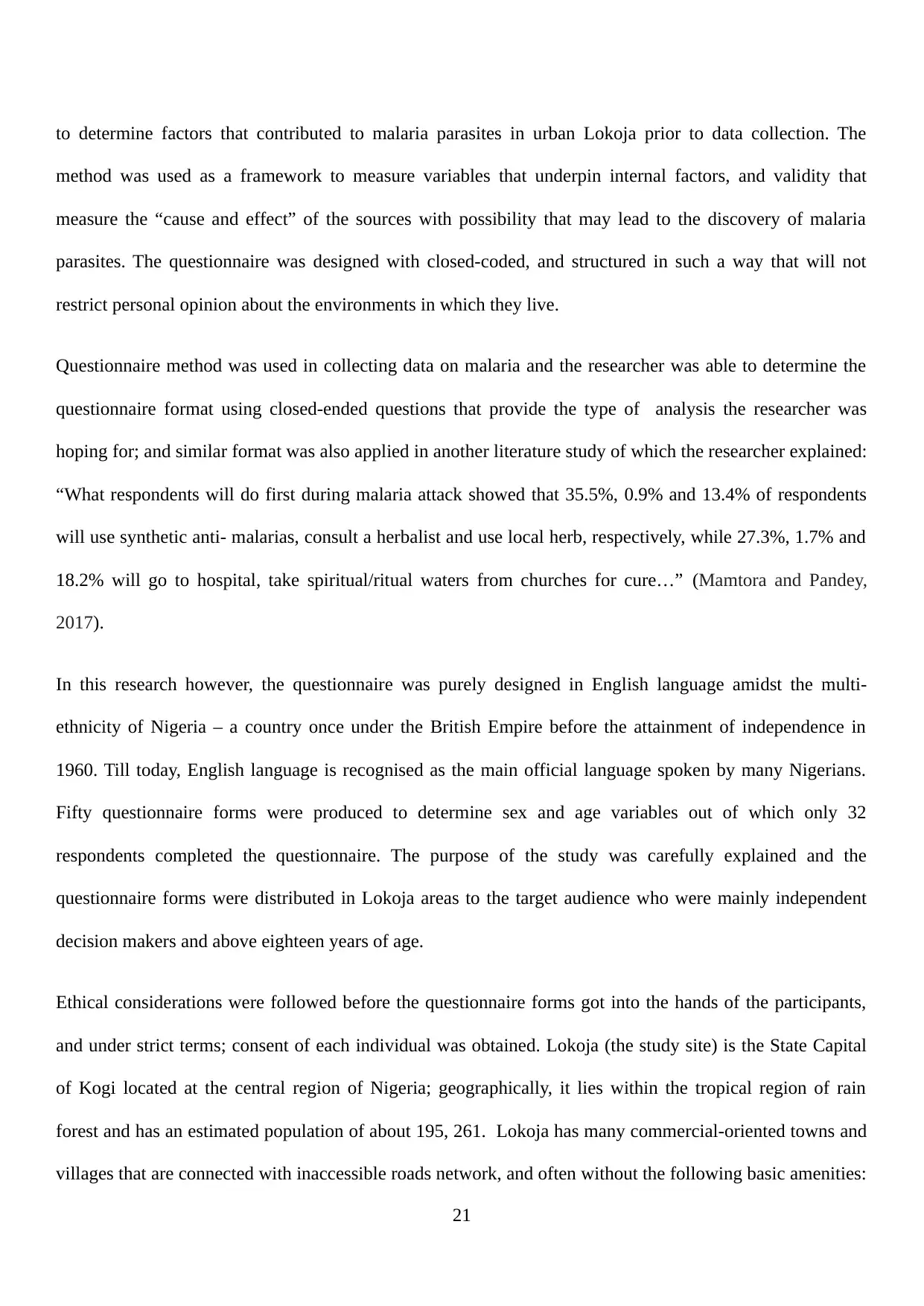
method was used as a framework to measure variables that underpin internal factors, and validity that
measure the “cause and effect” of the sources with possibility that may lead to the discovery of malaria
parasites. The questionnaire was designed with closed-coded, and structured in such a way that will not
restrict personal opinion about the environments in which they live.
Questionnaire method was used in collecting data on malaria and the researcher was able to determine the
questionnaire format using closed-ended questions that provide the type of analysis the researcher was
hoping for; and similar format was also applied in another literature study of which the researcher explained:
“What respondents will do first during malaria attack showed that 35.5%, 0.9% and 13.4% of respondents
will use synthetic anti- malarias, consult a herbalist and use local herb, respectively, while 27.3%, 1.7% and
18.2% will go to hospital, take spiritual/ritual waters from churches for cure…” (Mamtora and Pandey,
2017).
In this research however, the questionnaire was purely designed in English language amidst the multi-
ethnicity of Nigeria – a country once under the British Empire before the attainment of independence in
1960. Till today, English language is recognised as the main official language spoken by many Nigerians.
Fifty questionnaire forms were produced to determine sex and age variables out of which only 32
respondents completed the questionnaire. The purpose of the study was carefully explained and the
questionnaire forms were distributed in Lokoja areas to the target audience who were mainly independent
decision makers and above eighteen years of age.
Ethical considerations were followed before the questionnaire forms got into the hands of the participants,
and under strict terms; consent of each individual was obtained. Lokoja (the study site) is the State Capital
of Kogi located at the central region of Nigeria; geographically, it lies within the tropical region of rain
forest and has an estimated population of about 195, 261. Lokoja has many commercial-oriented towns and
villages that are connected with inaccessible roads network, and often without the following basic amenities:
21
⊘ This is a preview!⊘
Do you want full access?
Subscribe today to unlock all pages.

Trusted by 1+ million students worldwide
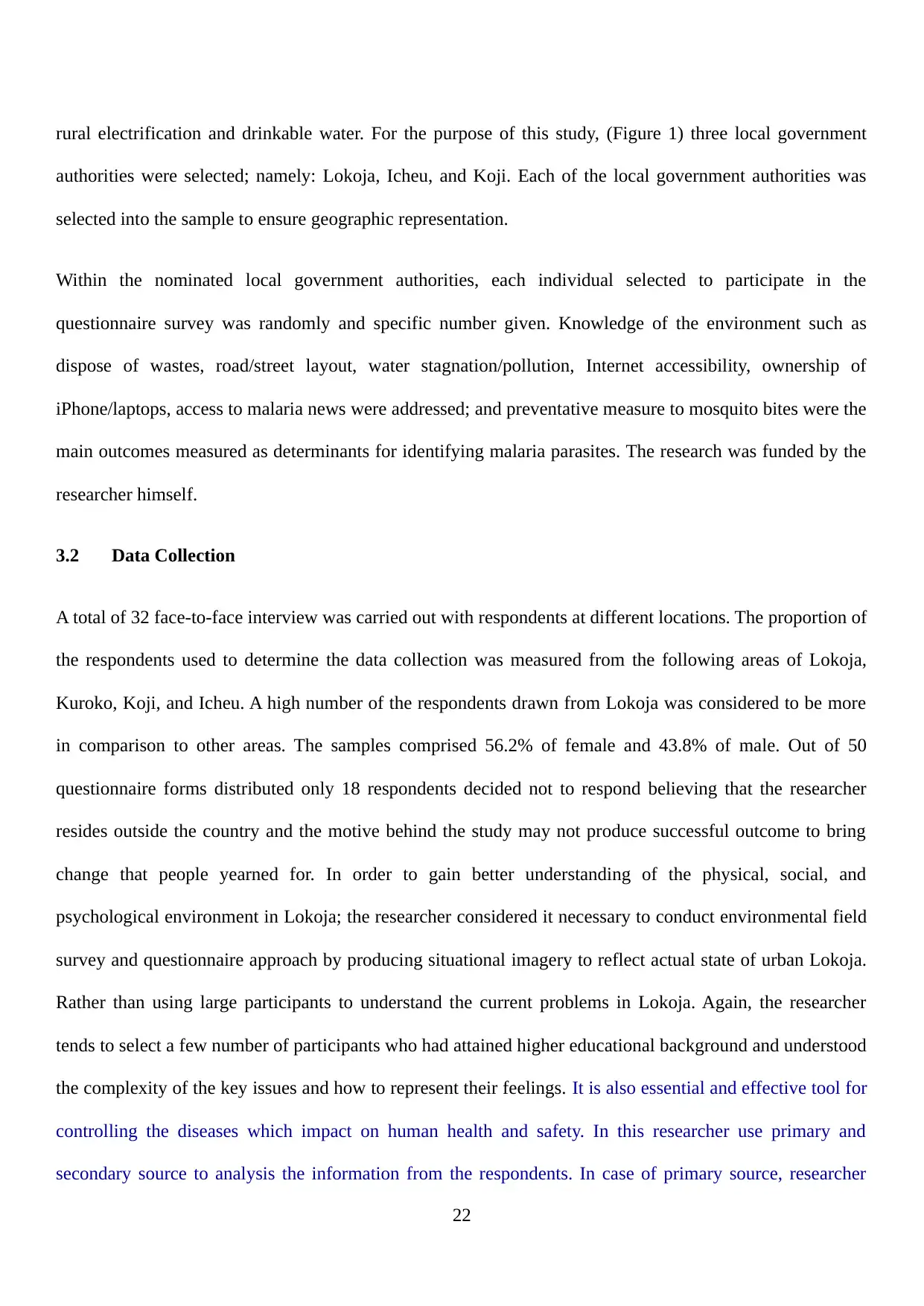
authorities were selected; namely: Lokoja, Icheu, and Koji. Each of the local government authorities was
selected into the sample to ensure geographic representation.
Within the nominated local government authorities, each individual selected to participate in the
questionnaire survey was randomly and specific number given. Knowledge of the environment such as
dispose of wastes, road/street layout, water stagnation/pollution, Internet accessibility, ownership of
iPhone/laptops, access to malaria news were addressed; and preventative measure to mosquito bites were the
main outcomes measured as determinants for identifying malaria parasites. The research was funded by the
researcher himself.
3.2 Data Collection
A total of 32 face-to-face interview was carried out with respondents at different locations. The proportion of
the respondents used to determine the data collection was measured from the following areas of Lokoja,
Kuroko, Koji, and Icheu. A high number of the respondents drawn from Lokoja was considered to be more
in comparison to other areas. The samples comprised 56.2% of female and 43.8% of male. Out of 50
questionnaire forms distributed only 18 respondents decided not to respond believing that the researcher
resides outside the country and the motive behind the study may not produce successful outcome to bring
change that people yearned for. In order to gain better understanding of the physical, social, and
psychological environment in Lokoja; the researcher considered it necessary to conduct environmental field
survey and questionnaire approach by producing situational imagery to reflect actual state of urban Lokoja.
Rather than using large participants to understand the current problems in Lokoja. Again, the researcher
tends to select a few number of participants who had attained higher educational background and understood
the complexity of the key issues and how to represent their feelings. It is also essential and effective tool for
controlling the diseases which impact on human health and safety. In this researcher use primary and
secondary source to analysis the information from the respondents. In case of primary source, researcher
22
Paraphrase This Document

secondary source, researcher need read magazines, books, articles and many other publication research. All
these are useful and appropriate for gathering data from the respondents about the Development of Malaria
Information Portal in the fight against Malaria in Urban Lokoja.
3.3 Questionnaire
Questionnaire technique was used to collect data in order to understand the primary cause of malaria
parasites which led to malaria borne diseases in urban Lokoja. Main purpose of preparing questionnaire is to
identify the perception and opinion of respondents about the importance of different system regarding how
to reduce mosquito effects in the environment. It is a malaria virus case and represent a serious public health
issue that transport infectious illness such as yellow fever, measles, diarrhoea, cholera and many other.
23
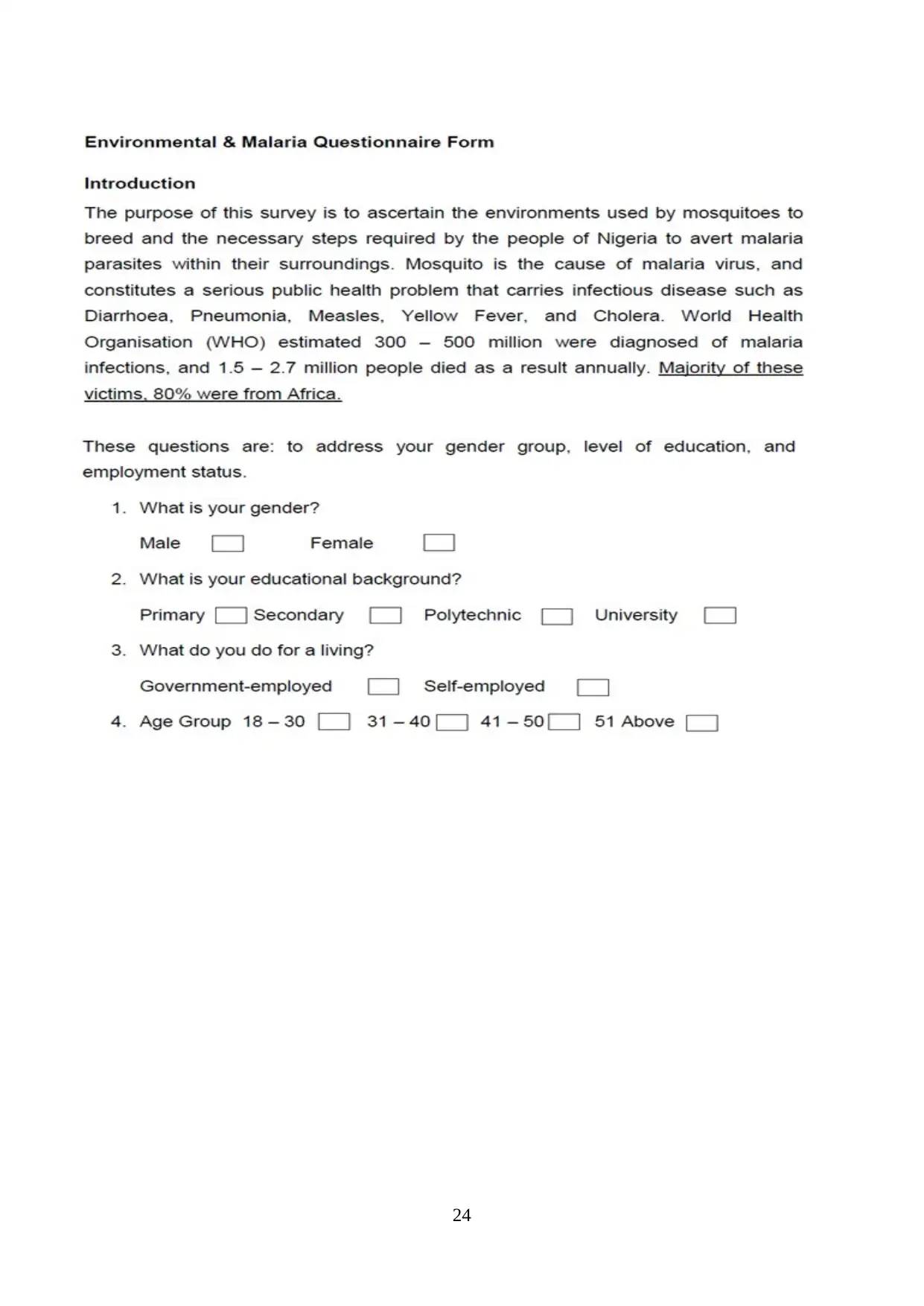
⊘ This is a preview!⊘
Do you want full access?
Subscribe today to unlock all pages.

Trusted by 1+ million students worldwide
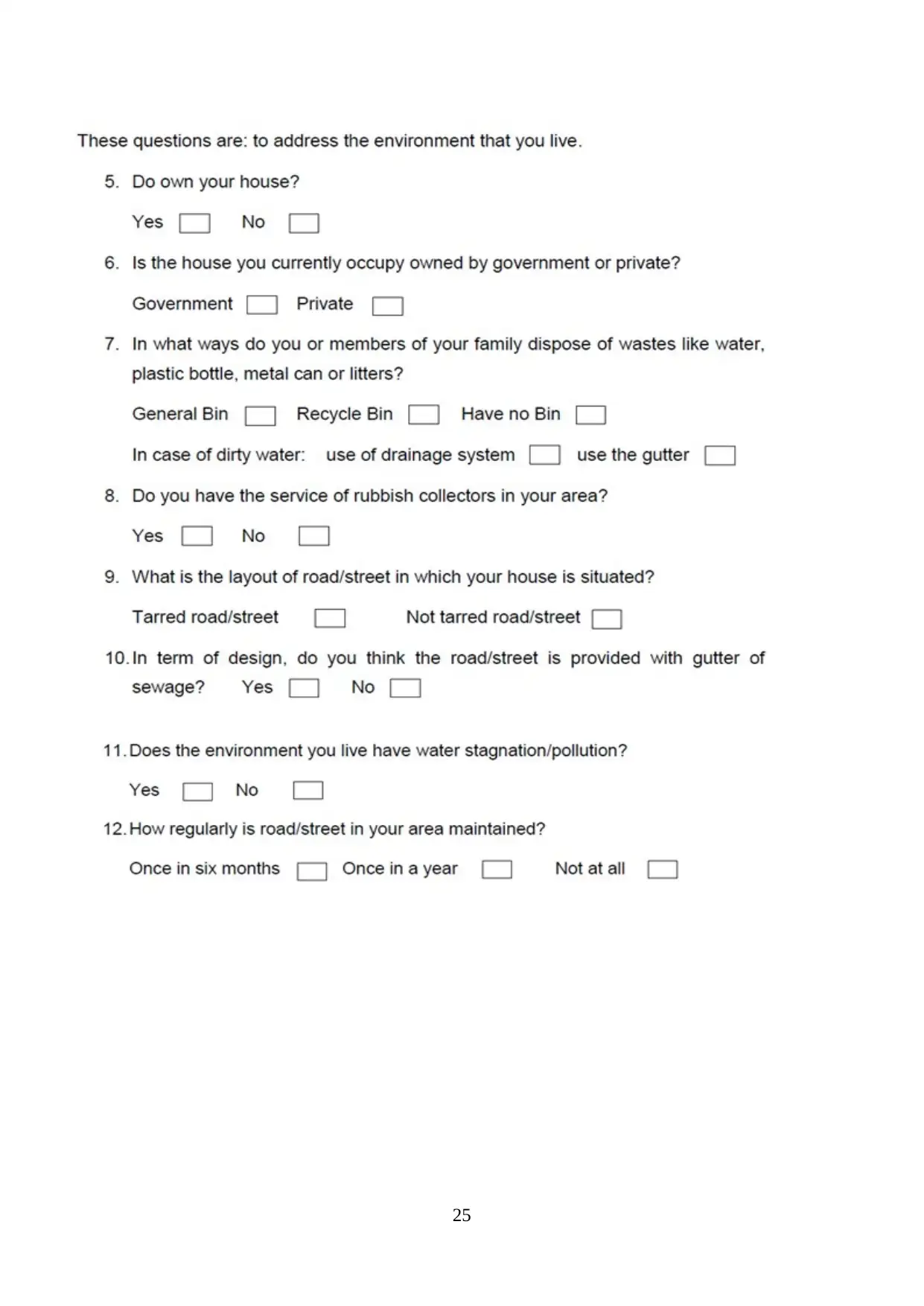
Paraphrase This Document
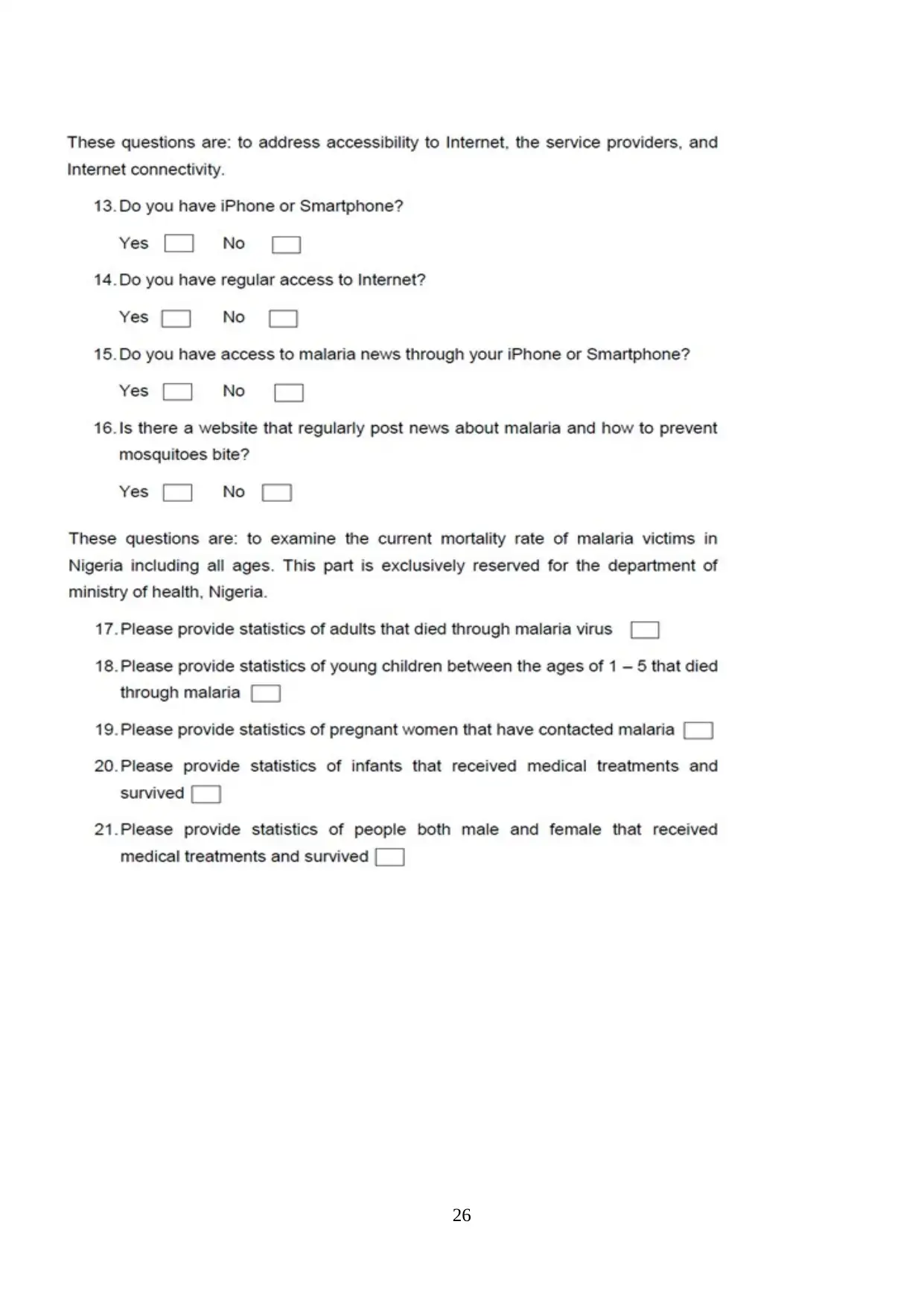
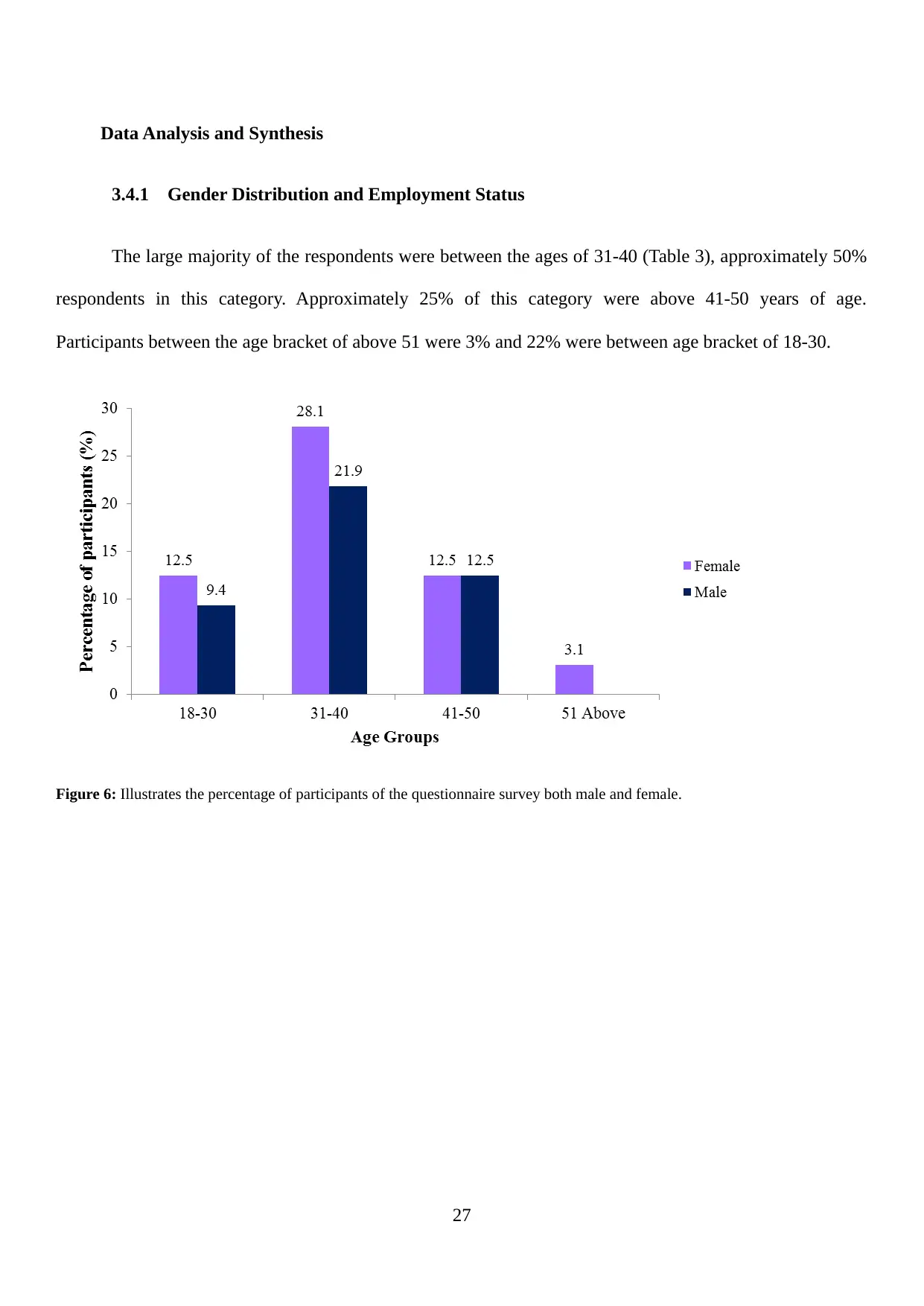
3.4.1 Gender Distribution and Employment Status
The large majority of the respondents were between the ages of 31-40 (Table 3), approximately 50%
respondents in this category. Approximately 25% of this category were above 41-50 years of age.
Participants between the age bracket of above 51 were 3% and 22% were between age bracket of 18-30.
Figure 6: Illustrates the percentage of participants of the questionnaire survey both male and female.
27
⊘ This is a preview!⊘
Do you want full access?
Subscribe today to unlock all pages.

Trusted by 1+ million students worldwide
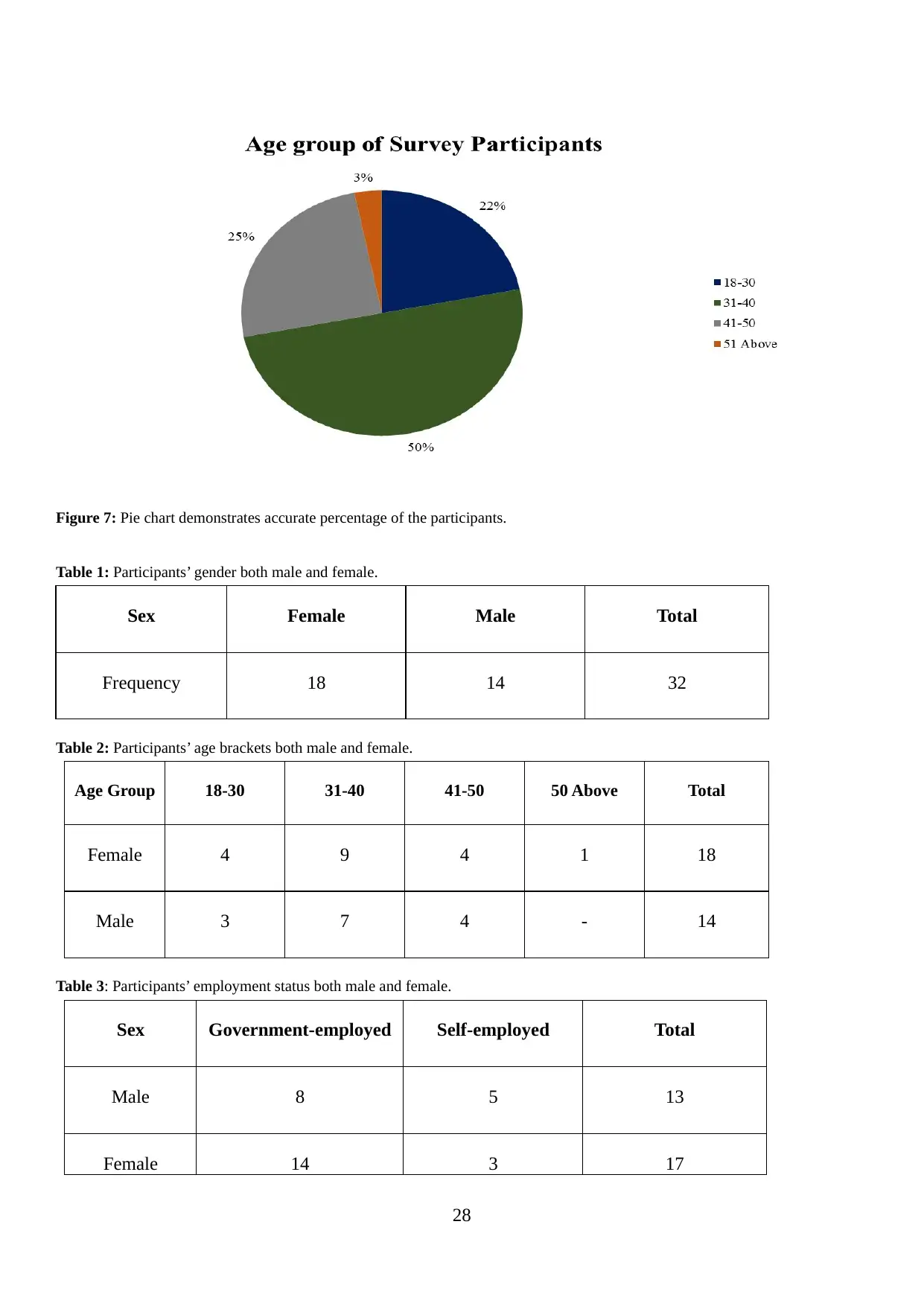
Table 1: Participants’ gender both male and female.
Sex Female Male Total
Frequency 18 14 32
Table 2: Participants’ age brackets both male and female.
Age Group 18-30 31-40 41-50 50 Above Total
Female 4 9 4 1 18
Male 3 7 4 - 14
Table 3: Participants’ employment status both male and female.
Sex Government-employed Self-employed Total
Male 8 5 13
Female 14 3 17
28
Paraphrase This Document
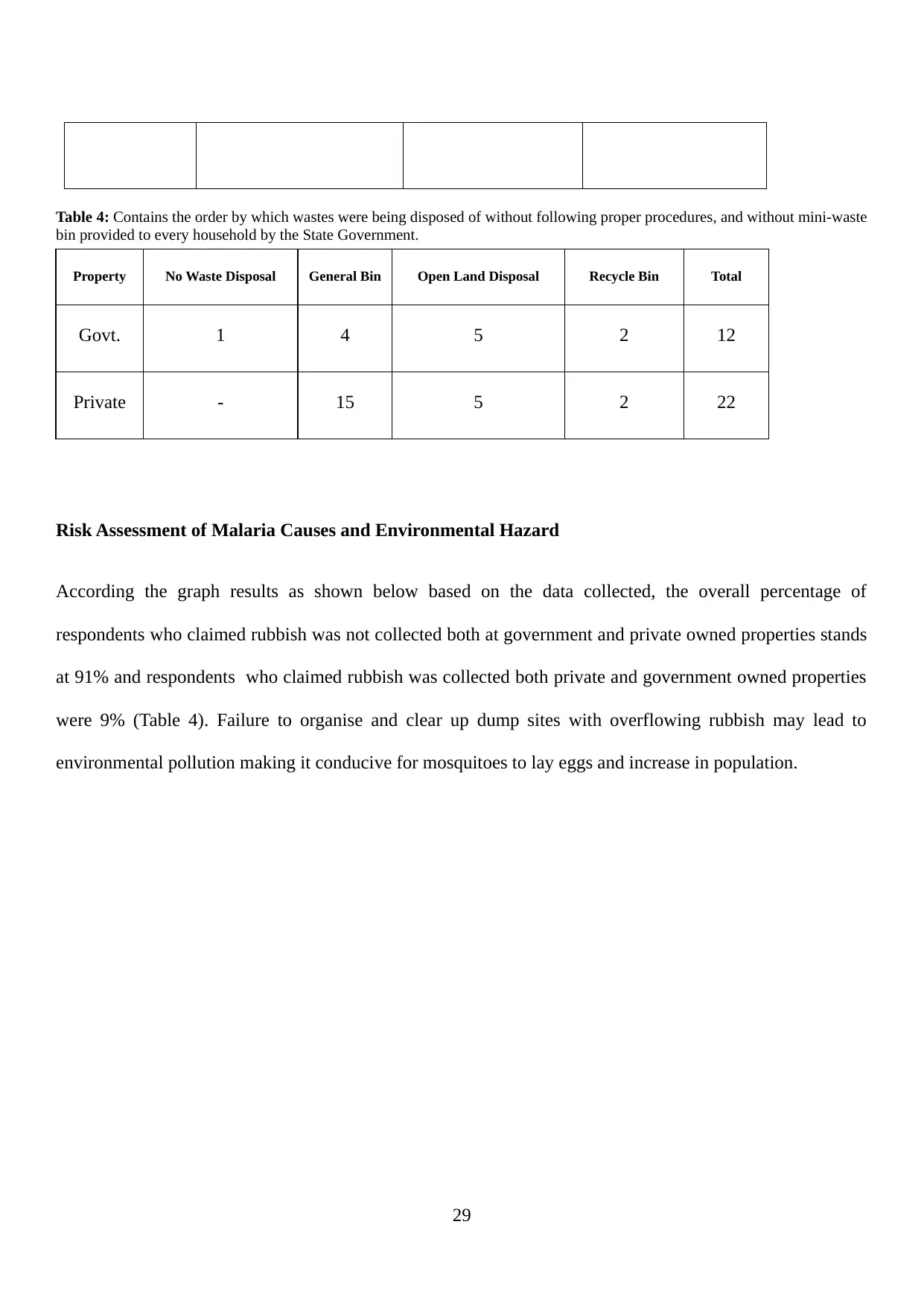
bin provided to every household by the State Government.
Property No Waste Disposal General Bin Open Land Disposal Recycle Bin Total
Govt. 1 4 5 2 12
Private - 15 5 2 22
Risk Assessment of Malaria Causes and Environmental Hazard
According the graph results as shown below based on the data collected, the overall percentage of
respondents who claimed rubbish was not collected both at government and private owned properties stands
at 91% and respondents who claimed rubbish was collected both private and government owned properties
were 9% (Table 4). Failure to organise and clear up dump sites with overflowing rubbish may lead to
environmental pollution making it conducive for mosquitoes to lay eggs and increase in population.
29

The pie chart indicates below clearly interprets the above graph with proving statistic that represents the
state of minds of the respondents who filled the questionnaire that determined holistic view of
environmental pollution in Lokoja town to ascertain the probability of environments that influenced malaria
parasites in urban Lokoja.
Figure 9: Pie Chart is used to calculate the percentage of figure 30 of the rubbish distribution.
30
⊘ This is a preview!⊘
Do you want full access?
Subscribe today to unlock all pages.

Trusted by 1+ million students worldwide
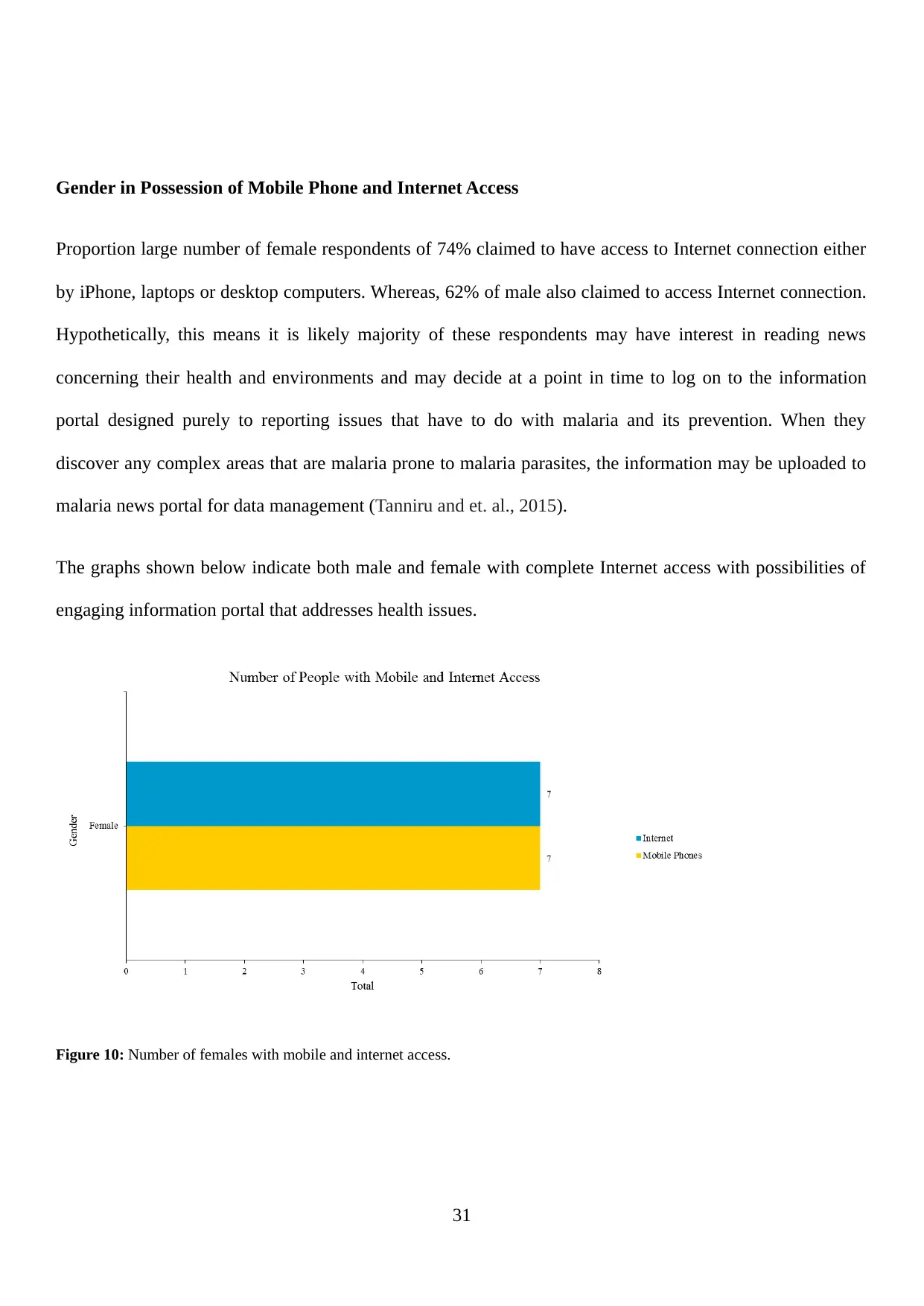
Proportion large number of female respondents of 74% claimed to have access to Internet connection either
by iPhone, laptops or desktop computers. Whereas, 62% of male also claimed to access Internet connection.
Hypothetically, this means it is likely majority of these respondents may have interest in reading news
concerning their health and environments and may decide at a point in time to log on to the information
portal designed purely to reporting issues that have to do with malaria and its prevention. When they
discover any complex areas that are malaria prone to malaria parasites, the information may be uploaded to
malaria news portal for data management (Tanniru and et. al., 2015).
The graphs shown below indicate both male and female with complete Internet access with possibilities of
engaging information portal that addresses health issues.
Figure 10: Number of females with mobile and internet access.
31
Paraphrase This Document
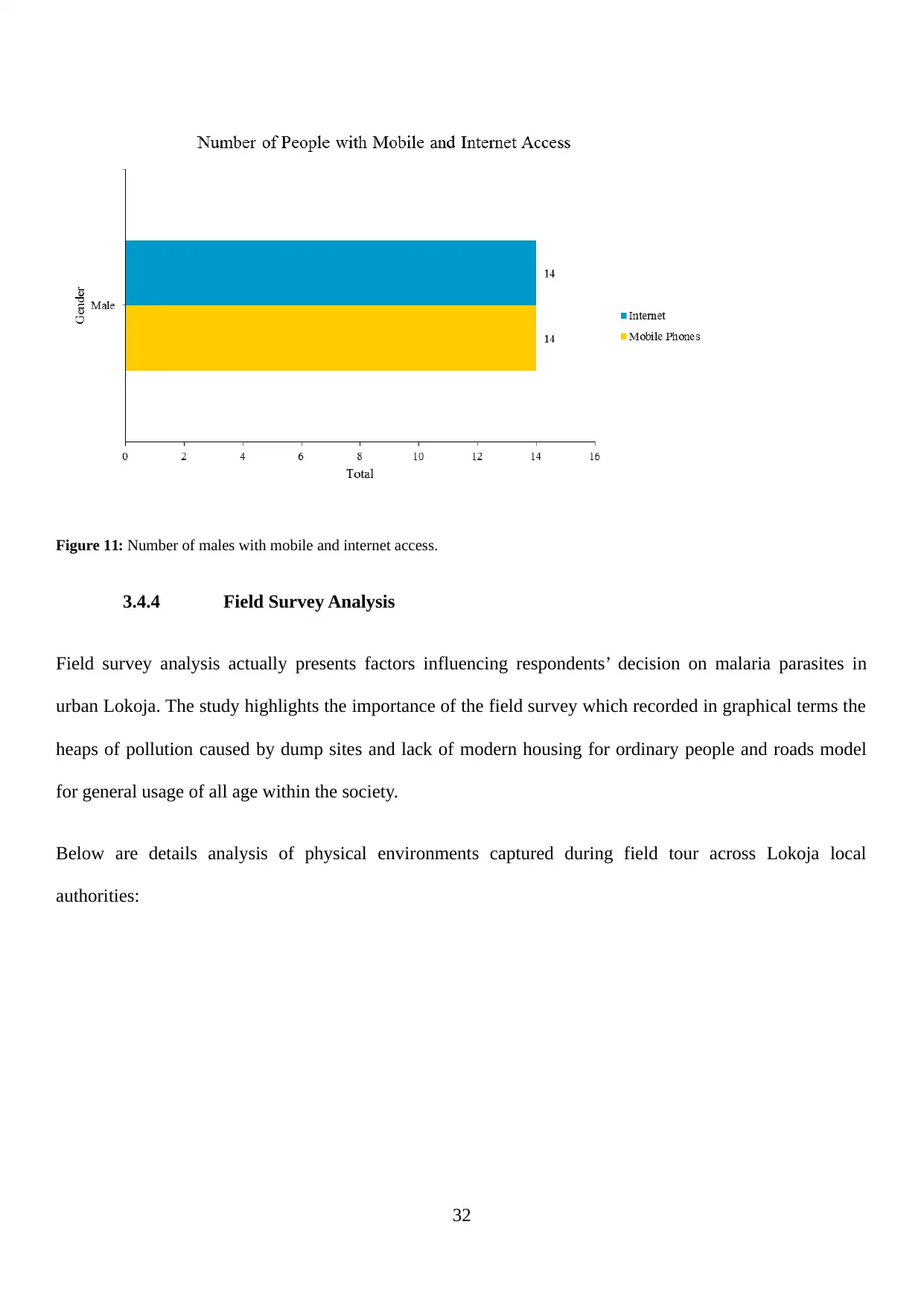
3.4.4 Field Survey Analysis
Field survey analysis actually presents factors influencing respondents’ decision on malaria parasites in
urban Lokoja. The study highlights the importance of the field survey which recorded in graphical terms the
heaps of pollution caused by dump sites and lack of modern housing for ordinary people and roads model
for general usage of all age within the society.
Below are details analysis of physical environments captured during field tour across Lokoja local
authorities:
32

abandoned, yet in use by motorists.
Figure 13: This image was also recorded during field survey at urban Lokoja indicating a state of bad road but at different
location.
The state of these roads is completely bad and has extreme implication on the status of the state capital of
Kogi. The condition of these roads basically formed parts of the environments used by mosquitoes to deposit
eggs during the rainy season. This was why it has always been difficult to get rid of mosquitoes in most West
African countries ( Swartz, 2013). The imagery present the appalling state of urban Lokoja is a living
example. It appears Lokoja municipalities have been inundated with matters that superseded the
phenomenon of bad roads within the state capital in which there was a total neglect.
33
⊘ This is a preview!⊘
Do you want full access?
Subscribe today to unlock all pages.

Trusted by 1+ million students worldwide
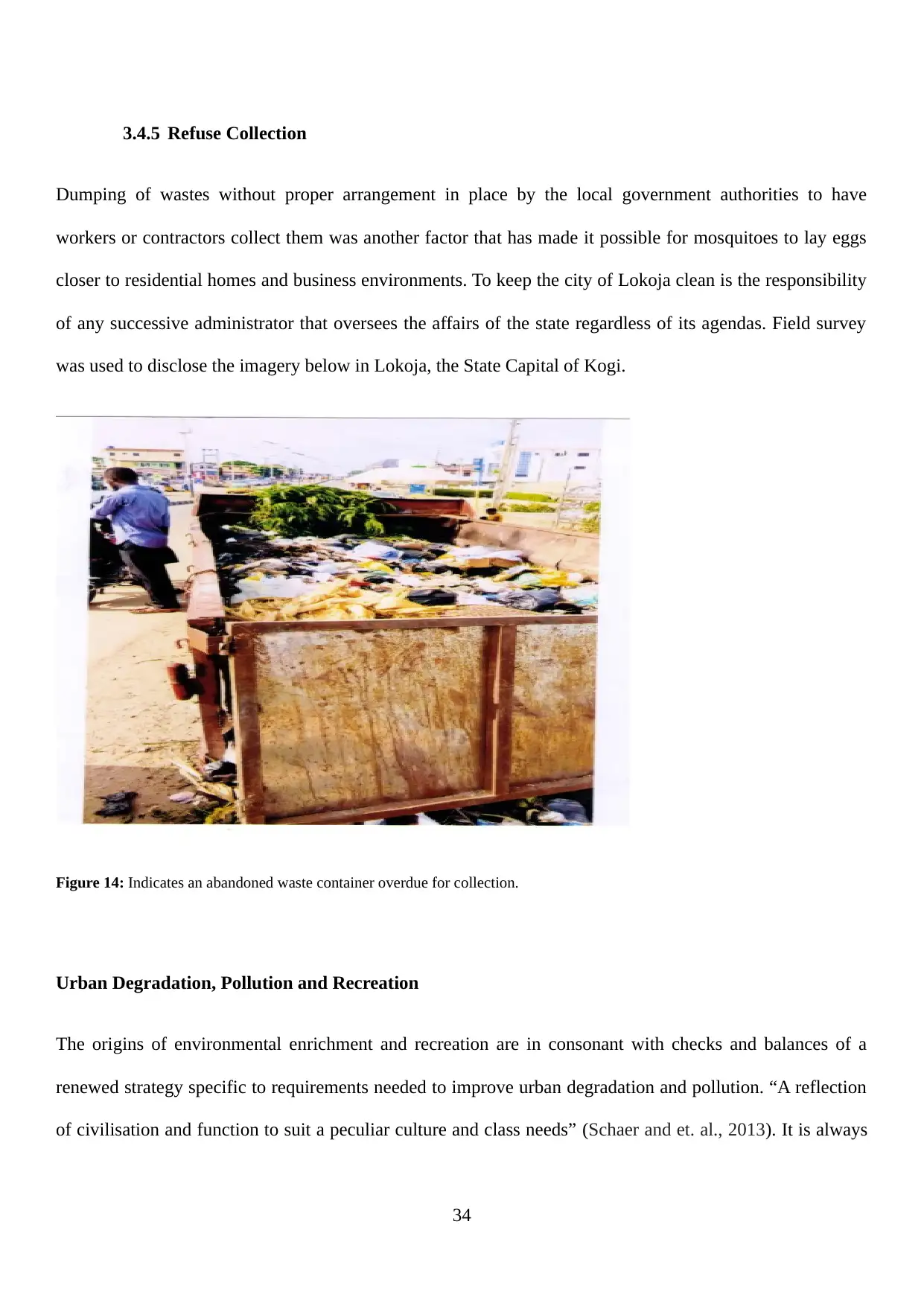
Dumping of wastes without proper arrangement in place by the local government authorities to have
workers or contractors collect them was another factor that has made it possible for mosquitoes to lay eggs
closer to residential homes and business environments. To keep the city of Lokoja clean is the responsibility
of any successive administrator that oversees the affairs of the state regardless of its agendas. Field survey
was used to disclose the imagery below in Lokoja, the State Capital of Kogi.
Figure 14: Indicates an abandoned waste container overdue for collection.
Urban Degradation, Pollution and Recreation
The origins of environmental enrichment and recreation are in consonant with checks and balances of a
renewed strategy specific to requirements needed to improve urban degradation and pollution. “A reflection
of civilisation and function to suit a peculiar culture and class needs” (Schaer and et. al., 2013). It is always
34
Paraphrase This Document
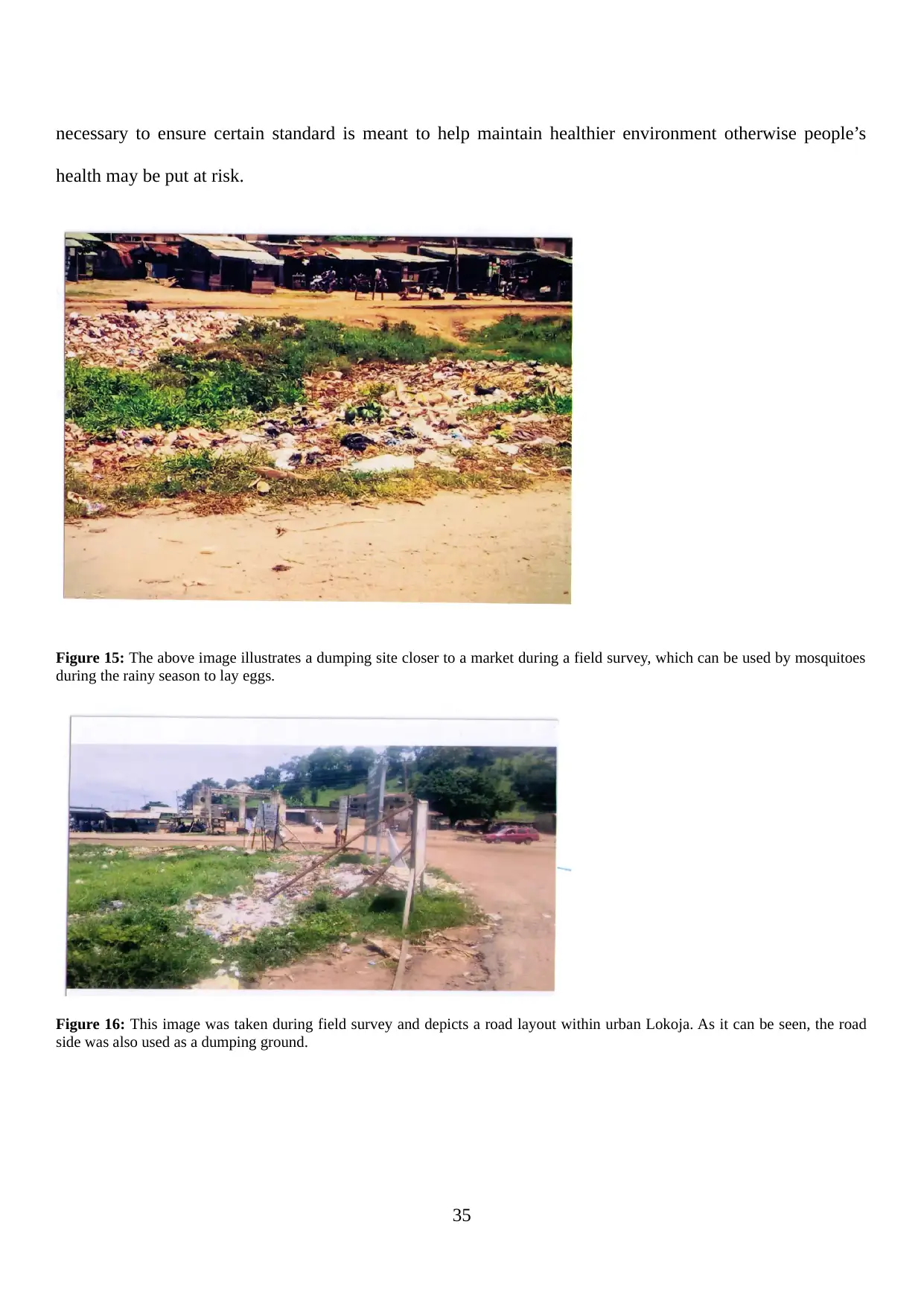
health may be put at risk.
Figure 15: The above image illustrates a dumping site closer to a market during a field survey, which can be used by mosquitoes
during the rainy season to lay eggs.
Figure 16: This image was taken during field survey and depicts a road layout within urban Lokoja. As it can be seen, the road
side was also used as a dumping ground.
35

Figure 37 - 38 present imagery of field assessments which identified dump sites that have capacity to
influence mosquito population on annual basis. Thus, limit the efforts of philanthropists, who, by virtue of
sheer determination, came to Africa to wage war against malaria (Poulakou, Bassetti and Timsit, 2016.). The
issue of malaria vector must be considered as something serious, as matter of facts deadly by the State
Government with intent to find immediate solutions to overcome the frequency of malaria in urban Lokoja.
Urban Planning and Integration
The fight against malaria can be gleaned from other perspective such as poor environment, bad roads and
poor housing, which can be interpreted as grass root problems. Grass root problems could be the results of
under development, and modest improvement to areas occupied by ordinary people of urban Lokoja. This is
something that the people in charge of local authorities should aspire to achieve during tenure of office.
However, this approach requires meticulous planning and the study of environments that constitute as major
risks to urban Lokoja. To borrow a leaf; the proximity and the rapid development of Abuja, the Federal
Capital of Nigeria (FCN) was more than enough to bring into practice what was achieved that is worthy of
emulation in Kogi State (Mwesigwa, 2013).
World Health Organisation (WHO) reported in 2015 that “an estimated 663 million cases were prevented in
sub-Saharan Africa between 2001 and 2015” (Omeluzor, Oyovwe-Tinuoye and Emeka-Ukwu, 2017). With
the dumping of wastes at the heart of State Capital of Kogi, it seems difficult to eradicate very fast malaria
issues in urban Lokoja. Unless measures to remove all dumping sites can be implemented immediately, and
this should not be one-off action – it must be a continuous exercise, which requires level of consistence from
upper arms of the State judiciary and the government itself (Yuthavong and et. al., 2012) explained,
“Measures for epidemic prevention and control can be implemented effectively only if they are supported by
36
⊘ This is a preview!⊘
Do you want full access?
Subscribe today to unlock all pages.

Trusted by 1+ million students worldwide
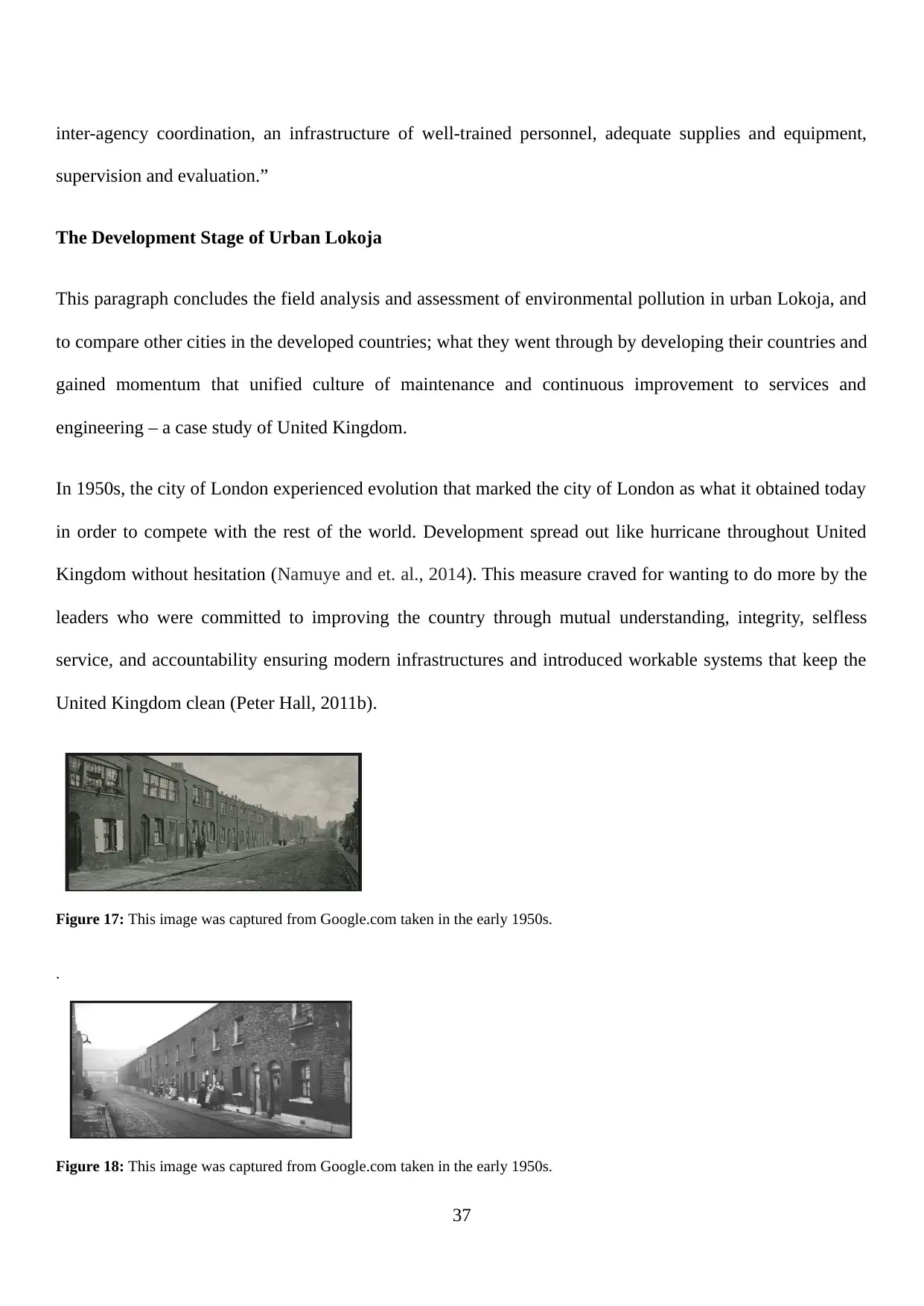
supervision and evaluation.”
The Development Stage of Urban Lokoja
This paragraph concludes the field analysis and assessment of environmental pollution in urban Lokoja, and
to compare other cities in the developed countries; what they went through by developing their countries and
gained momentum that unified culture of maintenance and continuous improvement to services and
engineering – a case study of United Kingdom.
In 1950s, the city of London experienced evolution that marked the city of London as what it obtained today
in order to compete with the rest of the world. Development spread out like hurricane throughout United
Kingdom without hesitation (Namuye and et. al., 2014). This measure craved for wanting to do more by the
leaders who were committed to improving the country through mutual understanding, integrity, selfless
service, and accountability ensuring modern infrastructures and introduced workable systems that keep the
United Kingdom clean (Peter Hall, 2011b).
Figure 17: This image was captured from Google.com taken in the early 1950s.
.
Figure 18: This image was captured from Google.com taken in the early 1950s.
37
Paraphrase This Document
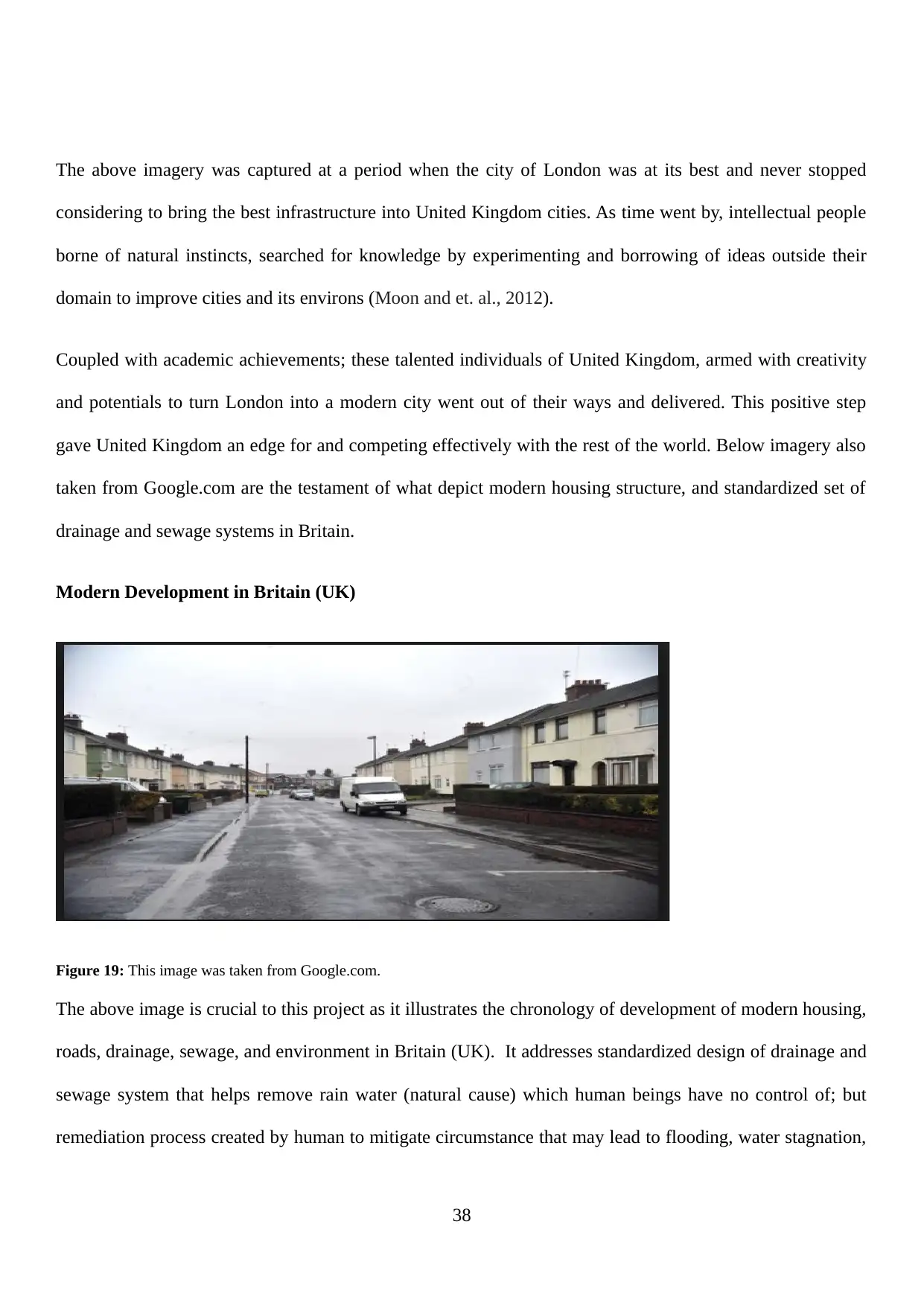
considering to bring the best infrastructure into United Kingdom cities. As time went by, intellectual people
borne of natural instincts, searched for knowledge by experimenting and borrowing of ideas outside their
domain to improve cities and its environs (Moon and et. al., 2012).
Coupled with academic achievements; these talented individuals of United Kingdom, armed with creativity
and potentials to turn London into a modern city went out of their ways and delivered. This positive step
gave United Kingdom an edge for and competing effectively with the rest of the world. Below imagery also
taken from Google.com are the testament of what depict modern housing structure, and standardized set of
drainage and sewage systems in Britain.
Modern Development in Britain (UK)
Figure 19: This image was taken from Google.com.
The above image is crucial to this project as it illustrates the chronology of development of modern housing,
roads, drainage, sewage, and environment in Britain (UK). It addresses standardized design of drainage and
sewage system that helps remove rain water (natural cause) which human beings have no control of; but
remediation process created by human to mitigate circumstance that may lead to flooding, water stagnation,
38
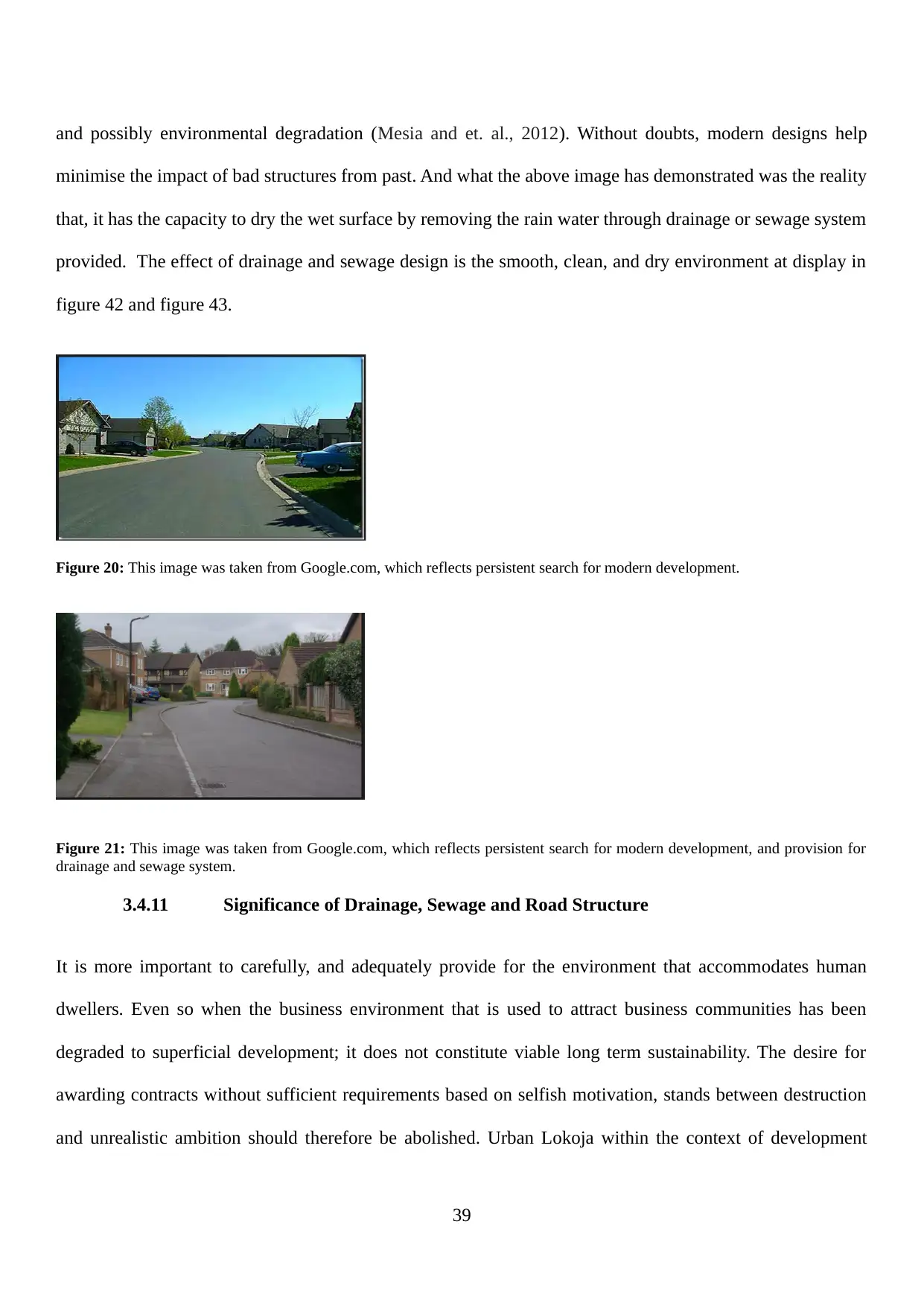
minimise the impact of bad structures from past. And what the above image has demonstrated was the reality
that, it has the capacity to dry the wet surface by removing the rain water through drainage or sewage system
provided. The effect of drainage and sewage design is the smooth, clean, and dry environment at display in
figure 42 and figure 43.
Figure 20: This image was taken from Google.com, which reflects persistent search for modern development.
Figure 21: This image was taken from Google.com, which reflects persistent search for modern development, and provision for
drainage and sewage system.
3.4.11 Significance of Drainage, Sewage and Road Structure
It is more important to carefully, and adequately provide for the environment that accommodates human
dwellers. Even so when the business environment that is used to attract business communities has been
degraded to superficial development; it does not constitute viable long term sustainability. The desire for
awarding contracts without sufficient requirements based on selfish motivation, stands between destruction
and unrealistic ambition should therefore be abolished. Urban Lokoja within the context of development
39
⊘ This is a preview!⊘
Do you want full access?
Subscribe today to unlock all pages.

Trusted by 1+ million students worldwide
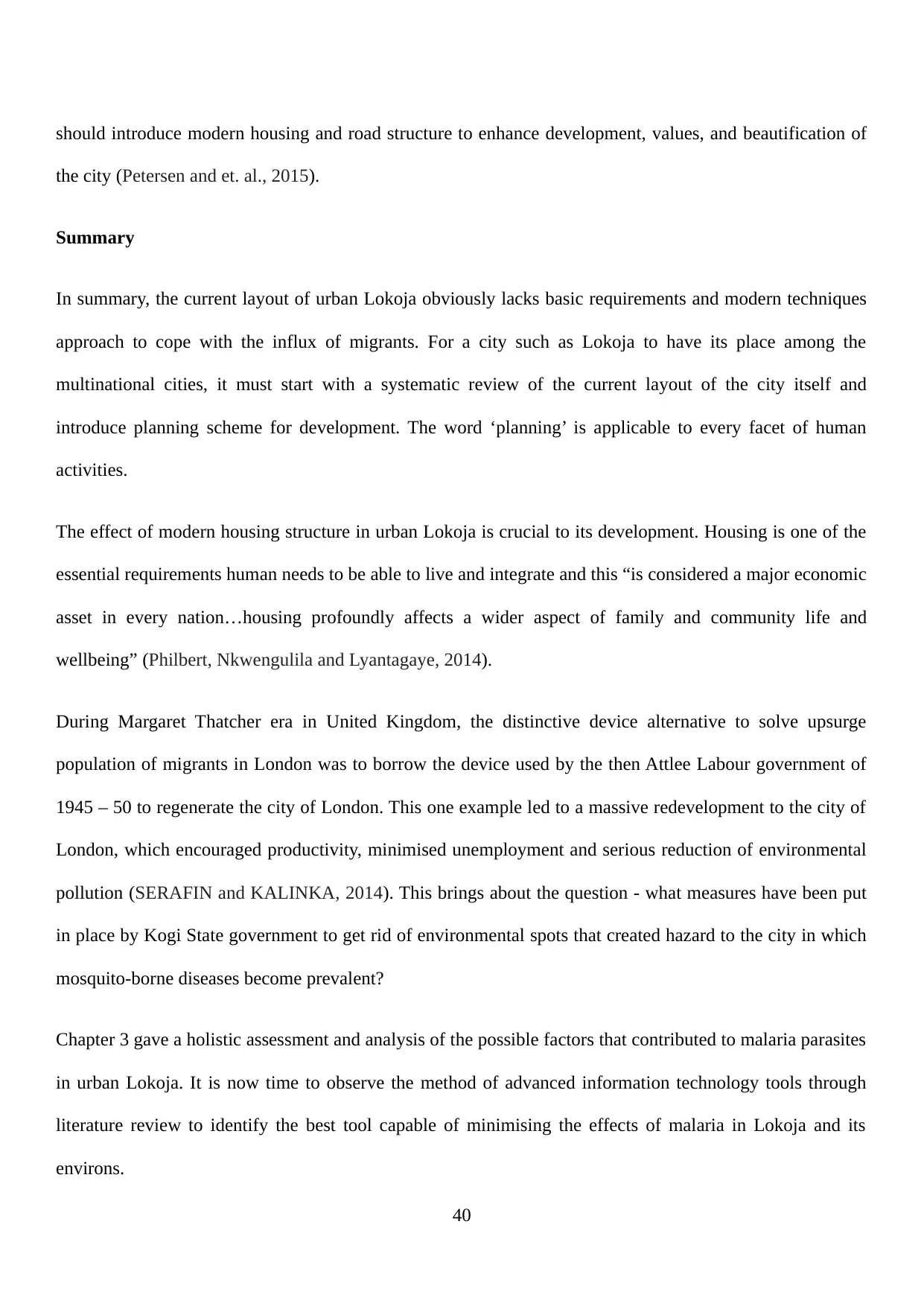
the city (Petersen and et. al., 2015).
Summary
In summary, the current layout of urban Lokoja obviously lacks basic requirements and modern techniques
approach to cope with the influx of migrants. For a city such as Lokoja to have its place among the
multinational cities, it must start with a systematic review of the current layout of the city itself and
introduce planning scheme for development. The word ‘planning’ is applicable to every facet of human
activities.
The effect of modern housing structure in urban Lokoja is crucial to its development. Housing is one of the
essential requirements human needs to be able to live and integrate and this “is considered a major economic
asset in every nation…housing profoundly affects a wider aspect of family and community life and
wellbeing” (Philbert, Nkwengulila and Lyantagaye, 2014).
During Margaret Thatcher era in United Kingdom, the distinctive device alternative to solve upsurge
population of migrants in London was to borrow the device used by the then Attlee Labour government of
1945 – 50 to regenerate the city of London. This one example led to a massive redevelopment to the city of
London, which encouraged productivity, minimised unemployment and serious reduction of environmental
pollution (SERAFIN and KALINKA, 2014). This brings about the question - what measures have been put
in place by Kogi State government to get rid of environmental spots that created hazard to the city in which
mosquito-borne diseases become prevalent?
Chapter 3 gave a holistic assessment and analysis of the possible factors that contributed to malaria parasites
in urban Lokoja. It is now time to observe the method of advanced information technology tools through
literature review to identify the best tool capable of minimising the effects of malaria in Lokoja and its
environs.
40
Paraphrase This Document
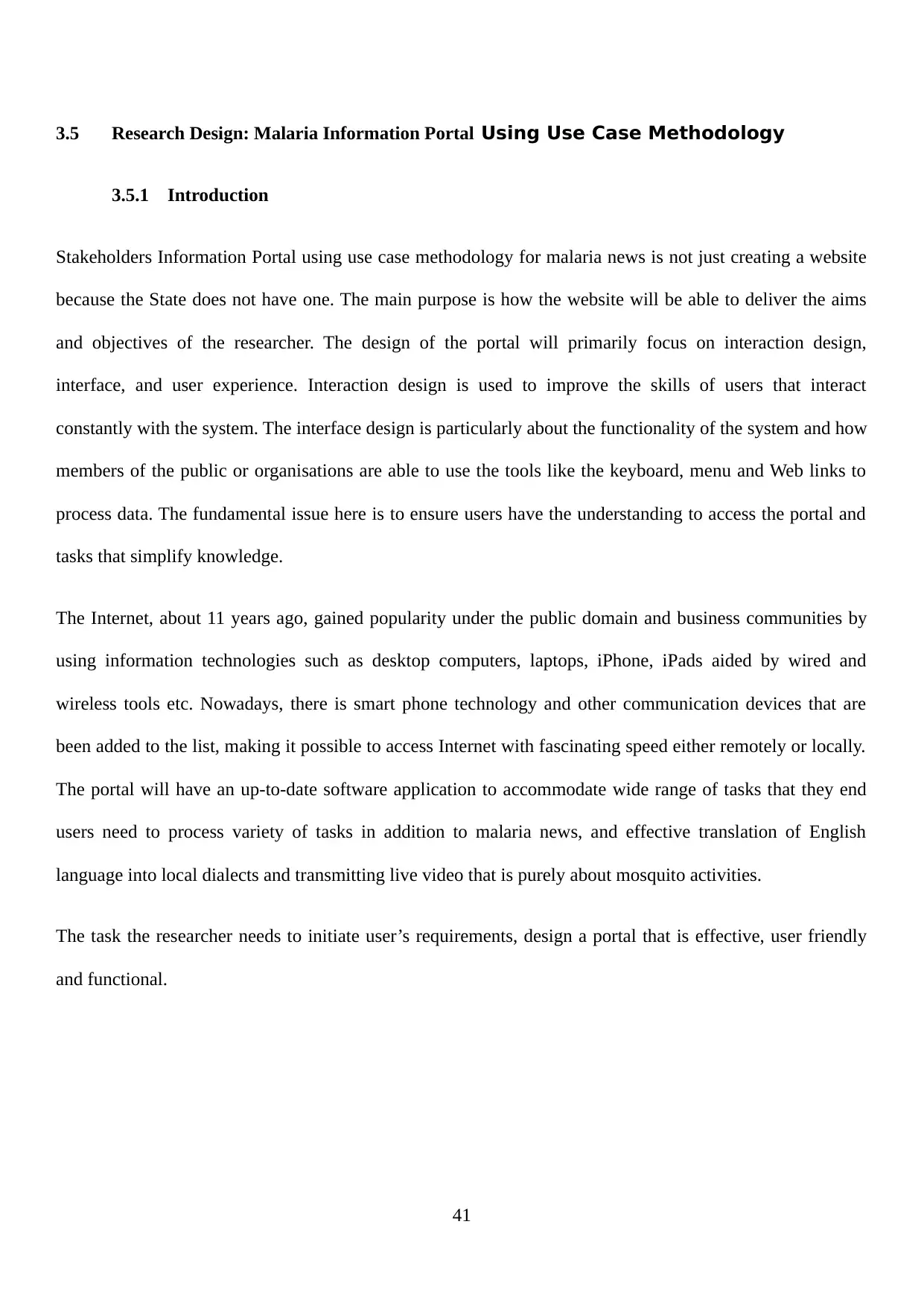
3.5.1 Introduction
Stakeholders Information Portal using use case methodology for malaria news is not just creating a website
because the State does not have one. The main purpose is how the website will be able to deliver the aims
and objectives of the researcher. The design of the portal will primarily focus on interaction design,
interface, and user experience. Interaction design is used to improve the skills of users that interact
constantly with the system. The interface design is particularly about the functionality of the system and how
members of the public or organisations are able to use the tools like the keyboard, menu and Web links to
process data. The fundamental issue here is to ensure users have the understanding to access the portal and
tasks that simplify knowledge.
The Internet, about 11 years ago, gained popularity under the public domain and business communities by
using information technologies such as desktop computers, laptops, iPhone, iPads aided by wired and
wireless tools etc. Nowadays, there is smart phone technology and other communication devices that are
been added to the list, making it possible to access Internet with fascinating speed either remotely or locally.
The portal will have an up-to-date software application to accommodate wide range of tasks that they end
users need to process variety of tasks in addition to malaria news, and effective translation of English
language into local dialects and transmitting live video that is purely about mosquito activities.
The task the researcher needs to initiate user’s requirements, design a portal that is effective, user friendly
and functional.
41
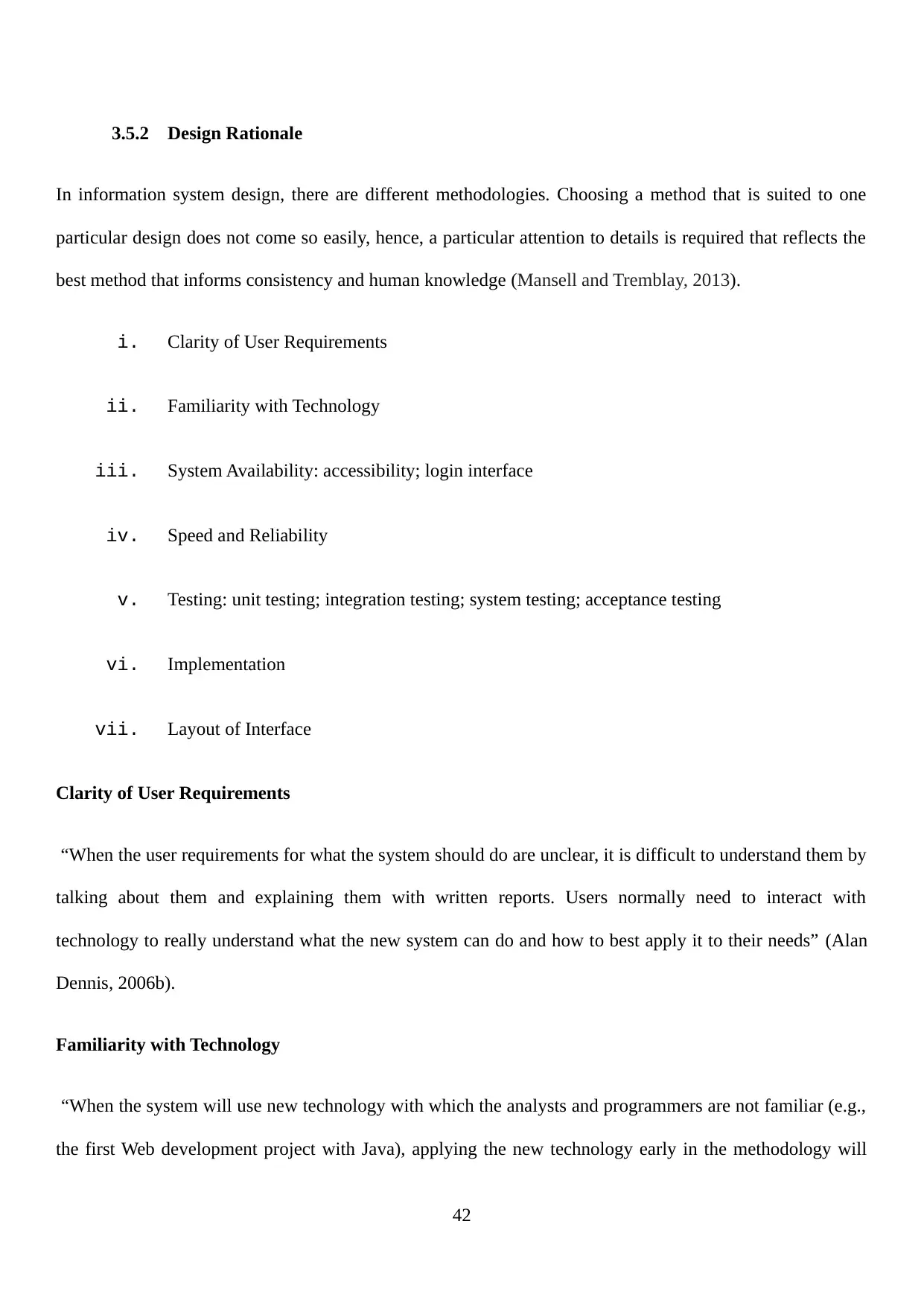
In information system design, there are different methodologies. Choosing a method that is suited to one
particular design does not come so easily, hence, a particular attention to details is required that reflects the
best method that informs consistency and human knowledge (Mansell and Tremblay, 2013).
i. Clarity of User Requirements
ii. Familiarity with Technology
iii. System Availability: accessibility; login interface
iv. Speed and Reliability
v. Testing: unit testing; integration testing; system testing; acceptance testing
vi. Implementation
vii. Layout of Interface
Clarity of User Requirements
“When the user requirements for what the system should do are unclear, it is difficult to understand them by
talking about them and explaining them with written reports. Users normally need to interact with
technology to really understand what the new system can do and how to best apply it to their needs” (Alan
Dennis, 2006b).
Familiarity with Technology
“When the system will use new technology with which the analysts and programmers are not familiar (e.g.,
the first Web development project with Java), applying the new technology early in the methodology will
42
⊘ This is a preview!⊘
Do you want full access?
Subscribe today to unlock all pages.

Trusted by 1+ million students worldwide
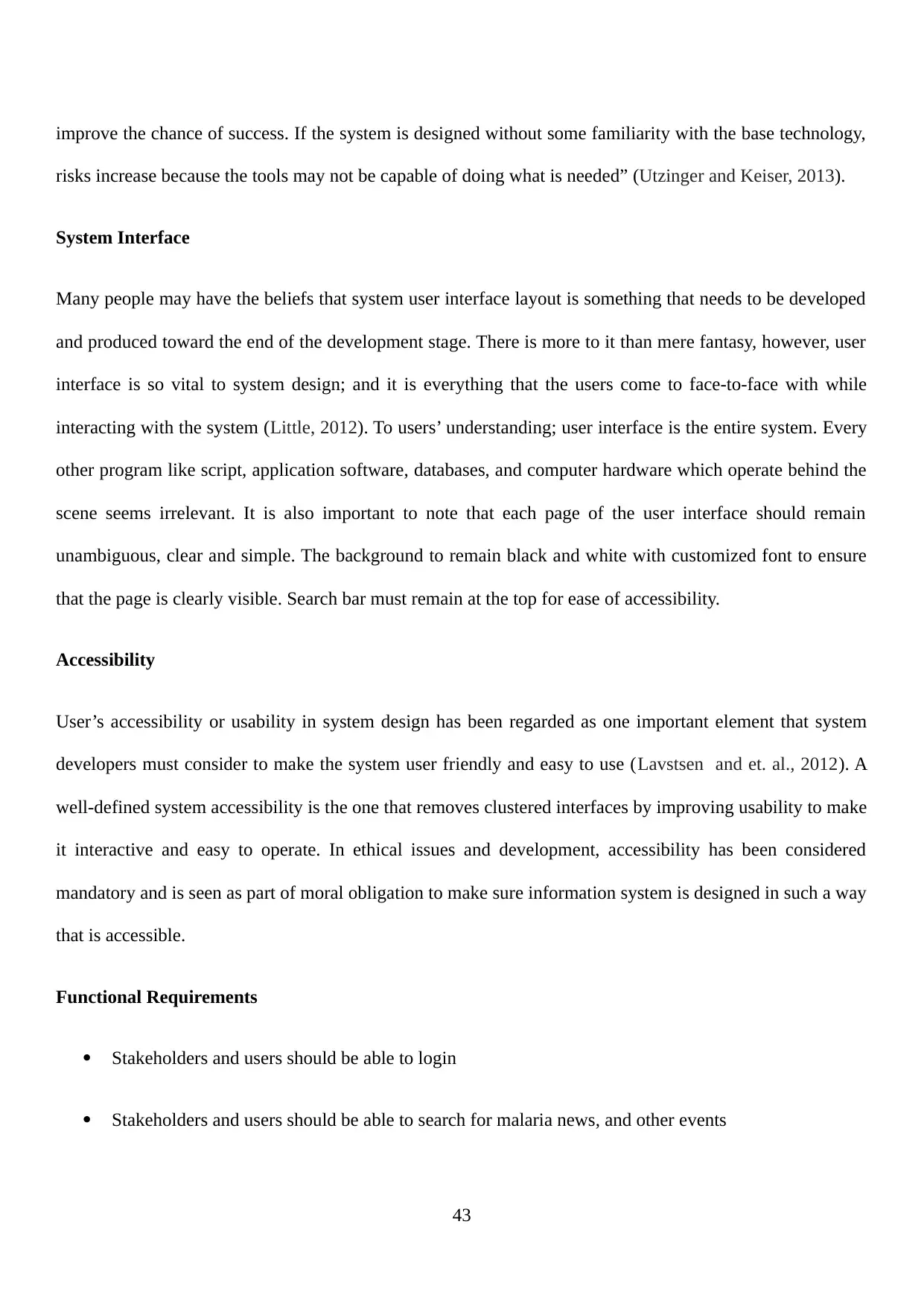
risks increase because the tools may not be capable of doing what is needed” (Utzinger and Keiser, 2013).
System Interface
Many people may have the beliefs that system user interface layout is something that needs to be developed
and produced toward the end of the development stage. There is more to it than mere fantasy, however, user
interface is so vital to system design; and it is everything that the users come to face-to-face with while
interacting with the system (Little, 2012). To users’ understanding; user interface is the entire system. Every
other program like script, application software, databases, and computer hardware which operate behind the
scene seems irrelevant. It is also important to note that each page of the user interface should remain
unambiguous, clear and simple. The background to remain black and white with customized font to ensure
that the page is clearly visible. Search bar must remain at the top for ease of accessibility.
Accessibility
User’s accessibility or usability in system design has been regarded as one important element that system
developers must consider to make the system user friendly and easy to use (Lavstsen and et. al., 2012). A
well-defined system accessibility is the one that removes clustered interfaces by improving usability to make
it interactive and easy to operate. In ethical issues and development, accessibility has been considered
mandatory and is seen as part of moral obligation to make sure information system is designed in such a way
that is accessible.
Functional Requirements
Stakeholders and users should be able to login
Stakeholders and users should be able to search for malaria news, and other events
43
Paraphrase This Document
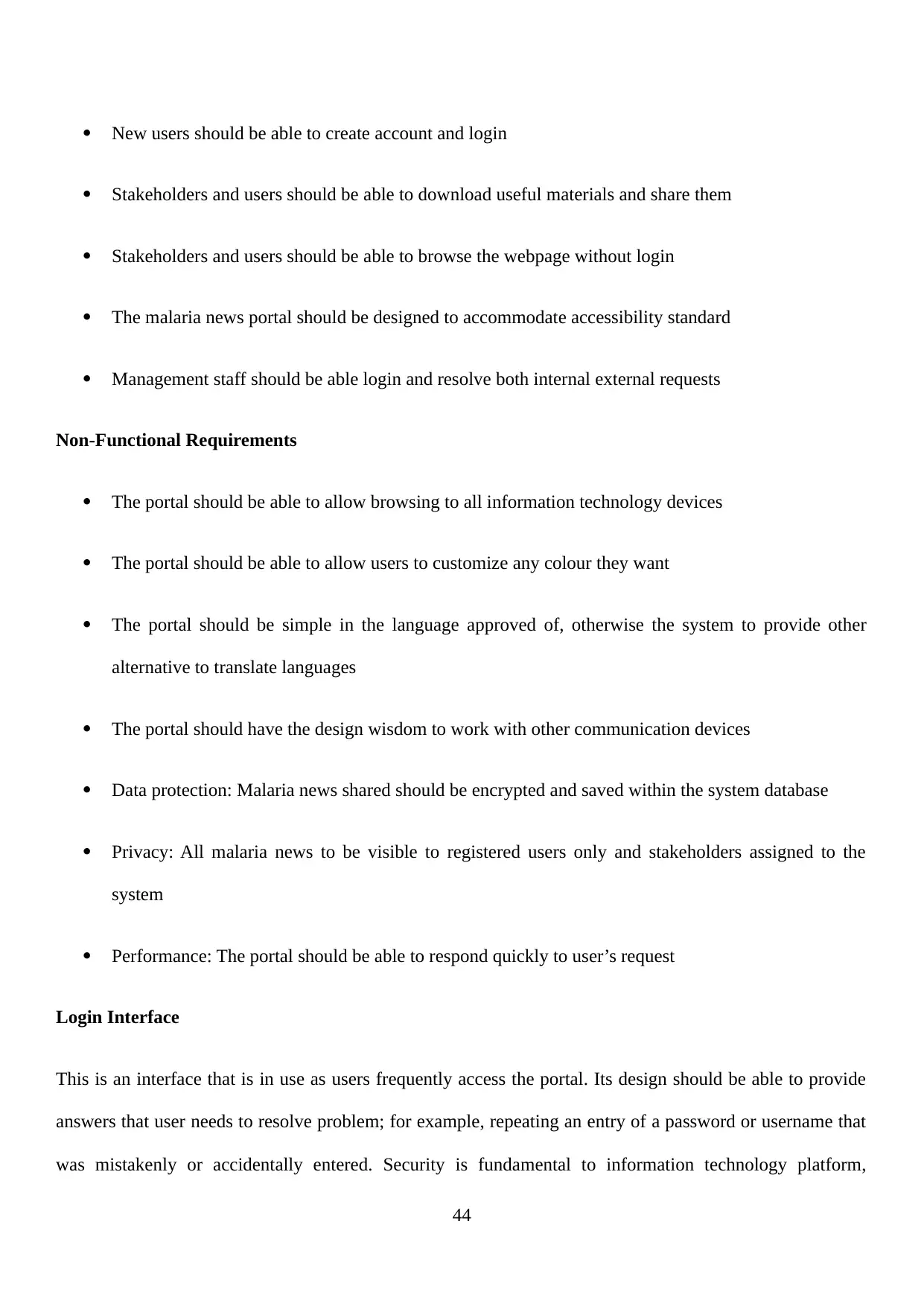
Stakeholders and users should be able to download useful materials and share them
Stakeholders and users should be able to browse the webpage without login
The malaria news portal should be designed to accommodate accessibility standard
Management staff should be able login and resolve both internal external requests
Non-Functional Requirements
The portal should be able to allow browsing to all information technology devices
The portal should be able to allow users to customize any colour they want
The portal should be simple in the language approved of, otherwise the system to provide other
alternative to translate languages
The portal should have the design wisdom to work with other communication devices
Data protection: Malaria news shared should be encrypted and saved within the system database
Privacy: All malaria news to be visible to registered users only and stakeholders assigned to the
system
Performance: The portal should be able to respond quickly to user’s request
Login Interface
This is an interface that is in use as users frequently access the portal. Its design should be able to provide
answers that user needs to resolve problem; for example, repeating an entry of a password or username that
was mistakenly or accidentally entered. Security is fundamental to information technology platform,
44
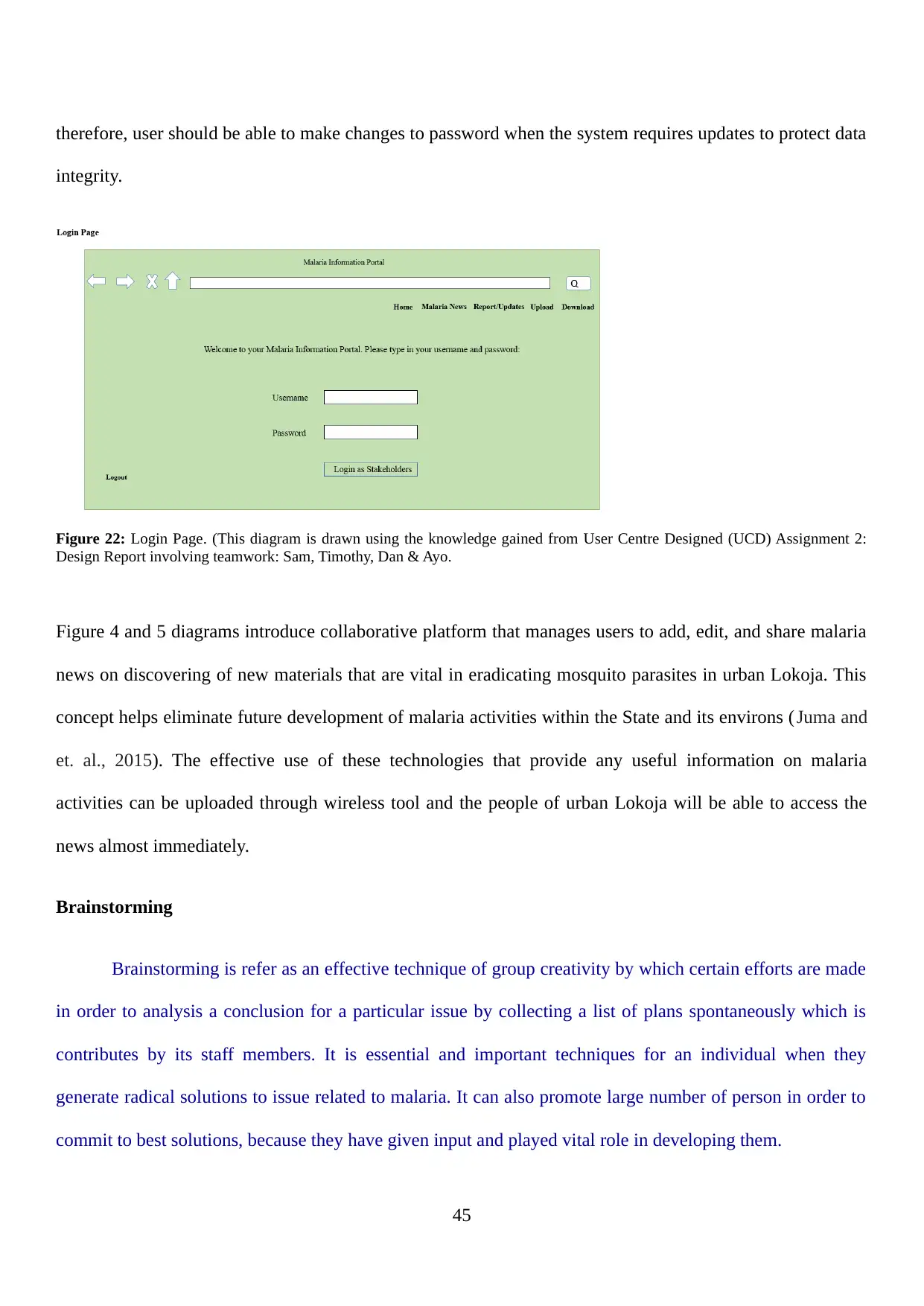
integrity.
Figure 22: Login Page. (This diagram is drawn using the knowledge gained from User Centre Designed (UCD) Assignment 2:
Design Report involving teamwork: Sam, Timothy, Dan & Ayo.
Figure 4 and 5 diagrams introduce collaborative platform that manages users to add, edit, and share malaria
news on discovering of new materials that are vital in eradicating mosquito parasites in urban Lokoja. This
concept helps eliminate future development of malaria activities within the State and its environs (Juma and
et. al., 2015). The effective use of these technologies that provide any useful information on malaria
activities can be uploaded through wireless tool and the people of urban Lokoja will be able to access the
news almost immediately.
Brainstorming
Brainstorming is refer as an effective technique of group creativity by which certain efforts are made
in order to analysis a conclusion for a particular issue by collecting a list of plans spontaneously which is
contributes by its staff members. It is essential and important techniques for an individual when they
generate radical solutions to issue related to malaria. It can also promote large number of person in order to
commit to best solutions, because they have given input and played vital role in developing them.
45
⊘ This is a preview!⊘
Do you want full access?
Subscribe today to unlock all pages.

Trusted by 1+ million students worldwide
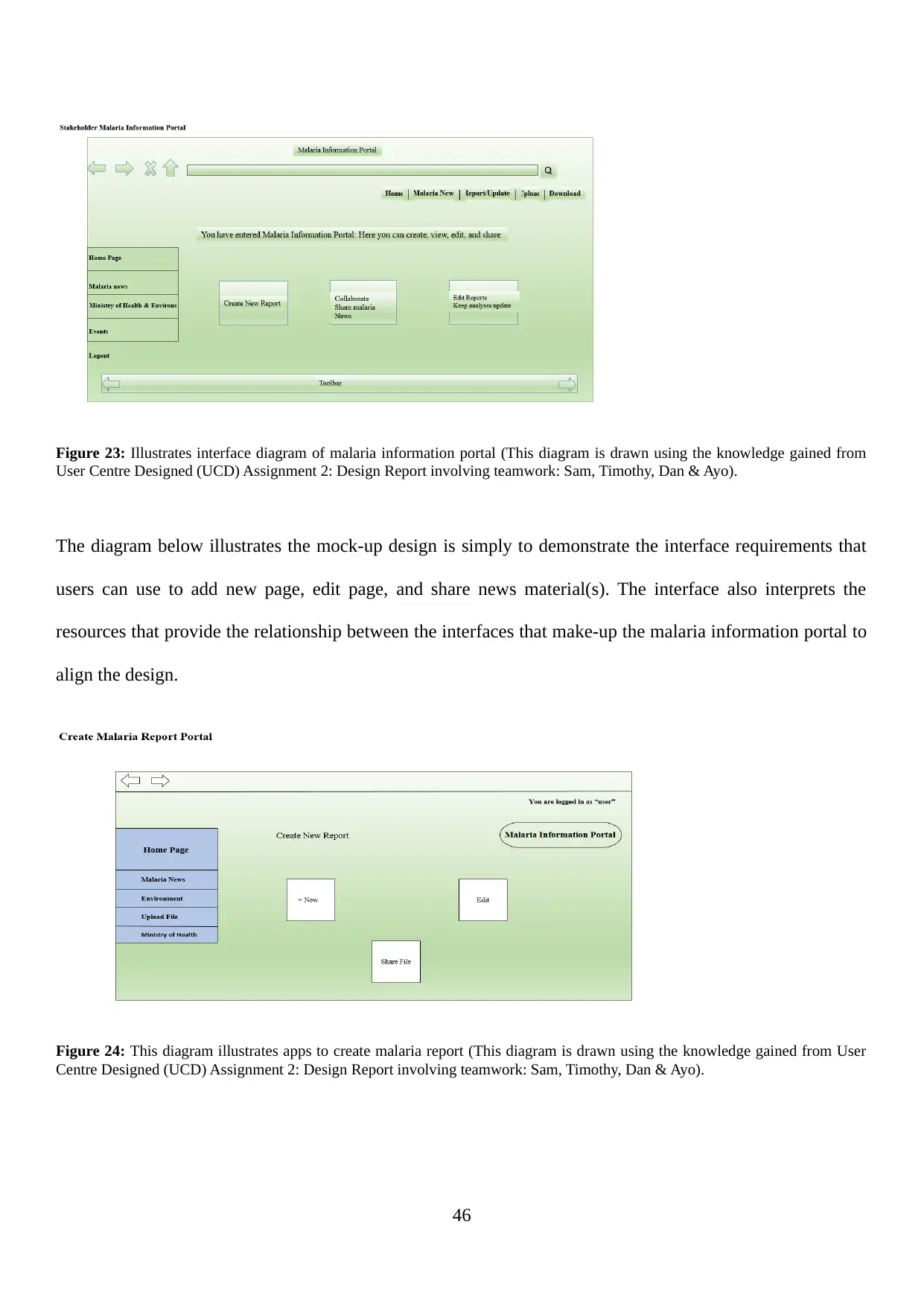
User Centre Designed (UCD) Assignment 2: Design Report involving teamwork: Sam, Timothy, Dan & Ayo).
The diagram below illustrates the mock-up design is simply to demonstrate the interface requirements that
users can use to add new page, edit page, and share news material(s). The interface also interprets the
resources that provide the relationship between the interfaces that make-up the malaria information portal to
align the design.
Figure 24: This diagram illustrates apps to create malaria report (This diagram is drawn using the knowledge gained from User
Centre Designed (UCD) Assignment 2: Design Report involving teamwork: Sam, Timothy, Dan & Ayo).
46
Paraphrase This Document
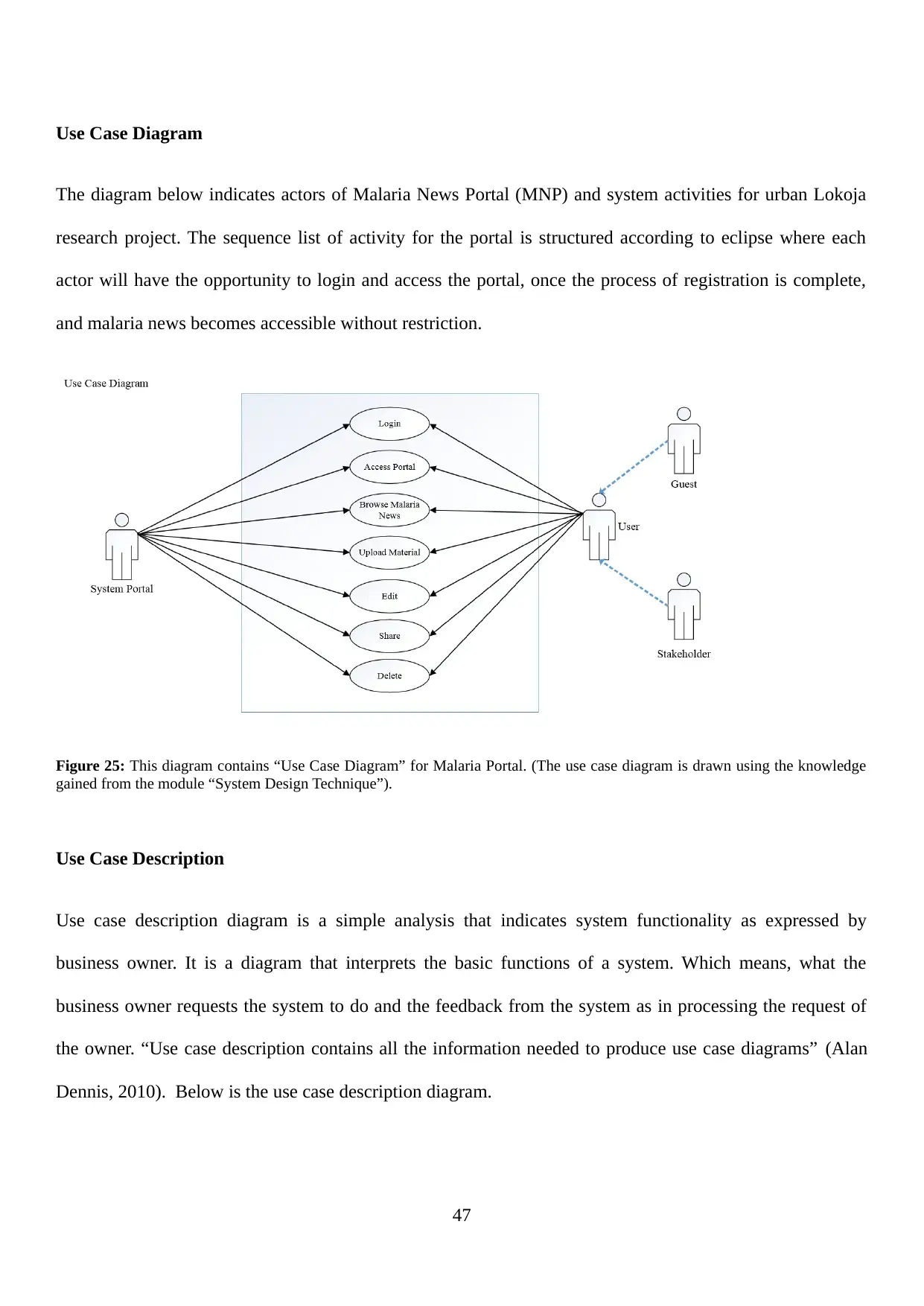
The diagram below indicates actors of Malaria News Portal (MNP) and system activities for urban Lokoja
research project. The sequence list of activity for the portal is structured according to eclipse where each
actor will have the opportunity to login and access the portal, once the process of registration is complete,
and malaria news becomes accessible without restriction.
Figure 25: This diagram contains “Use Case Diagram” for Malaria Portal. (The use case diagram is drawn using the knowledge
gained from the module “System Design Technique”).
Use Case Description
Use case description diagram is a simple analysis that indicates system functionality as expressed by
business owner. It is a diagram that interprets the basic functions of a system. Which means, what the
business owner requests the system to do and the feedback from the system as in processing the request of
the owner. “Use case description contains all the information needed to produce use case diagrams” (Alan
Dennis, 2010). Below is the use case description diagram.
47
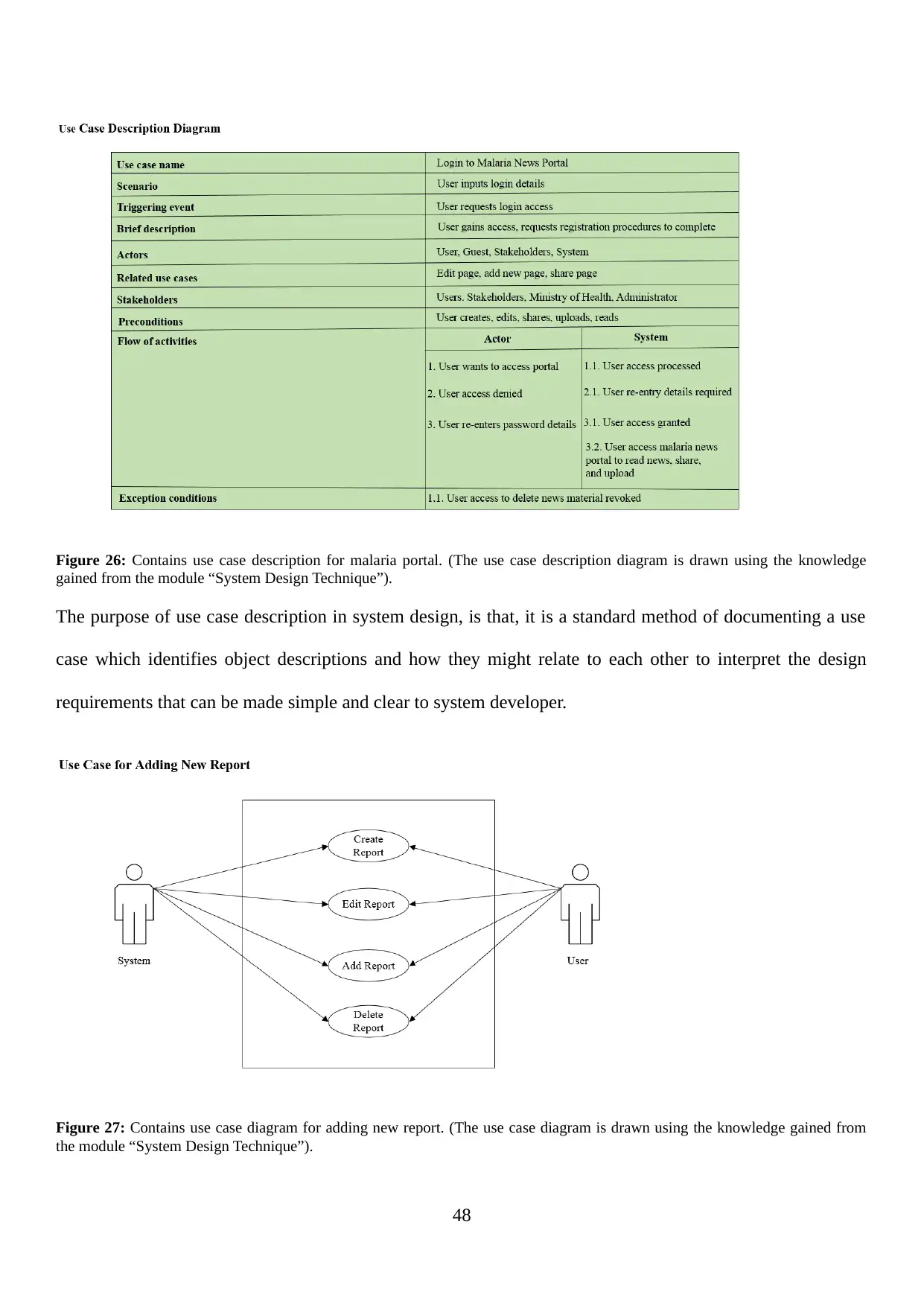
gained from the module “System Design Technique”).
The purpose of use case description in system design, is that, it is a standard method of documenting a use
case which identifies object descriptions and how they might relate to each other to interpret the design
requirements that can be made simple and clear to system developer.
Figure 27: Contains use case diagram for adding new report. (The use case diagram is drawn using the knowledge gained from
the module “System Design Technique”).
48
⊘ This is a preview!⊘
Do you want full access?
Subscribe today to unlock all pages.

Trusted by 1+ million students worldwide
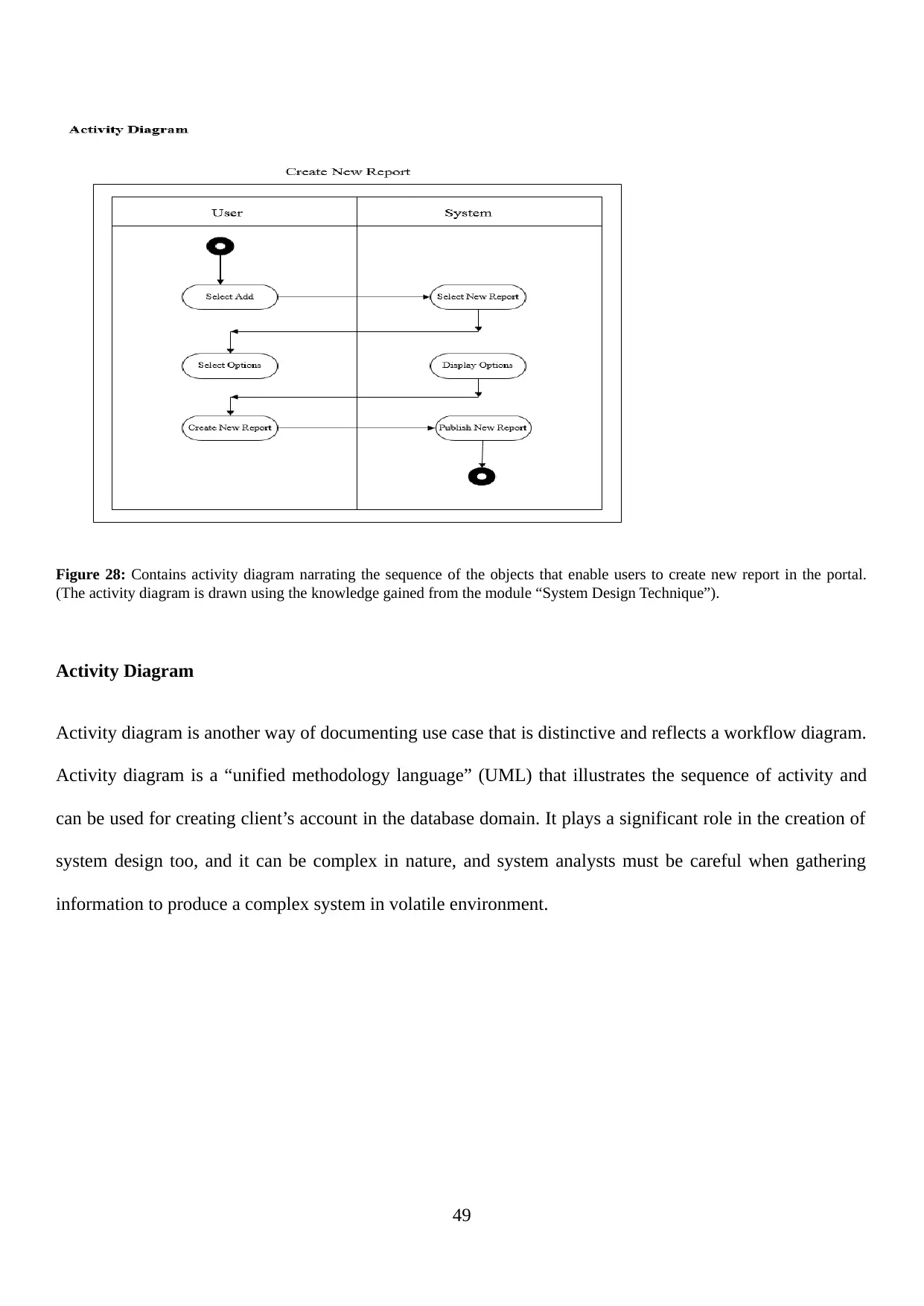
(The activity diagram is drawn using the knowledge gained from the module “System Design Technique”).
Activity Diagram
Activity diagram is another way of documenting use case that is distinctive and reflects a workflow diagram.
Activity diagram is a “unified methodology language” (UML) that illustrates the sequence of activity and
can be used for creating client’s account in the database domain. It plays a significant role in the creation of
system design too, and it can be complex in nature, and system analysts must be careful when gathering
information to produce a complex system in volatile environment.
49
Paraphrase This Document
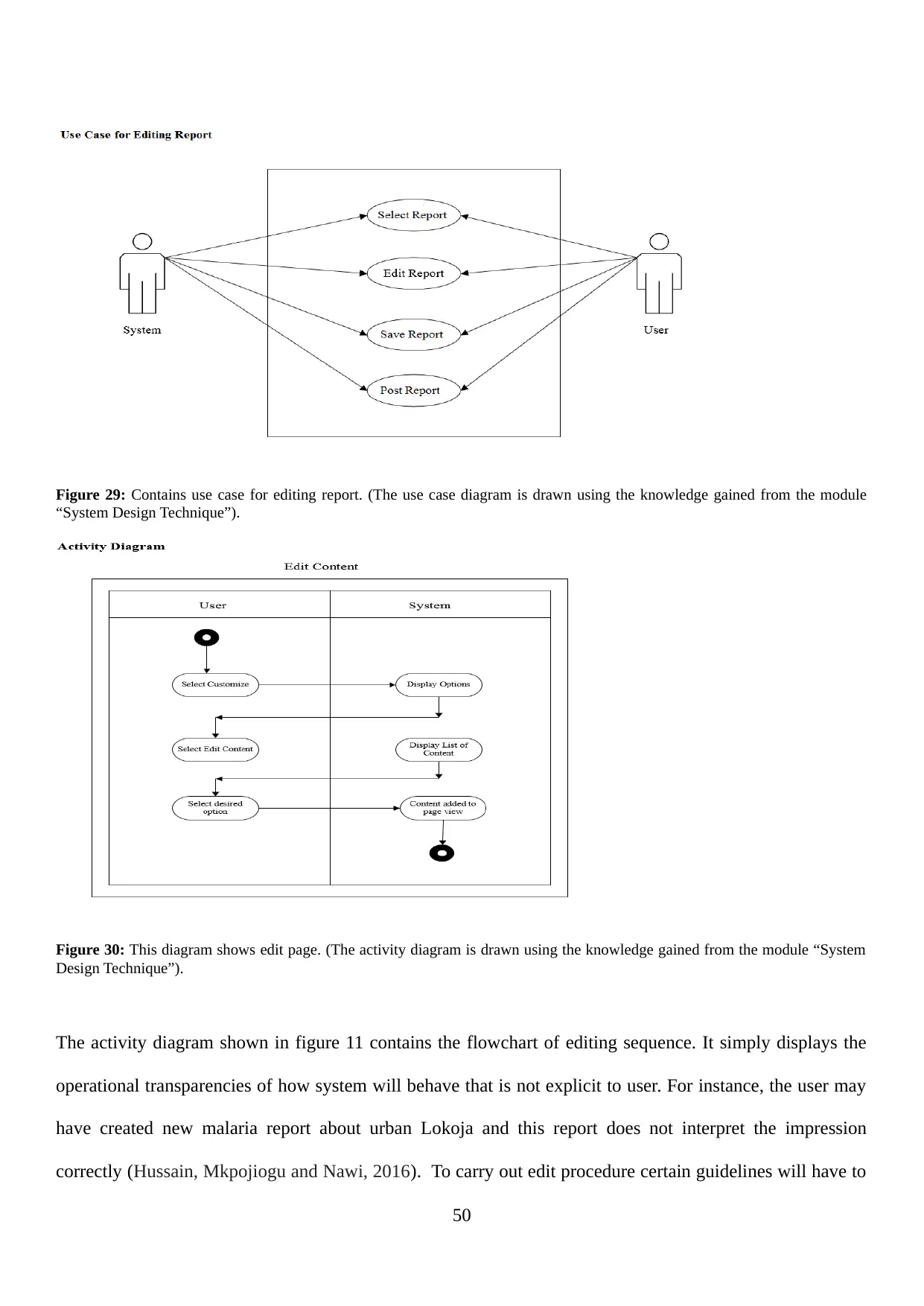
“System Design Technique”).
Figure 30: This diagram shows edit page. (The activity diagram is drawn using the knowledge gained from the module “System
Design Technique”).
The activity diagram shown in figure 11 contains the flowchart of editing sequence. It simply displays the
operational transparencies of how system will behave that is not explicit to user. For instance, the user may
have created new malaria report about urban Lokoja and this report does not interpret the impression
correctly (Hussain, Mkpojiogu and Nawi, 2016). To carry out edit procedure certain guidelines will have to
50
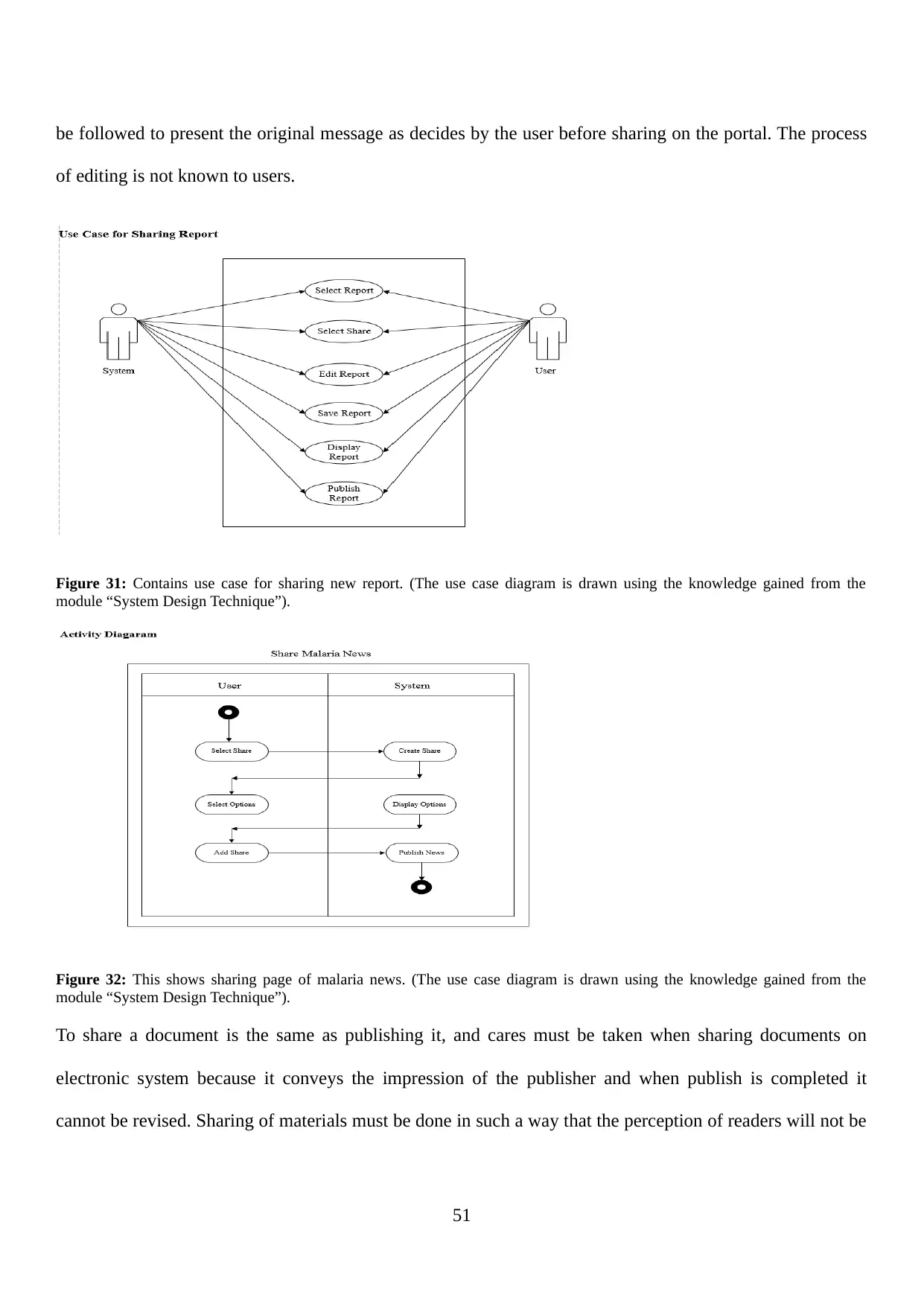
of editing is not known to users.
Figure 31: Contains use case for sharing new report. (The use case diagram is drawn using the knowledge gained from the
module “System Design Technique”).
Figure 32: This shows sharing page of malaria news. (The use case diagram is drawn using the knowledge gained from the
module “System Design Technique”).
To share a document is the same as publishing it, and cares must be taken when sharing documents on
electronic system because it conveys the impression of the publisher and when publish is completed it
cannot be revised. Sharing of materials must be done in such a way that the perception of readers will not be
51
⊘ This is a preview!⊘
Do you want full access?
Subscribe today to unlock all pages.

Trusted by 1+ million students worldwide

under which the message was represented (as in the case of malaria parasites) in urban Lokoja.
Figure 33: Contains sequence diagram. (The sequence diagram is drawn using the knowledge gained from the module “System
Design Technique”).
Sequence diagram operates at domain layer using logic method that implements business rules, procedures,
and processes that are aligned with business activities. Figure 14 indicates the abstract of how these five
categories work in tandem to respond to user’s request and processing of information. The unified method of
system design has been proved to system developers that the method is effective and is part of acceptable
standard approach to produce application software (Zanutto and et. al., 2016).
52
Paraphrase This Document
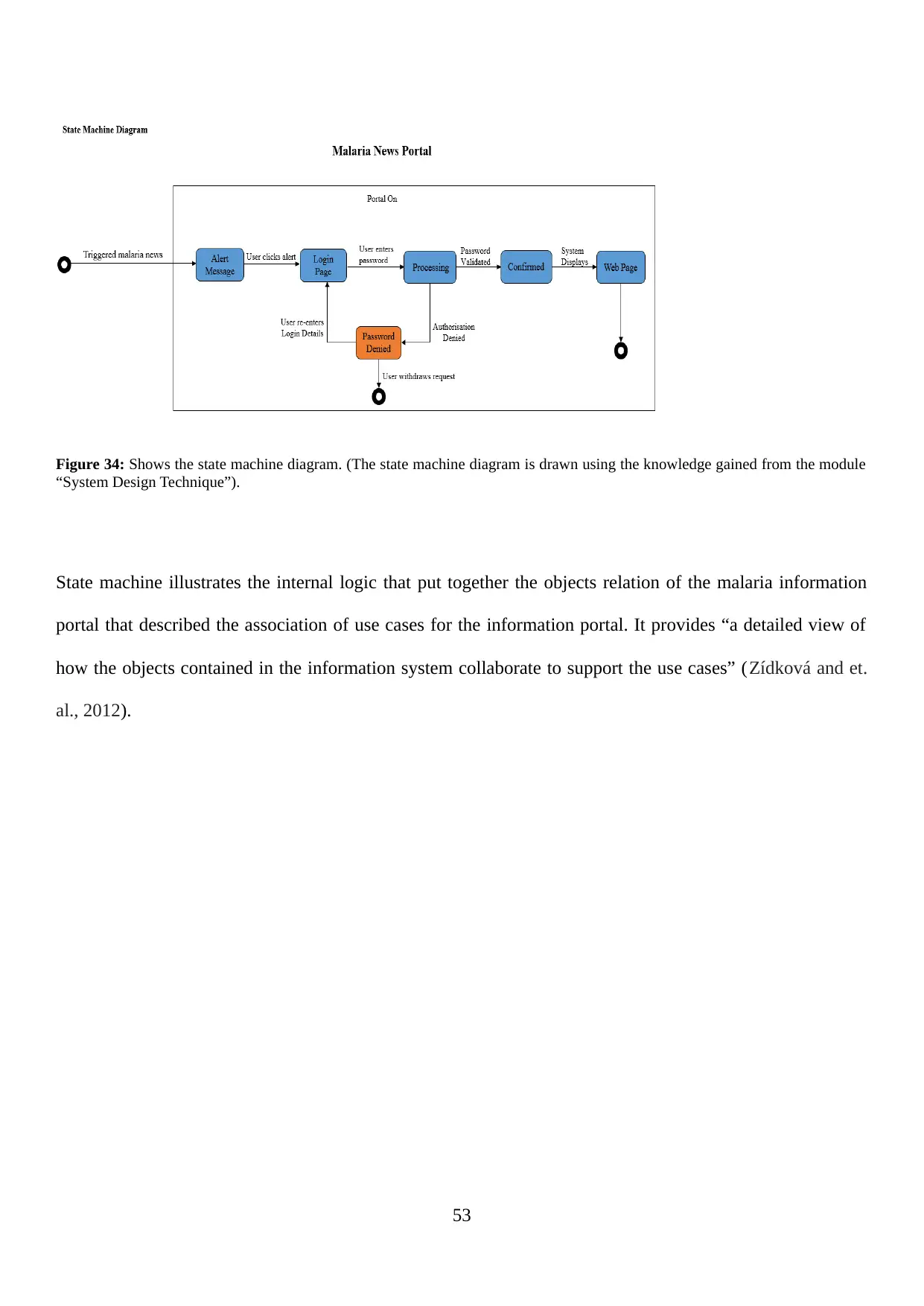
“System Design Technique”).
State machine illustrates the internal logic that put together the objects relation of the malaria information
portal that described the association of use cases for the information portal. It provides “a detailed view of
how the objects contained in the information system collaborate to support the use cases” (Zídková and et.
al., 2012).
53

from the module “System Design Technique”).
The above system class diagram contains the relationship of different entities that form the composition of
malaria information portal and as explained by (Baeza and et. al., 2013). “A class is a template on which
objects can be instantiated. An object is a person, place or thing about which we want to capture
information. Each object has attributes and methods. The methods are executed by objects sending
messages that trigger them. Encapsulation and information hiding allows an object to conceal its inner
process and data from the other objects. Polymorphism and dynamic binding allow a message to be
interpreted differently by different kinds of objects.”
54
⊘ This is a preview!⊘
Do you want full access?
Subscribe today to unlock all pages.

Trusted by 1+ million students worldwide
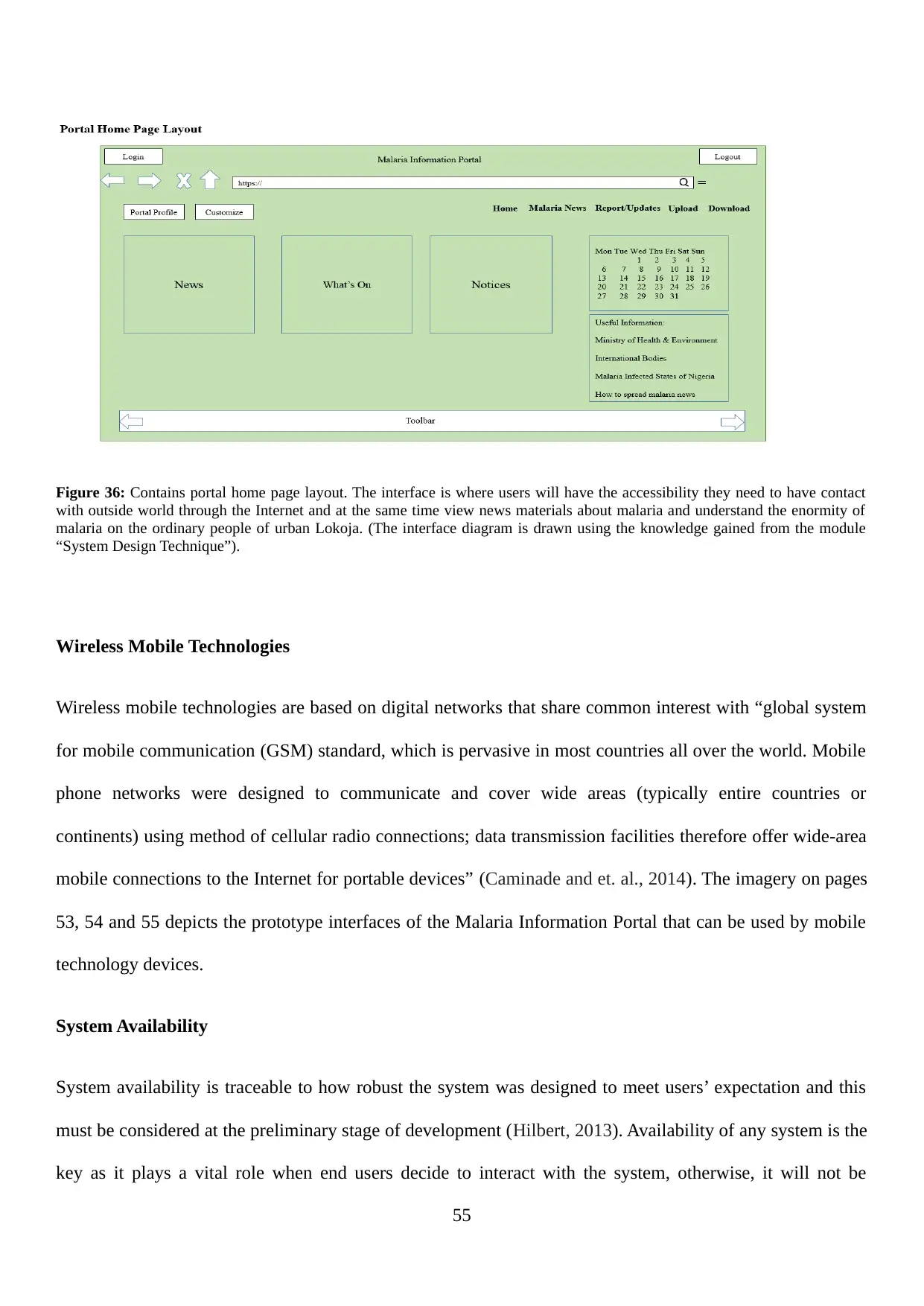
with outside world through the Internet and at the same time view news materials about malaria and understand the enormity of
malaria on the ordinary people of urban Lokoja. (The interface diagram is drawn using the knowledge gained from the module
“System Design Technique”).
Wireless Mobile Technologies
Wireless mobile technologies are based on digital networks that share common interest with “global system
for mobile communication (GSM) standard, which is pervasive in most countries all over the world. Mobile
phone networks were designed to communicate and cover wide areas (typically entire countries or
continents) using method of cellular radio connections; data transmission facilities therefore offer wide-area
mobile connections to the Internet for portable devices” (Caminade and et. al., 2014). The imagery on pages
53, 54 and 55 depicts the prototype interfaces of the Malaria Information Portal that can be used by mobile
technology devices.
System Availability
System availability is traceable to how robust the system was designed to meet users’ expectation and this
must be considered at the preliminary stage of development (Hilbert, 2013). Availability of any system is the
key as it plays a vital role when end users decide to interact with the system, otherwise, it will not be
55
Paraphrase This Document
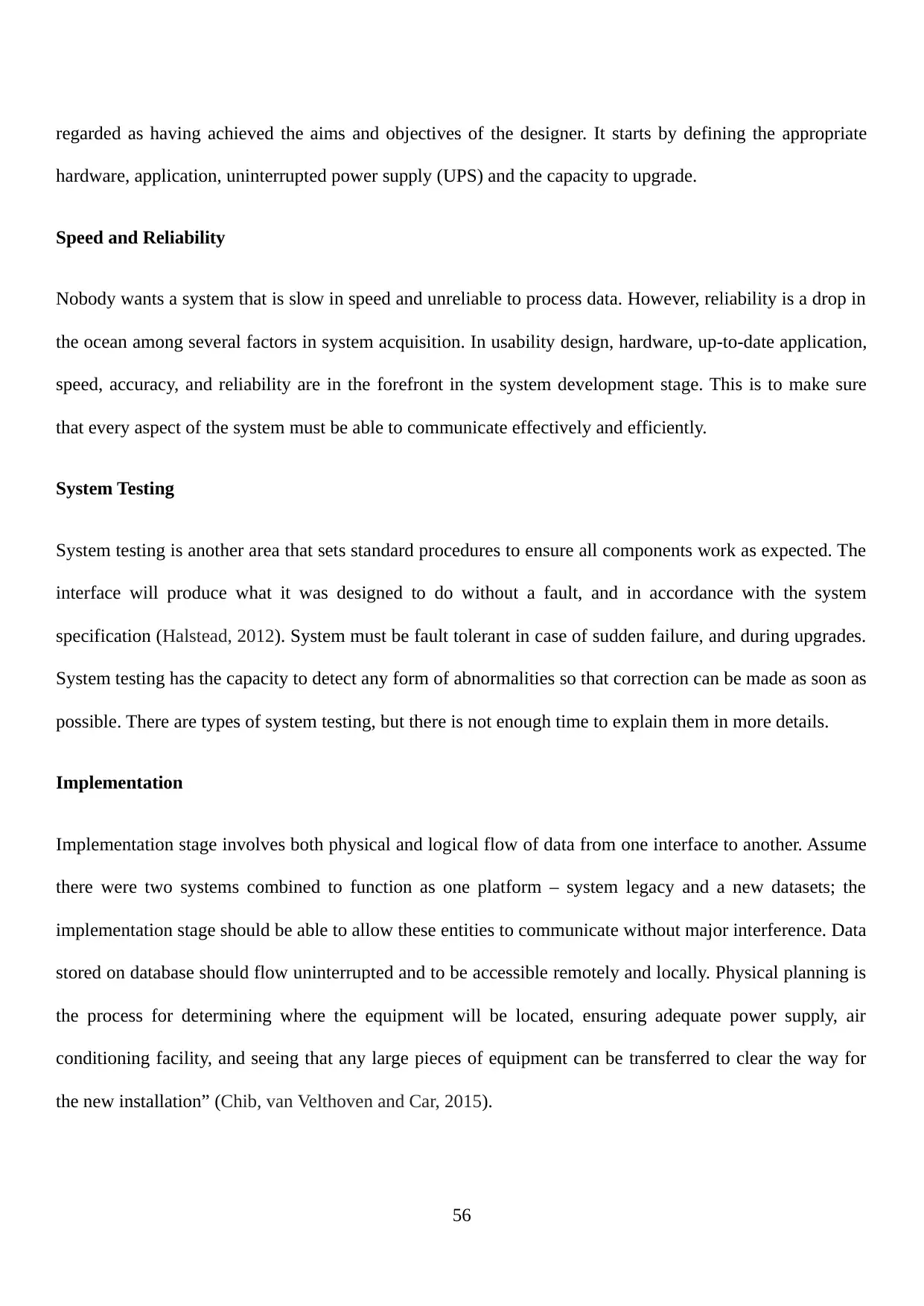
hardware, application, uninterrupted power supply (UPS) and the capacity to upgrade.
Speed and Reliability
Nobody wants a system that is slow in speed and unreliable to process data. However, reliability is a drop in
the ocean among several factors in system acquisition. In usability design, hardware, up-to-date application,
speed, accuracy, and reliability are in the forefront in the system development stage. This is to make sure
that every aspect of the system must be able to communicate effectively and efficiently.
System Testing
System testing is another area that sets standard procedures to ensure all components work as expected. The
interface will produce what it was designed to do without a fault, and in accordance with the system
specification (Halstead, 2012). System must be fault tolerant in case of sudden failure, and during upgrades.
System testing has the capacity to detect any form of abnormalities so that correction can be made as soon as
possible. There are types of system testing, but there is not enough time to explain them in more details.
Implementation
Implementation stage involves both physical and logical flow of data from one interface to another. Assume
there were two systems combined to function as one platform – system legacy and a new datasets; the
implementation stage should be able to allow these entities to communicate without major interference. Data
stored on database should flow uninterrupted and to be accessible remotely and locally. Physical planning is
the process for determining where the equipment will be located, ensuring adequate power supply, air
conditioning facility, and seeing that any large pieces of equipment can be transferred to clear the way for
the new installation” (Chib, van Velthoven and Car, 2015).
56
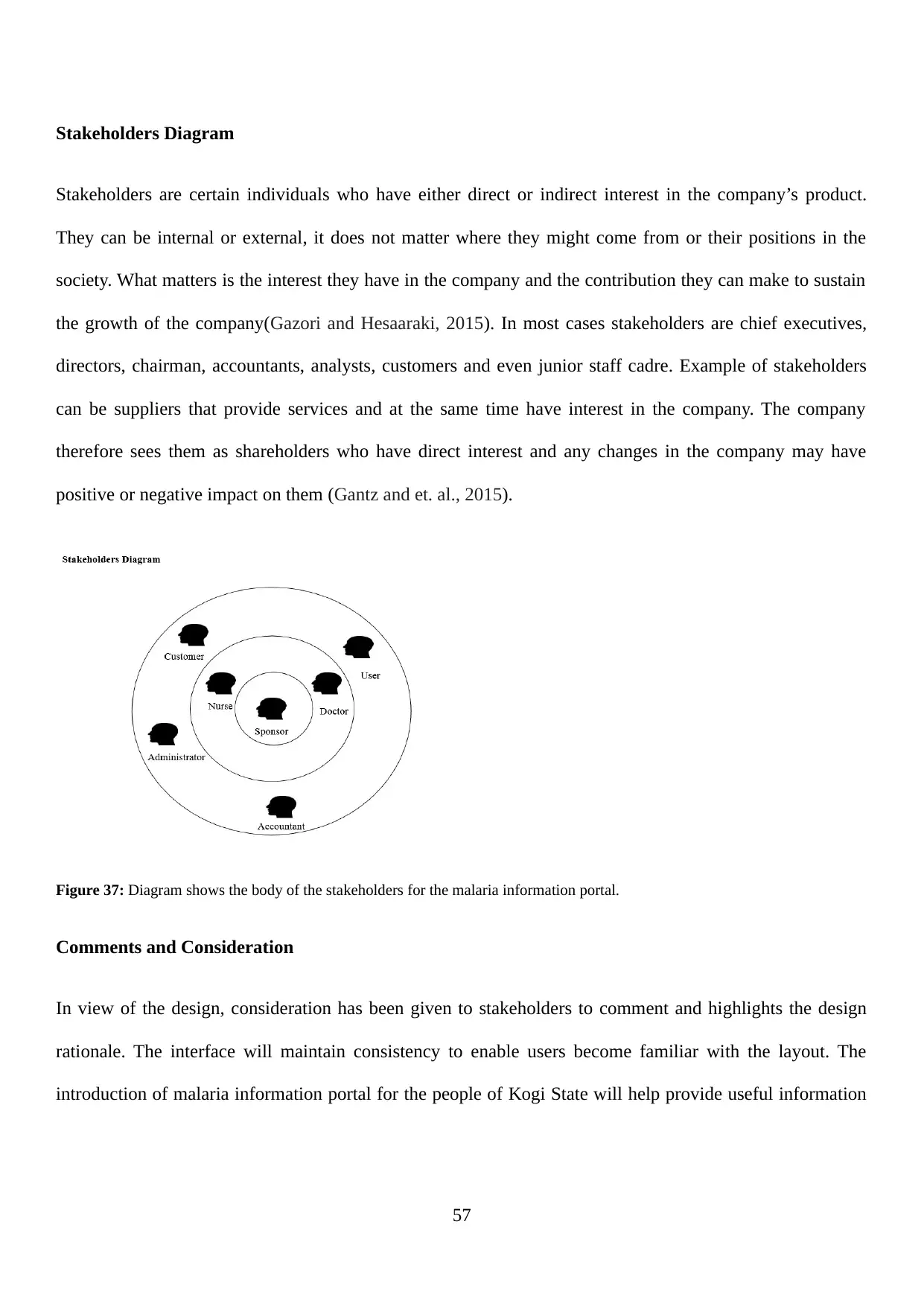
Stakeholders are certain individuals who have either direct or indirect interest in the company’s product.
They can be internal or external, it does not matter where they might come from or their positions in the
society. What matters is the interest they have in the company and the contribution they can make to sustain
the growth of the company(Gazori and Hesaaraki, 2015). In most cases stakeholders are chief executives,
directors, chairman, accountants, analysts, customers and even junior staff cadre. Example of stakeholders
can be suppliers that provide services and at the same time have interest in the company. The company
therefore sees them as shareholders who have direct interest and any changes in the company may have
positive or negative impact on them (Gantz and et. al., 2015).
Figure 37: Diagram shows the body of the stakeholders for the malaria information portal.
Comments and Consideration
In view of the design, consideration has been given to stakeholders to comment and highlights the design
rationale. The interface will maintain consistency to enable users become familiar with the layout. The
introduction of malaria information portal for the people of Kogi State will help provide useful information
57
⊘ This is a preview!⊘
Do you want full access?
Subscribe today to unlock all pages.

Trusted by 1+ million students worldwide
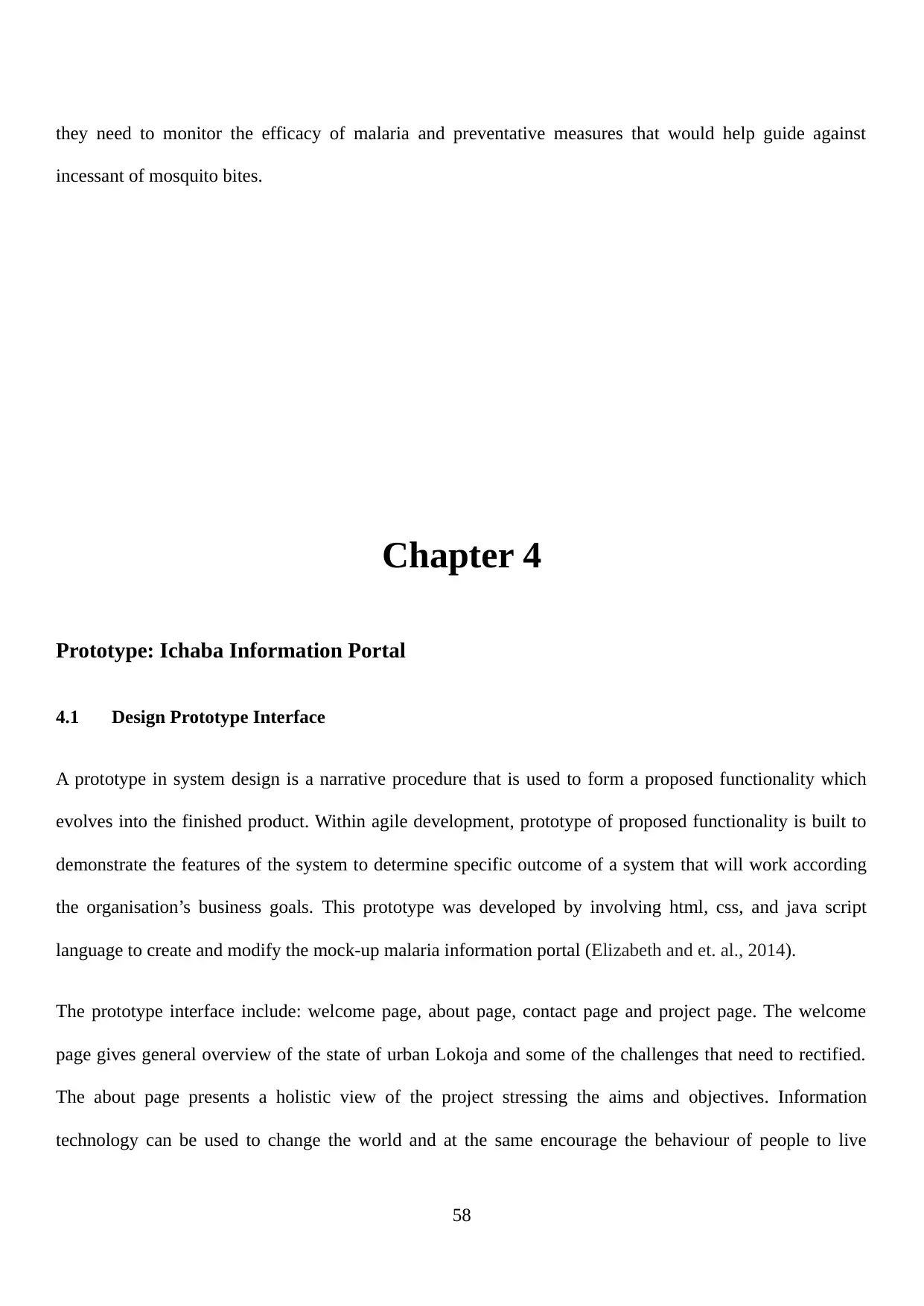
incessant of mosquito bites.
Chapter 4
Prototype: Ichaba Information Portal
4.1 Design Prototype Interface
A prototype in system design is a narrative procedure that is used to form a proposed functionality which
evolves into the finished product. Within agile development, prototype of proposed functionality is built to
demonstrate the features of the system to determine specific outcome of a system that will work according
the organisation’s business goals. This prototype was developed by involving html, css, and java script
language to create and modify the mock-up malaria information portal (Elizabeth and et. al., 2014).
The prototype interface include: welcome page, about page, contact page and project page. The welcome
page gives general overview of the state of urban Lokoja and some of the challenges that need to rectified.
The about page presents a holistic view of the project stressing the aims and objectives. Information
technology can be used to change the world and at the same encourage the behaviour of people to live
58
Paraphrase This Document
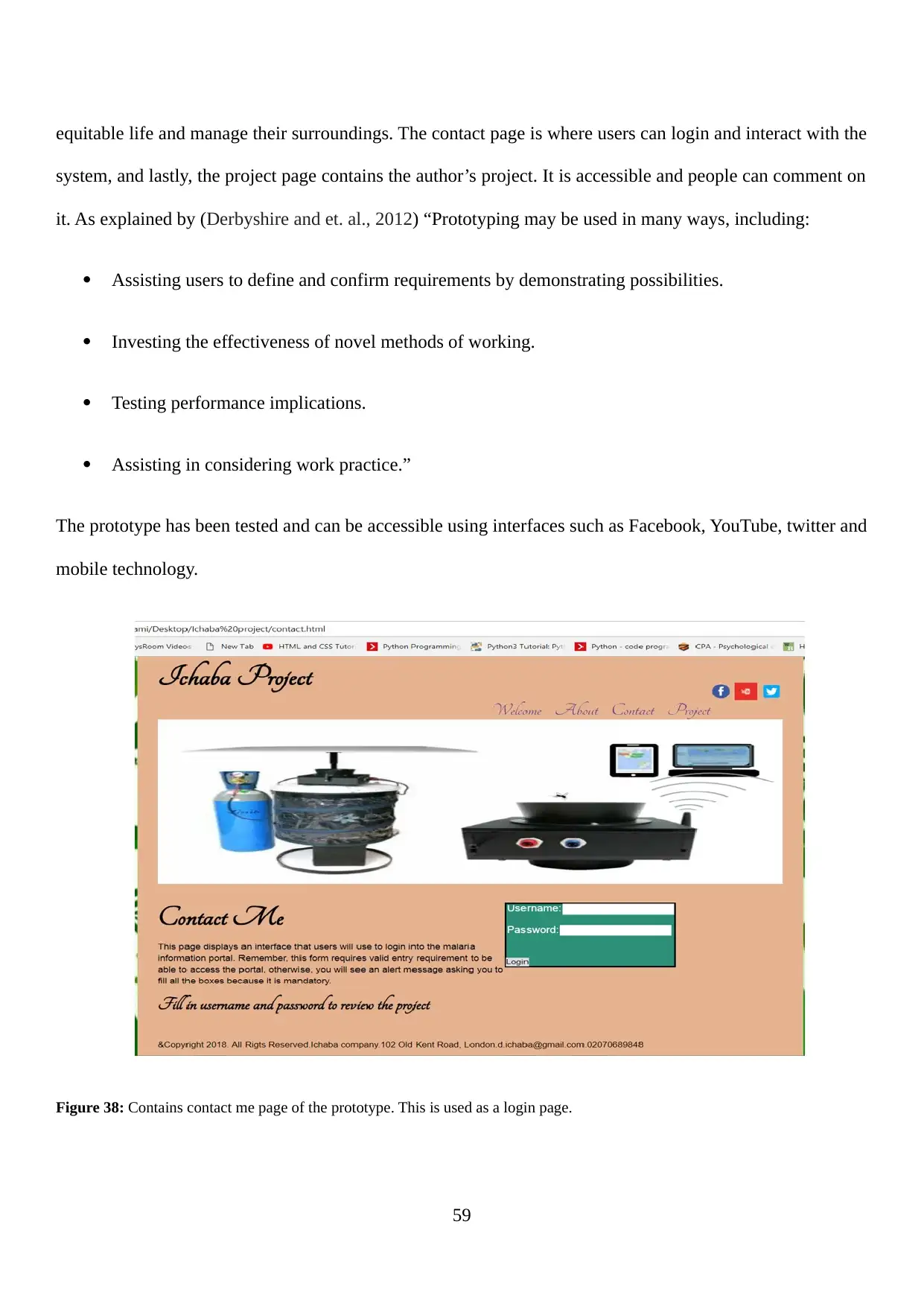
system, and lastly, the project page contains the author’s project. It is accessible and people can comment on
it. As explained by (Derbyshire and et. al., 2012) “Prototyping may be used in many ways, including:
Assisting users to define and confirm requirements by demonstrating possibilities.
Investing the effectiveness of novel methods of working.
Testing performance implications.
Assisting in considering work practice.”
The prototype has been tested and can be accessible using interfaces such as Facebook, YouTube, twitter and
mobile technology.
Figure 38: Contains contact me page of the prototype. This is used as a login page.
59
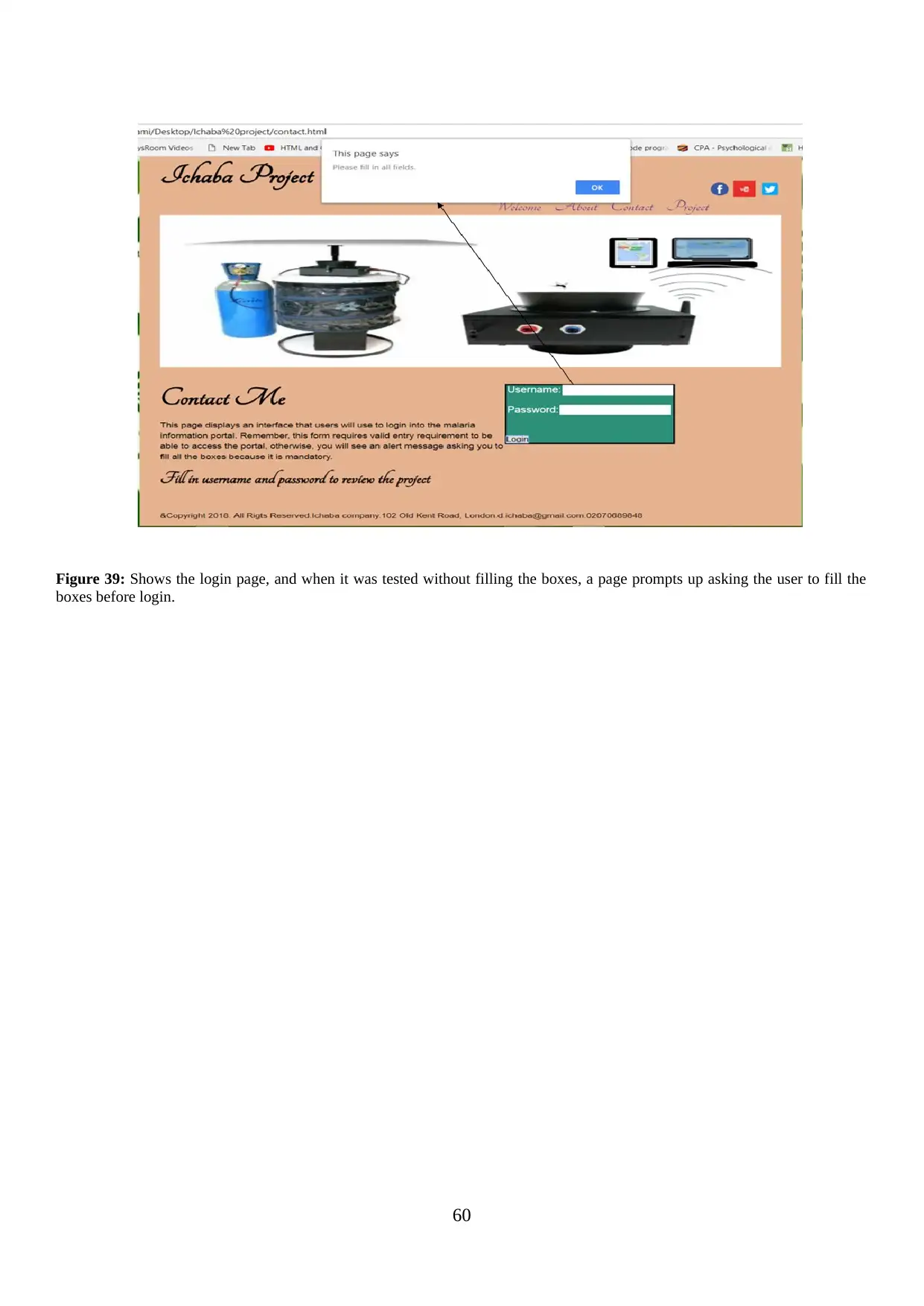
boxes before login.
60
⊘ This is a preview!⊘
Do you want full access?
Subscribe today to unlock all pages.

Trusted by 1+ million students worldwide

the mosquito feeding on its victim, and the above photo indicates a staff analysing data sent through wireless platform.
61
Paraphrase This Document
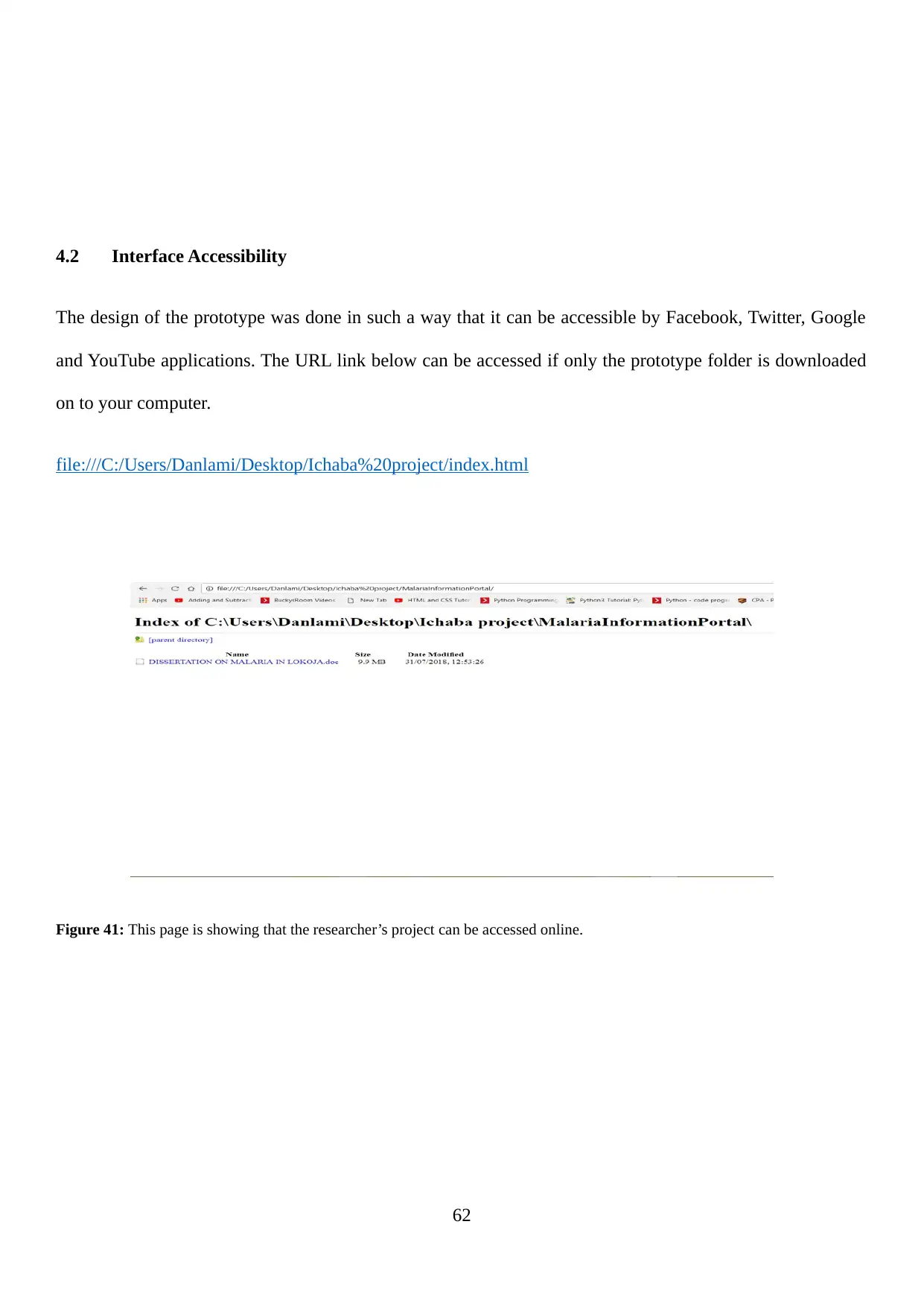
The design of the prototype was done in such a way that it can be accessible by Facebook, Twitter, Google
and YouTube applications. The URL link below can be accessed if only the prototype folder is downloaded
on to your computer.
file:///C:/Users/Danlami/Desktop/Ichaba%20project/index.html
Figure 41: This page is showing that the researcher’s project can be accessed online.
62
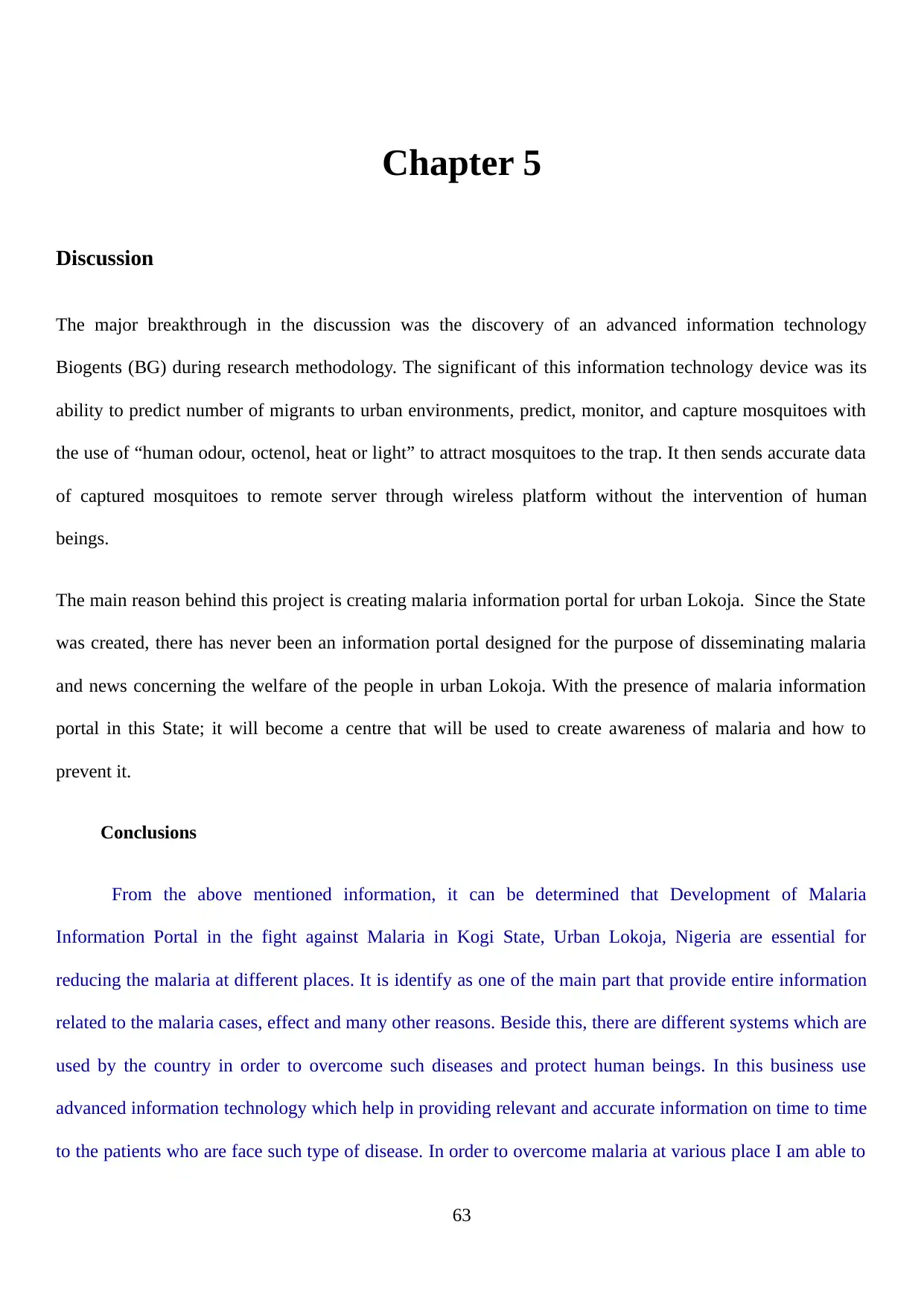
Discussion
The major breakthrough in the discussion was the discovery of an advanced information technology
Biogents (BG) during research methodology. The significant of this information technology device was its
ability to predict number of migrants to urban environments, predict, monitor, and capture mosquitoes with
the use of “human odour, octenol, heat or light” to attract mosquitoes to the trap. It then sends accurate data
of captured mosquitoes to remote server through wireless platform without the intervention of human
beings.
The main reason behind this project is creating malaria information portal for urban Lokoja. Since the State
was created, there has never been an information portal designed for the purpose of disseminating malaria
and news concerning the welfare of the people in urban Lokoja. With the presence of malaria information
portal in this State; it will become a centre that will be used to create awareness of malaria and how to
prevent it.
Conclusions
From the above mentioned information, it can be determined that Development of Malaria
Information Portal in the fight against Malaria in Kogi State, Urban Lokoja, Nigeria are essential for
reducing the malaria at different places. It is identify as one of the main part that provide entire information
related to the malaria cases, effect and many other reasons. Beside this, there are different systems which are
used by the country in order to overcome such diseases and protect human beings. In this business use
advanced information technology which help in providing relevant and accurate information on time to time
to the patients who are face such type of disease. In order to overcome malaria at various place I am able to
63
⊘ This is a preview!⊘
Do you want full access?
Subscribe today to unlock all pages.

Trusted by 1+ million students worldwide
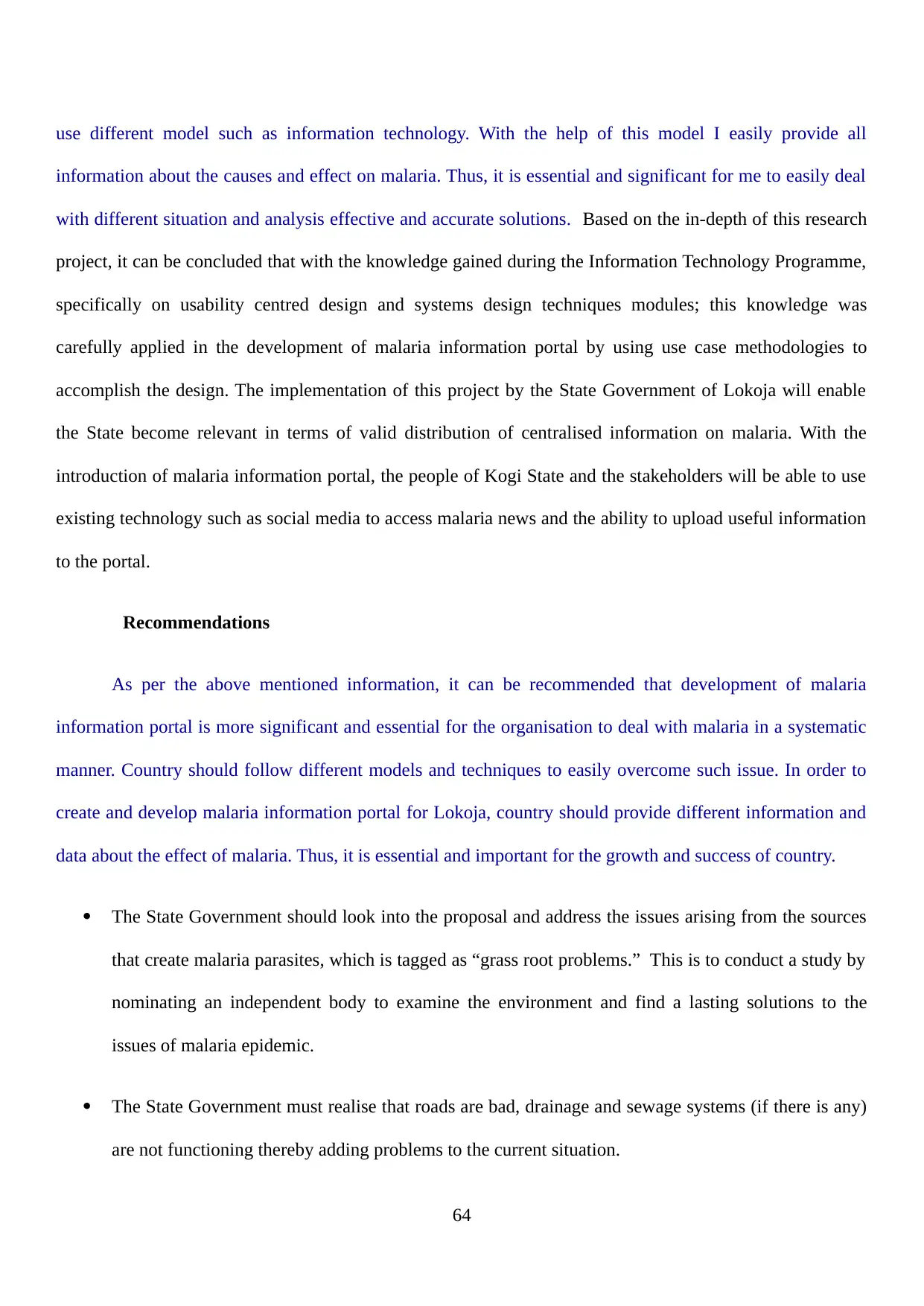
information about the causes and effect on malaria. Thus, it is essential and significant for me to easily deal
with different situation and analysis effective and accurate solutions. Based on the in-depth of this research
project, it can be concluded that with the knowledge gained during the Information Technology Programme,
specifically on usability centred design and systems design techniques modules; this knowledge was
carefully applied in the development of malaria information portal by using use case methodologies to
accomplish the design. The implementation of this project by the State Government of Lokoja will enable
the State become relevant in terms of valid distribution of centralised information on malaria. With the
introduction of malaria information portal, the people of Kogi State and the stakeholders will be able to use
existing technology such as social media to access malaria news and the ability to upload useful information
to the portal.
Recommendations
As per the above mentioned information, it can be recommended that development of malaria
information portal is more significant and essential for the organisation to deal with malaria in a systematic
manner. Country should follow different models and techniques to easily overcome such issue. In order to
create and develop malaria information portal for Lokoja, country should provide different information and
data about the effect of malaria. Thus, it is essential and important for the growth and success of country.
The State Government should look into the proposal and address the issues arising from the sources
that create malaria parasites, which is tagged as “grass root problems.” This is to conduct a study by
nominating an independent body to examine the environment and find a lasting solutions to the
issues of malaria epidemic.
The State Government must realise that roads are bad, drainage and sewage systems (if there is any)
are not functioning thereby adding problems to the current situation.
64
Paraphrase This Document
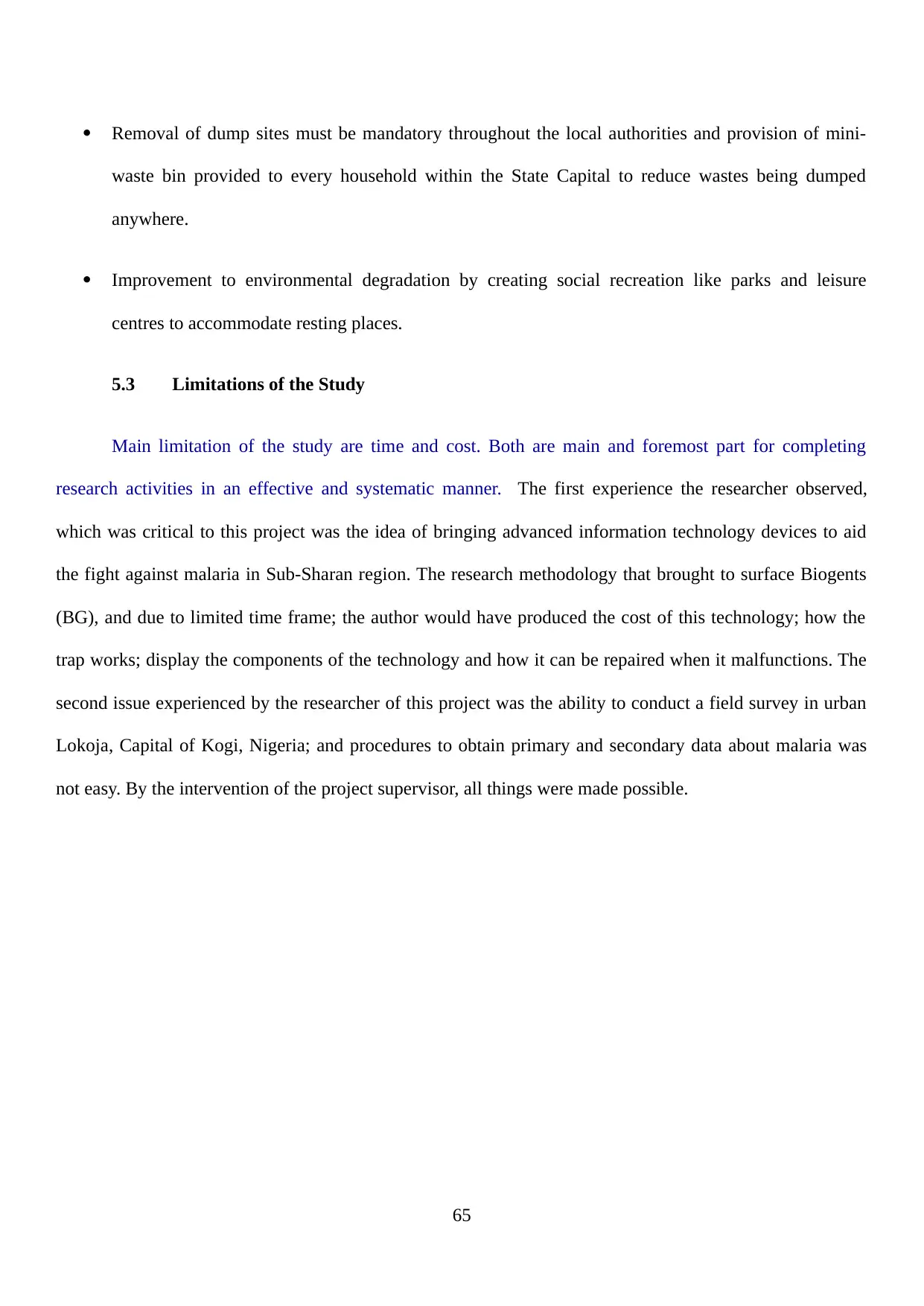
waste bin provided to every household within the State Capital to reduce wastes being dumped
anywhere.
Improvement to environmental degradation by creating social recreation like parks and leisure
centres to accommodate resting places.
5.3 Limitations of the Study
Main limitation of the study are time and cost. Both are main and foremost part for completing
research activities in an effective and systematic manner. The first experience the researcher observed,
which was critical to this project was the idea of bringing advanced information technology devices to aid
the fight against malaria in Sub-Sharan region. The research methodology that brought to surface Biogents
(BG), and due to limited time frame; the author would have produced the cost of this technology; how the
trap works; display the components of the technology and how it can be repaired when it malfunctions. The
second issue experienced by the researcher of this project was the ability to conduct a field survey in urban
Lokoja, Capital of Kogi, Nigeria; and procedures to obtain primary and secondary data about malaria was
not easy. By the intervention of the project supervisor, all things were made possible.
65

Books and Journals
Adebayo, A. S. and Anumudu, C. I., 2013. Annotation of virulence factors in schistosomes for the
development of a SchistoVir database. Journal of Computational Biology and Bioinformatics
Research. 5(1). pp.6-14.
Alavian, S. M., 2013. Malaria is one of the most common and serious infectious diseases in the tropics and
subtropics. For high-risk travelers to endemic regions, malaria chemoprophylaxis is recommended.
Internationally, atovaquone–proguanil (A/P), mefloquine (MEF), or doxycycline (DOX) are the
prescribed malaria chemoprophylactic drugs. However, A/P and DOX are not approved in Japan.
Therefore, the data on A/P for malaria... Journal of Infection and Chemotherapy. 19(1). pp.166-170.
Aoyama, T. and et. al., 2017. Spleen-derived lipocalin-2 in the portal vein regulates Kupffer cells activation
and attenuates the development of liver fibrosis in mice. Laboratory Investigation. 97(8). p.890.
Ceccato, P. and et. al., 2014. Improving decision-making activities for meningitis and malaria. Geocarto
International. 29(1). pp.19-38.
Danis, K. and et. al., 2013. Malaria in Greece: historical and current reflections on a re-emerging vector
borne disease. Travel Medicine and Infectious Disease. 11(1). pp.8-14.
Del Corral, J. and et. al., 2012. Climate information for public health: the role of the IRI climate data library
in an integrated knowledge system. Geospatial Health. 6(3). pp.S15-S24.
Estevez, E. and Montoya, M. S. R., 2015. Analyzing the Impact of Information and Communication
Technology for Development: Lessons Learnt from the SIRCA II Program. The Electronic Journal
of Information Systems in Developing Countries. 69(1). pp.1-17.
Graves, P. and et. al., 2018. Gametocytocidal drugs: taking the population perspective. The Lancet Infectious
Diseases. 18(7). p.719.
Grove, J. and et. al., 2015. Maternal, newborn, and child health and the Sustainable Development Goals—a
call for sustained and improved measurement. The Lancet. 386(10003). pp.1511-1514.
Hansen, J. R., 2015. New publication: Causes of Fever in Rural Southern Laos.
Kesselheim, A. S., Maggs, L. R. and Sarpatwari, A., 2015. Experience with the priority review voucher
program for drug development. Jama. 314(16). pp.1687-1688.
Kirby, T., 2015. Alan Magill—aiming for a malaria-free world. The Lancet Infectious Diseases. 15(8).
p.888.
Kirby, T., 2016. Brendan Crabb—making research work for development. The Lancet. 387(10021). p.839.
⊘ This is a preview!⊘
Do you want full access?
Subscribe today to unlock all pages.

Trusted by 1+ million students worldwide
Your All-in-One AI-Powered Toolkit for Academic Success.
+13062052269
info@desklib.com
Available 24*7 on WhatsApp / Email
![[object Object]](/_next/static/media/star-bottom.7253800d.svg)
© 2024 | Zucol Services PVT LTD | All rights reserved.